============================================================================================================
JFK REVELATIONS . . ... JFK INSIGHTS . . . ... AN EPIPHANY OF TRUTH . . . ....
================================== UPDATED ON 06/26/2016 =========================================
Jack Kennedy
Half A Century of Images…
50 Years Later . . . .…
LIFE
John F. Kennedy - 50 Years Later…
[ΞΞΞΞΞΞΞΞΞΞΞΞΞΞΞΞΞΞΞΞΞΞΞΞΞ]
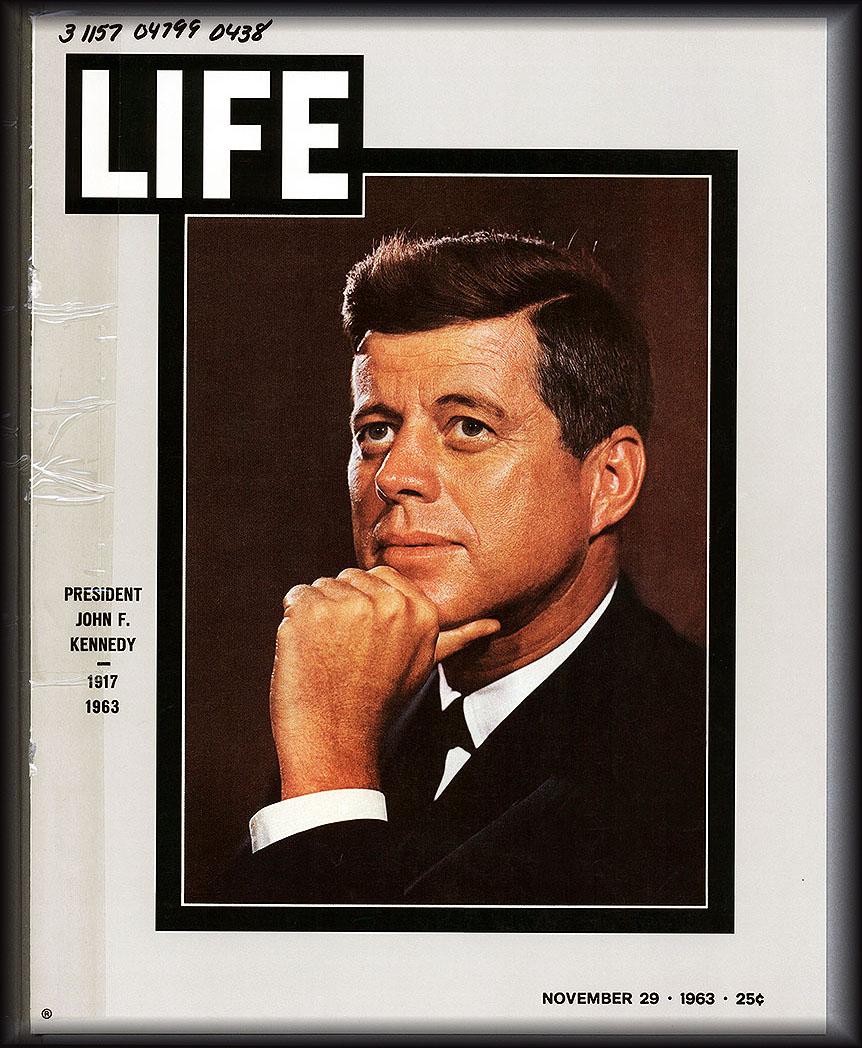
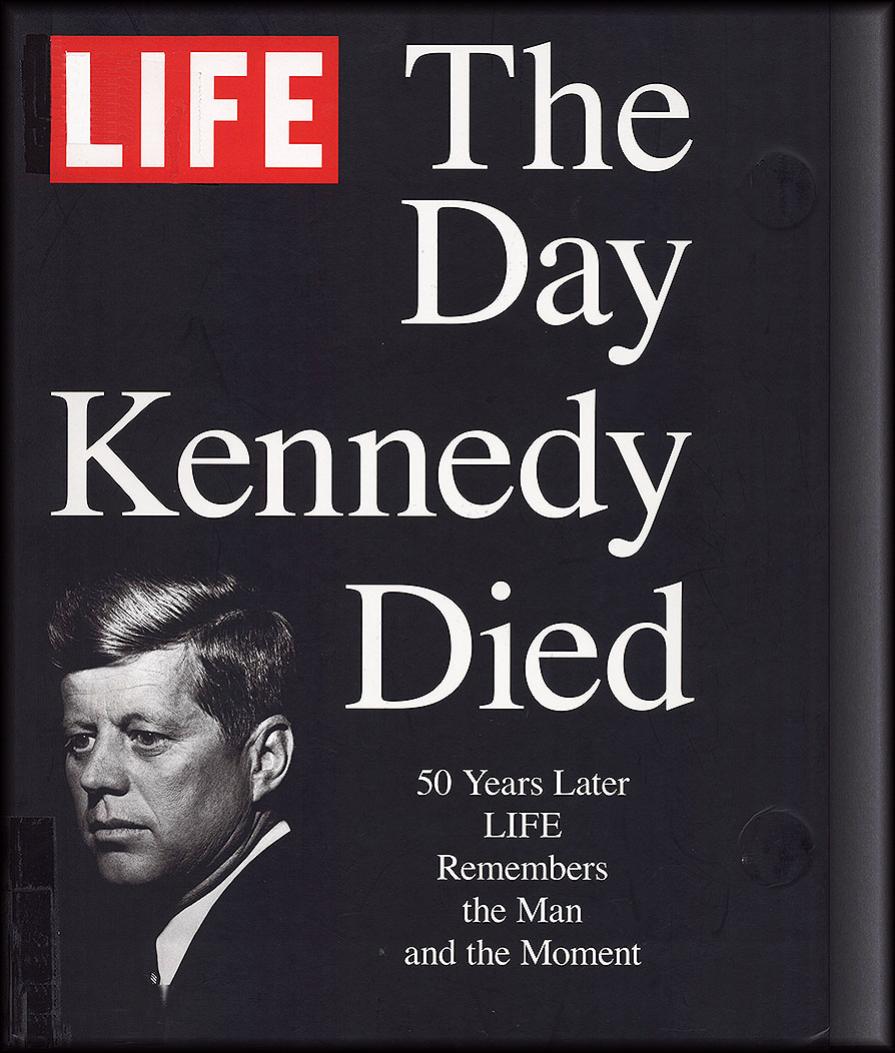
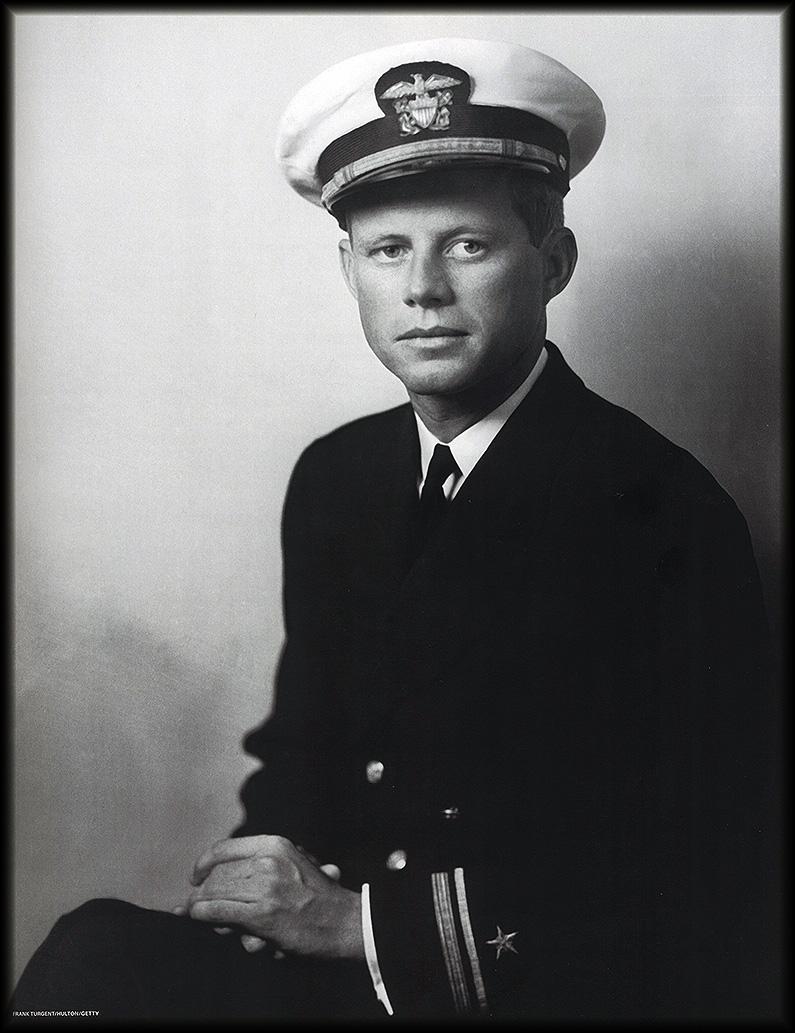
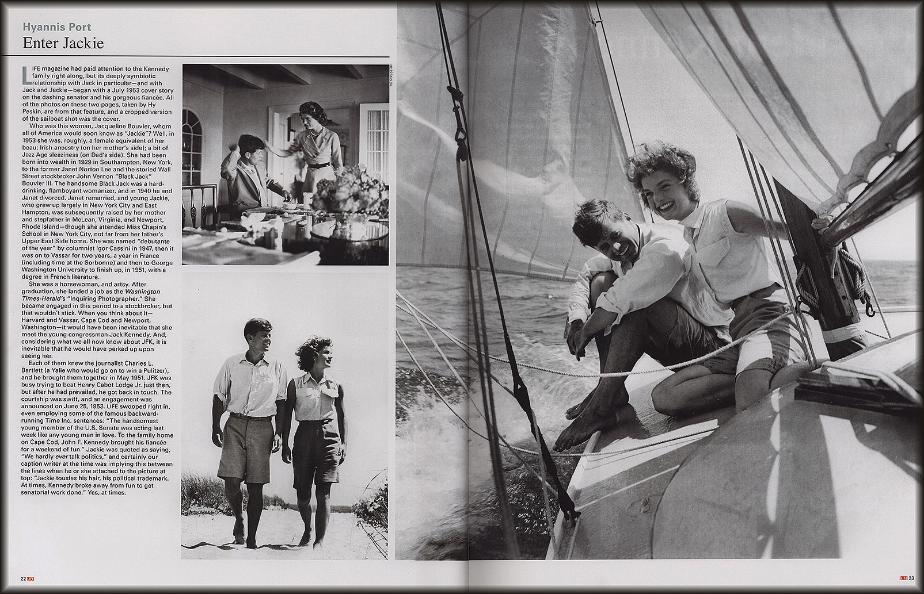
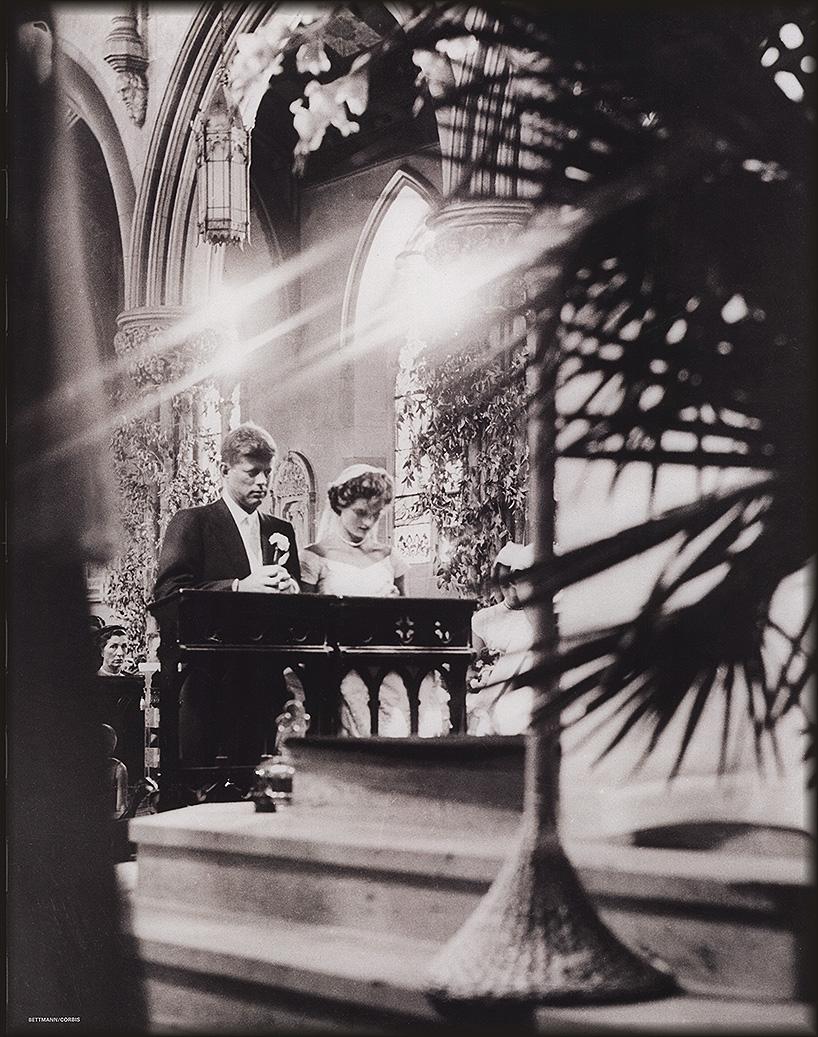
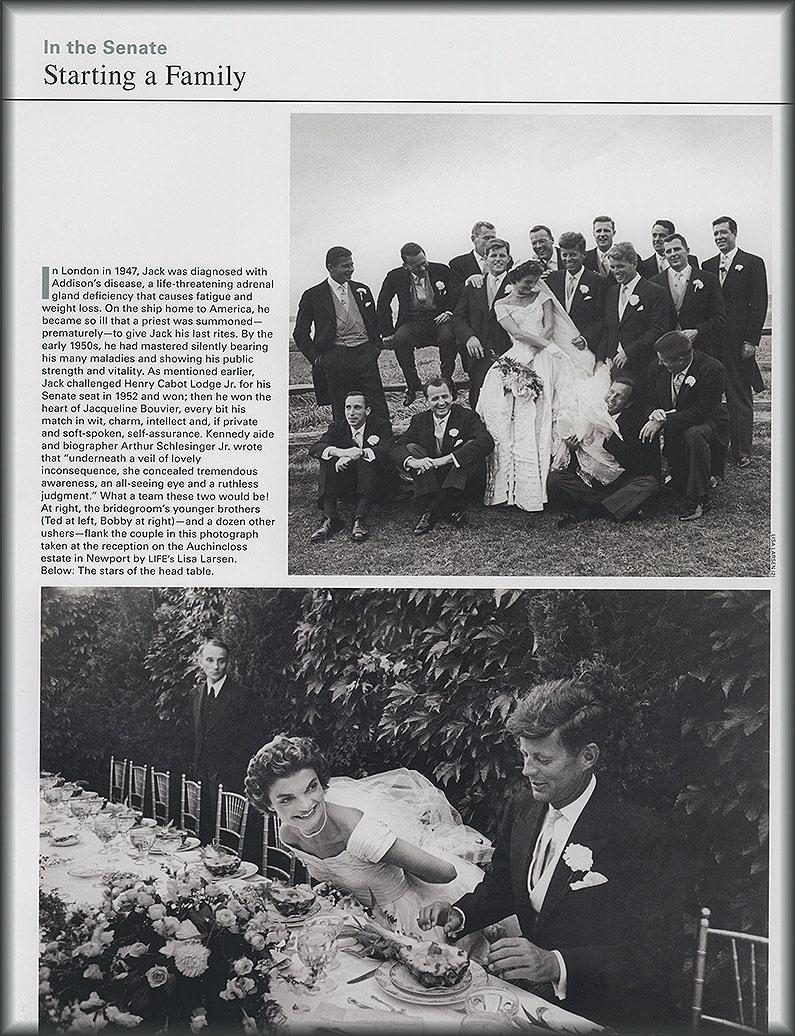




JFK Revelations . . ...
JFK Facts and INSIGHTS... REVELATIONS.... A Genuine EPIPHANY OF TRUTH . . . . ....
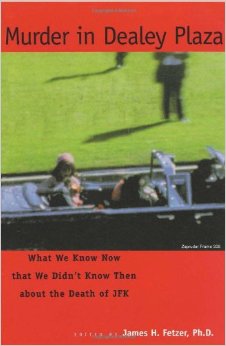

![Dr. Mary's Monkey [Edward T. Haslam, Jim Marrs]](resources/Dr.Mary%27s%20Monkey%20%5B300x468%5D.gif.opt155x241o0%2C0s155x241.gif)
===============================================================================================================
JFK REVELATIONS . . ... JFK INSIGHTS . . . ... AN EPIPHANY OF TRUTH . . . ....
================================== UPDATED ON 04/14/2016 =========================================
THE JFK ASSASSINATION: PART 1 – THE SHOOTERS
Project Release Date: 1 November 2015
The Main Trailer
=================================================
==========================================================================================
The FarSight Institute Remote Views the JFK Assassination . . .
Jeff RENSE INTERVIEWS JIM MARRS AND DICK ALLGIRE . . .
============================================================================
POSTED ON NOVEMBER 6, 2015
========================================
So what if Farsight spills the Beans? JFK was a long time ago. . . People forget . . .
===================================================================
http://farsight.org/demo/Mysteries/Mysteries_14/Mysteries_Project_14_trailers.html
======================================================================================
BEHIND THE SCENES WITH DICK ALLGIRE
============================================================
BEHIND THE SCENES WITH DAZ SMITH
============================================================
MYSTERIES PROJECT 14 – THE JFK ASSASSINATION
THE JFK ASSASSINATION: PART 1 – THE SHOOTERS
[TRAILER #2]
=====================
===========================================================
MYSTERIES PROJECT 14 – THE JFK ASSASSINATION
THE JFK ASSASSINATION: PART 1 – THE SHOOTERS
[TRAILER #1]
=====================
============================================================
=========================================================================================
Jeff Rense Interviews Jim Marrs and Dick Allgire . . .
=====================================================================
11-4-2015 - HOURS 2 & 3 - JIM MARRS & REMOTE VIEWER DICK ALLGIRE
NEW REVELATIONS ON JFK MURDER
=========================================================================================
Pictures Credit: http://www.rense.com/general96/jfkassassin.html - [Photos From Dick Allgire]
=============================================================================================================
=====================================
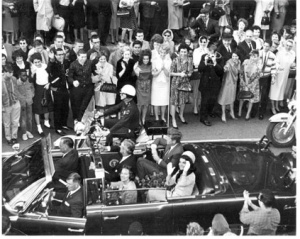
11-4-15
CREDIT:JEFF RENSE @ RENSERADIO.COM
http://www.rense.com/general96/jfkassassin.html
HOURS 2 & 3
JIM MARRS & REMOTE VIEWER DICK ALLGIRE
NEW REVELATIONS ON JFK MURDER
========================
==================================================================================================================
JFK INSIGHTS... REVELATIONS.... AN EPIPHANY OF TRUTH.....
====================================== UPDATED ON 08/08/2015 =============================================
=============================================================================================================
ARCHIVED FROM ORIGINAL WORK SO PAINSTAKINGLY AND METICULOUS COMPILED...
BY PROFESSOR JAMES FETZER PHD
REFERENCE SOURCED FROM [HTTP://JAMESFETZER.BLOGSPOT.COM/2011/01/WHOS-TELLING-TRUTH-CLINT-HILL-OR.HTML]
=======================================================================================================================
Who’s telling the truth: Clint Hill or the Zapruder film?
Agent’s reports contradict JFK film, autopsy X-rays and other crucial photographs
Professor James Fetzer PhD
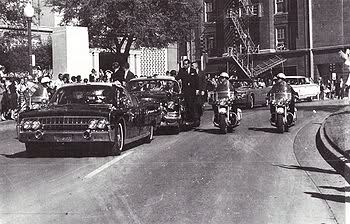
“In the midst of the mayhem the agents were calm, but ready to react in a millisecond if anything got out of hand.”
—Jerry Blaine, THE KENNEDY DETAIL
According to Jerry Blaine, the author of THE KENNEDY DETAIL (2010), his purpose in writing this book was “to set history straight, to leave a book for [his] grandchildren that they could read and know the truth beyond any measure of doubt.” What Blaine has actually done, however, moves us further toward the truth by revealing that the words of Clint Hill, the only agent to respond during the assassination, contradict his actions as shown in the Zapruder film, in which his efforts to protect Jackie Kennedy are among its most indelible features. They also impeach autopsy X-rays and other photographs. We therefore have in Clint Hill’s own words stunning new proof that the extant film has been faked. The book—and presentations to promote it—thus contributes to “setting history straight”, but not in the sense its author intended.
Clint Hill was not the only agent to attempt to respond after shots rang out. Secret Service agent John Ready, who was on the right running board whereas Clint was on the left, began to respond but was called back by Emory Roberts, Agent in Charge of the Presidential Protection Detail. This is stunning in itself, but is only one of more than fifteen indications that the Secret Service set up JFK for the hit, which include that two agents were left behind at Love Field, that the vehicles were in the wrong order, that the 112th Military Intelligence Unit was ordered to “stand down” rather than provide protection throughout the city, and that the motorcycle escort was reduced to four, who were instructed not to ride forward the rear wheels. Open windows were not covered and the crowd was allowed to spill out into the street.
When I discovered that Jerry and Clint had made presentations at book signings, I sent out a notice to several of my closest collaborators, all of whom contributed to the three JFK books I edited, ASSASSINATION SCIENCE (1998), MURDER IN DEALEY PLAZA (2000), and THE GREAT ZAPRUDER FILM HOAX (2003). I had reported there that we had found multiple indications the film had been reconstructed, where rather important events, such as the driver, William Greer, bringing the limo to a halt, had been removed and the film redone. An expert on special effects, Roderick Ryan, had told Noel Twyman, BLOODY TREASON (1997), that the “blob” of brains exploding to the right/front had been painted in, while, as Doug Horne, INSIDE THE ARRB (2009), has explained, a new group of Hollywood experts has found that a massive defect to the back of JFK’s head had been concealed by being (crudely) painted over in black.
The Costella Response
John Costella, Ph.D., the leading expert on the film in the world today, who earned his doctorate in physics with a specialization in electromagnetism, the properties of light and images of moving objects, responded almost immediately. “Forget about the book”, he wrote. “That YouTube video [of Blaine and Hill at a book signing, which can be found here:
is worth its weight in gold!” A few years ago, after he did a compilation of eyewitness reports from Dealey Plaza...
[http://assassinationresearch.com/v5n1/v5n1costella.pdf]
and created a stabilized version of the Zapruder film, in which the limousine does not move vertically within frames...
John recognized that what Clint has described from the days after the assassination, to his testimony to the Warren Commission and right up to his last public interviews in the 1970s or 1980s, was consistent but contradicts the film. At the book signing,
24:30: "As I approached the vehicle there was a third shot. It hit the President in the head, upper right rear of the right ear, caused a gaping hole in his head, which caused brain matter, blood, and bone fragments to spew forth out over the car, over myself. At that point Mrs. Kennedy came up out of the back seat onto the trunk of the car. She was trying to retrievesomething that had gone off to the right rear. She did not know I was there. At that point I grabbed Mrs. Kennedy, put her in the back seat. The President fell over into her lap, to his left.
His right side of his head was exposed. I could see his eyes were fixed. There was a hole in the upper right rear portion of his head about the size of my palm. Most of the gray matter in that area had been removed, and was scattered throughout the entire car, including on Mrs. Kennedy. I turned and gave the follow-up car crew the thumbs-down,indicating that we were in a very dire situation. The driveraccelerated; he got up to the lead car which was driven by Chief Curry, the Dallas Chief of Police . . .”.
This is completely consistent with every account Clint has ever given. He insists that he reached Mrs. Kennedy, pushed her down into the back seat, and was lying over the President, close enough to view the exact wounds, before the driver accelerated away—and certainly before they got to the lead car. The problem is that the extant Zapruder film—together with the less familiar Nix and Muchmore films—has Clint never actually touching Mrs. Kennedy; indeed, the extant Zapruder shows that he never got further than the rear foothold until the time that the limo passed the lead car and went under the Triple Underpass. Instead, it shows him stuck there on the rear foothold...

According to Clint Hill (shown here on the rear foothold of the limousine as the vehicle is about to enter the Triple Underpass), he had already reached Mrs. Kennedy and pushed her down in the back seat. JFK had fallen to the left into her lap, where the right side of his head was exposed to Clint, who was lying over them. This photo is supposed to have been taken by Ike Altgens and corresponds with late Zapruder frames. Clint’s testimony not only falsifies the Zapruder film, but also shows that this photograph was faked to agree with it.
Lest there be any doubt on this crucial point, in Clint Hill’s written statement dated 30 November 1963, which was published as Commission Exhibit CE 1024, he wrote: “As I lay over the top of the back seat I noticed a portion of the President’s head on the right rear side was missing and he was bleeding profusely. Part of his brain was gone. I saw a part of his skull with hair on it lying on the seat” [18H742]. And in his testimony to the commission on 9 March 1964, “The right rear portion of his head was missing. It was lying in the middle of the car. His brain was exposed.” [2H141]. Since he has told us he made these observations before the limousine had reached the pilot car drive by Chief Curry (shown above), this photo has to have been faked. Clint could not have made these observations from the rear foothold as it represents. (His descriptions of the wound to the right rear of JFK’s head are discussed below.)
The Limo Stop
Not the least fascinating aspect of Clint Hill’s latest remarks is his observation that he was covered with brains and gore as he ran forward from the left running board of the Secret Service Cadillac—called “The Queen Mary”—which, according to Emory Roberts (THE KENNEDY DETAIL, page 215), was 15 feet back. This is consistent with the report of Officer Bobby Hargis riding to the left/rear of the limousine, who was hit so hard by the brains and debris that he thought he himself might have been shot. Agents who saw JFK’s brains splattered across the trunk in Washington, D.C. would be nauseated by the sight, as I explained in HOAX, page 27. But it is not in the film. So John wrote to Clint—and he got it, because John has the signed Registered Mail receipt card—urging him to be certain to record his version of events for posterity. Now he is on the road, participating in book signings and talking publicly again, for the first time in decades. His story is still exactly the same and, most important, still does not agree with his actions as seen in the film. Here is a clip featuring what is represented as Clint Hill's actions in the film:
The film itself thus demonstrates that the Zapruder version of Clint Hill’s actions up to the Triple Underpass contradict Clint Hill’s words describing what he actually did.
John’s collation of eyewitness reports about the assassination includes dozens and dozens about the limo stop. Some reported seeing it slow dramatically and others that it came to a complete stop, which makes sense since, from different positions, different witnesses would have seen it slow dramatically as it came to a complete stop. Among them is Toni Foster, who was interviewed by Debra Conway in 2000. As Daniel Gallup has observed, Foster seems to have no idea that her recollections contradict the official record. Toni told Debra, "For some reason, the car stopped. It did stop for seconds. I don't even know why it stopped and all of a sudden it sped up and they went under the underpass. I could never figure out why the car stopped." “The way she delivers these lines,” Gallup observed, “I doubt Toni had ever seen the extant Z-film, and had no idea her recollections contradicted that film.” He said he was reminded of David Lifton's early (1971) interviews with the Newmans who also said the limo had stopped. “They had no way of knowing at the time that the Z-film showed no such stop. All of this is to say, the earliest recollections of individuals are likely to be the most significant,” he added, “especially if there is evidence of a lack of exposure to contrary viewpoints that might influence memory”. For a few more:
Billy Lovelady (on the steps of the Texas School Book Depository), 19 March 1964: “I recall that following the shooting I ran toward the spot where President Kennedy’s car had stopped.” [FBI statement: 22H662]
Roy Truly (on the north side of Elm Street in front of the building), 24 March 1964: “The car—I saw the President’s car swerve to the left and stop somewhere down in this area” [Later:] (Mr. Belin: “When you saw the President’s car seem to stop, how long did it appear to stop?) Mr. Truly: It would be hard to say, over a second or two, something like that. I didn’t see—I just saw it stop. I don’t know. I didn’t see it start up.” [Warren Commission testimony: 3H221]
Mrs. Earle Cabell (four cars behind the Presidential limousine, at the top of Elm Street at the time of the shots), 13 July 1964: “I was aware that the motorcade stopped dead still. There was no question about that.” [Later:] “As I told you, the motorcade was stopped.” [Later:] (Mr. Hubert: “That was when your car at least had come to a standstill?”) Mrs. Cabell: “Every car in the motorcade had come to a standstill.” [Later:] “… we were dead still for a matter of some seconds—“ [Warren Commission Testimony” 7H486-7]
These reports are significant from multiple points of view. Roy Truly was Oswald’s supervisor in the Book Depository and would reassure Officer Marrion Baker, when he confronted Oswald in the 2nd floor lunch room 90 seconds after the assassination, that he was an employee and belonged there. Billy Lovelady was another employee who looked enough like Oswald to be mistaken for him. And Earle Cabell, the Mayor of Dallas at the time, was the brother of Lt. Gen. Charles Cabell, USAF (ret.), whom JFK removed as a deputy director of the CIA after the disastrous Bay of Pigs fiasco.
The limo stop—during which JFK was hit twice in the head, once from behind and once from in front—was such an obvious indication of Secret Service complicity that it had to be taken out, which is undoubtedly the principal reason for fixing the film. But it had other ramifications. What Clint Hill has consistently described is not in the Zapruder film: he describes several actionsin those seconds around the limo stop that were deleted from the extant film. In editing the timeline of the extant film, it was necessary to delete his pushing of Mrs. Kennedy back into the seat—there just wasn't enough time left in the film once the limo stop had been deleted. There is no possible way in which Clint could possibly have seen what he claims to have seen before the car accelerated away and passed the lead car when he was stuck on the back of the speeding limo as he is shown doing in the extant film. And from his initial reports right up to his latest “book signing” interview, he has insisted that that was when he saw those things, that he did reach Mrs. Kennedy and that he did push her down into the car, unlike what the film shows. Which means that the film is a fake.
The Head Wound
Other proofs of the alteration of the film derive from his description of the wound itself and of the debris that was blown over the car. "As I approached the vehicle there was a third shot. It hit the President in the head, upper right rear of the right ear, caused a gaping hole in his head, which caused brain matter, blood, and bone fragments to spew forth out over the car, over myself. . . . His right side of his head was exposed. I could see his eyes were fixed. There was a hole in the upper right rear portion of his head about the size of my palm. Most of the gray matter in that area had been removed, and was scattered throughout the entire car, including on Mrs. Kennedy.” Clint’s description corresponds with the image of the blow out that can be seen in later frames of the film, such as 374:
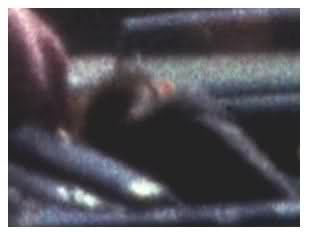
In the belief that those who were altering the film around the head shot in frame 313 might have overlooked later frames, I began to study later frames and found that the blow-out could be seen in frame 374. The bluish-gray image is brain matter, while the pinkish extension is the back of a skull flap that was blown open by the frangible (or exploding) bullet when it hit. But the blow-out is not seen in frames like 313-316, another proof of fakery.
Even if Clint actually touched Jackie, the films do not show him pushing her into the seat, which is what he has maintained for 47 years. In his formal report dated on 30 November 1963 about the events of 22 November 1963, a copy of which is archived at... [www.assassinationscience.com/ce-1024-clint-hill.pdf] ... he reports, “As I lay over the top of the back seat I noticed a portion of the President’s head on the right rear side was missing and he was bleed profusely. Part of his brain was gone. I saw a part of his skull with hair on it “, which is consistent with frame 374 but not with frames 313-316. Indeed, since this record was Warren Commission Exhibit CE-1024, at least some of its members and staff had to have been aware of observations of the first person to observe the head wound, apart from Jackie herself. But even THE KENNEDY DETAIL (2010) includes this sentence, "And slumped across the seat, President Kennedy lay unmoving, a bloody, gaping, fist-sized hole clearly visible in the back of his head" (THE KENNEDY DETAIL, p. 217), an observation of enormous significance in relation to the autopsy photographs and X-rays as well as to the authenticity of the Zapruder film.
As I have observed, Doug Horne, INSIDE THE ARRB, Vol. IV (2009), has reported that a new group of Hollywood experts studying the film has found that, in frames 313-316, the blow-out to the back of the head was (crudely) painted over in black. Their finding complements the earlier report by Roderick Ryan, an expert in special effects, that the “blob” of brains and blood that bulges out to the right/front had also been painted in, as Noel Twyman, BLOODY TREASON (1997), explained. (Roderick Ryan would receive the Academy Award for his contributions to cinematography in 2000.) Since the blow-out is visible in frame 374 but not visible in frames 313-316, we have yet another proof of the film has been altered. But these observations also extend to the autopsy photographs and X-rays. Here, for example, are drawings and photographs of the back of the head, which were assumed to be authentic by the House Select Committee on Assassinations (HSCA) when it reinvestigated the case in 1977-78:
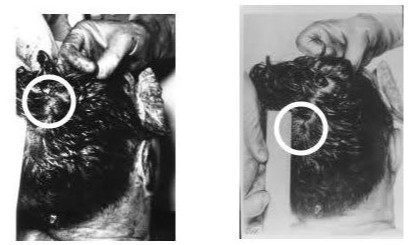
There are several important features of these images. One of the most stunning is that when the two pathologists who had conducted the autopsy at Bethesda Naval Hospital testified to the HSCA about the location of the alleged entry wound to the back of his head, they raised its location by four inches from above and to the right of the EOP (external occipital protuberance) to the crown of the head (or “cowlick”), an astounding variation from their autopsy report. Notice, too, that while the alleged entry wound is visible in the diagram on the right, it is not visible in the photograph on the left. Most important, however, is that, as in the case of the Zapruder frames 313-316, the blow out to the back of the head at the right rear, which Clint so vividly described, is missing. The skull flap is present, but the defect is not. Based upon his observations—he has been consistent about all this for more than forty years—this diagram and photograph, even apart from the EOP entry wound, have been faked.
The Witnesses and the X-rays
Clint Hill, moreover, was hardly the only witness to have reported that the President had an enormous blow-out to the right rear of his head. More than forty witnesses from Dealey Plaza, Parkland Hospital, and even Bethsda reported a blow out to the back of his head, including Beverly Oliver, Phillip Willis, Marilyn Willis, Ed Hoffman, Dr. Robert McClellan, Dr. Paul Peters, Dr. Kenneth Salyer, Dr. Charles Carrico, Dr. Richard Dulaney, Dr. Charles Crenshaw, Dr. Ronald Jones, Nurse Audrey Bell, Justice of the Peace Theran Ward, ambulance driver Aubrey Rike, FBI Agent Frank O’Neill, as well as Bethesda Naval medical technicians Jerrol Custer, Paul O’Connor and Floyd Reebe, as Robert Groden, THE KILLING OF A PRESIDENT (1994), pp. 86-88, has recorded, and as Gary Aguilar, M.D., has confirmed (MURDER 2000), pp. 175-217.
The highly consistent and mutually reinforcing testimony of all these eyewitnesses— including the physicians who were present in Trauma Room #1 when JFK’s moribund body was brought to Parkland Hospital and even Special Agents of the FBI who were present to observe the conduct or the autopsy at Bethesda Naval Hospital—were all discounted on the basis of the claim that the autopsy X-rays did not show any such blow-out. This inconsistency would not be resolved until late 1992, when David W. Mantik, M.D. Ph.D., would enter the National Archives to study the X-rays and in the process transform our understanding of the assassination and the cover-up. An M.D. with board certification in radiation oncology, which is the treatment of cancer using radiation therapy because of which he is an expert in the interpretation of X-rays, he drew on his background as a Ph.D. in physics and applied a simple technique known as “optical densitometry”, which enabled him—by measuring the amount of light that passes through an X-ray to determine the relative density of objects whose exposure to radiation had created the image—to discover that lateral cranial X-ray (of the skull taken from the side) had been altered by imposing a kind of patch over the blow out. Here we can see the “official” X-ray on the left and the patch (“Area P”) on the right, which bears a striking correspondence in size and shape to the image in Frame 374:
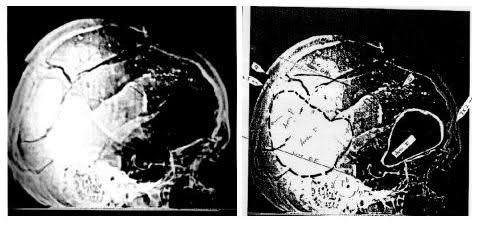
David’s discoveries and those of Robert B. Livingston, M.D., a world authority on the human brain and an expert on wound ballistics, were the centerpiece of my first of three books on the death of JFK, ASSASSINATION SCIENCE (1998), where I brought together experts on different aspects of the case. Livingston compared the multiple, consistent reports of qualified and experienced physicians at Parkland Hospital with the diagrams and photographs of the brain in the National Archives. The physicians reported both cerebral and cerebellar tissue extruding from the blow out, while the diagrams and photographs—the brain itself is missing—show a virtually undamaged brain with a complete cerebellum. You or I might have drawn the same conclusions, but it carries more weight when it’s the finding of a world authority on the brain. For those who may not have access to the book, a summary of our findings as well as of the shooting sequence is archived "Dealey Plaza Revisited: What Happened to JFK?”
“Ike” Altgens and Clint Hill
In his comprehensive study of the Zapruder film in HOAX (2003), Costella discusses the ambiguity that Altgens has displayed regarding the photos he allegedly took in Dealey Plaza on 22 November 1963. The identity of the person who took them was important in part because an Oswald look-alike (allegedly Billy Lovelady) can be seen in the photo with which this article begins—published in The Saturday Evening Post following the assassination. So the name of the photographer was widely sought but difficult to come by. Even J. Edgar Hoover skirted the issue. It would not be until 24 May 1964 he was identified by name and then questions arose of why neither the FBI nor the Warren Commission had interviewed him. While his office at the Associated Press was a short walk away from the FBI in Dallas, the FBI only interviewed him on 2 June 1964 and produced a rather garbled report of his actions that day. As Richard Trask, PICTURES OF THE PAIN (1994), reports, Altgens himself would subsequently deny that he had taken all of the photos that had been attributed to him. And that, no doubt, is for a very good reason. No one can have taken a photo that was faked.
Costella is certainly right about the importance of Clint Hill’s book-signing statement in comparison with the book itself, which is rather sketchy and vague relative to the sequence of events of greatest interest here. The video captures more detail and his demeanor in relating his extraordinary experiences. But even THE KENNEDY DETAIL (2010) includes this sentence, stunning in simplicity but pregnant in ramifications:
And slumped across the seat, President Kennedy lay unmoving, a bloody, gaping, fist-sized hole clearly visible in the back of his head. (THE KENNEDY DETAIL, p. 217)
After all, if JFK had a fist-sized hole clearly visible in the back of his head, it follows that (1) the eyewitnesses were right about its location, (2) the HSCA photograph and diagram are fake, (3) the autopsy X-rays were altered, and (4) Zapuder frames that don’t show it when they should were changed, precisely as we have found above. In fact, Clint Hill was far from the only expert who described that wound as “fist-sized”. When I edited ASSASSINATION SCIENCE (1998), I invited Charles Crenshaw, M.D., to contribute a chapter and asked him to diagram the wounds as he had witnessed them at Parkland Hospital, where he was the last physician to observe them before he closed JFK’s eyelids as he was being wrapped in sheets and placed in the casket:
Charles told me that this defect was the size of a baseball or else the size of your fist when you double it up. The best witnesses and the best studies thus converge on the conclusion that strenuous efforts were made to conceal the true causes of the death of JFK from the American people. For nearly fifty years, Clint has maintained that he pushed Jackie down into her seat and observed the blow out to the head in his report of 22 November 1963, http://www.assassinationscience.com/ce-1024-clint-hill.pdf , in this 1975 interview, http://www.assassinationscience.com/clint-hill-1975.mp4 and in this 1995 interview, where he describes it all in detail, and not just once but twice: http://www.assassinationscience.com/clint-hill-1995.mp4.
He and Jerry Blaine have thereby contributed to the resolution of one of the most contentious questions in the history of assassination research with corroborating proof the Zapruder film was altered.
Disturbing Reflections
Charles gave more than one interview in which he explained that the bullet that had blown out the back of JFK’s head had entered at the right temple. He suggested that it had taken a tangential trajectory and blown out the back of his skull, whereas Bob Livingston believed that shock waves created by the explosion of the frangible bullet had caused his brains to be blown out the back of his skull, which had already been weakened by the shot that entered the back of his head near the EOP. If Crenshaw was mistaken in detail about the trajectory, he was right that the autopsy photos he was being shown did not resemble the wounds that he had observed, which meant that there had been alteration of the evidence—either by faking photos and films or by the physical alteration of the wounds—both of which appear to have taken place.
Toward the end of this book, which is unintentionally revealing, Blaine relates the story of an exchange between Clint Hill and Mike Wallace for a planned “60 Minutes” segment. Mike asked Clint if he had any doubt that Oswald was the lone gunman, to which Clint replied, “There were only three shots,” Clint shrugged. “And it was one gun. Three shots.” (THE KENNEDY DETAIL, p. 387) What troubles me is that, given his consistent description of the blow-out to the back of the head, it ought to have been obvious that that shot had been fired from the right front. While there was an entry wound in the vicinity of the EOP, as Mantik explains in his masterful synthesis of the medical evidence in MURDER IN DEALEY PLAZA (2000), the massive, gaping wound that Clint observed was clearly fired from another location by someone else.
And that is not the only anomaly in Clint’s testimony as it is reported in the pages of this book. In the most puzzling passage of them all, Blaine reports’ “The Zapruder film was being used for Secret Service training and sometimes Clint was called on to comment” (THE KENNEDY DETAIL, p. 375). Given Clint’s consistent depiction of the actions he took which are inconsistent with the extant film, I am taken aback by the ghoulish prospect that the Secret Service may be using the authentic film, while the public has only the fake. Surely Clint would have been unable to miss the difference between his actions as he lived them and those depicted in the fabricated film. But perhaps even this extraordinary possibility cannot be ruled out. It might also help to explain Clint’s consistency in his depiction of the actions he took now nearly 50 years ago, if his memory has been periodically refreshed by seeing the original over again.
So Clint’s descriptions and observations both have significant ramifications for the autopsy X-rays, photos and the Zapruder film. Notice, for example, that the Mafia could not have altered X-rays under the control of medical officers of the US Navy, agents of the Secret Service, or the president’s personal physician. Neither pro- nor anti-Castro Cubans could have substituted another brain for that of JFK. And even if the Soviets had the capacity to fabricate movies comparable to that of the CIA and Hollywood, it would have been unable to get its hands on the Zapruder film. JFK had antagonized many of the most powerful individuals and groups in the USA, as James Douglass, JFK and the Unspeakable (2008), and Phillip Nelson, LBJ: The Mastermind of JFK's Assassination (2010) have explained. We now have another piece of a puzzle that implicates officials at the highest levels of the American government as complicit in an elaborate cover-up that has to have been planned in detail and in advance of the commission of the crime. It is long past time the truth be known to the public.
Special thanks to John Costella and to David Mantik for their comments and suggestions.
Jim Fetzer [send him mail], a former Marine Corps officer who earned his Ph.D. in the history and the philosophy of science, is McKnight Professor Emeritus at the Duluth campus of the University of Minnesota. He co-edits assassinationresearch.com with John Costella. He is the editor of The Place of Probability in Science.
POSTED BY JIM FETZER AT 8:50 PM
Archived from Original Work so painstakingly and meticulous compiled done by Professor James Fetzer PhD Reference sourced from [http://jamesfetzer.blogspot.com/2011/01/whos-telling-truth-clint-hill-or.html]
JFK: The Assassination of America [Part 1 of 6] by Phil Nelson [Published on June 23, 2014]
On 22 November 2013, the Oswald Innocence Campaign hosted the premiere event to commemorate the 50th observance of the JFK assassination in Santa Barbara, CA, at the Fess Parker Doubletree Hotel (1-10:30 PM). Presenting cutting-edge research on the death of our 35th President, which holds the keys to understanding what took place, it features some of the best authors on some the most important evidence that clarifies and illuminates that tragic event in Dallas on 22 November 1963.
The research presented advanced extensive, detailed evidence establishing that the assassination of JFK was a "national security event", which involved crucial elements of the most powerful institutions in the American government, including the CIA, the Joint Chiefs, the FBI and the Secret Service, who conspired with the Mafia, anti-Castro Cubans and Texas oil men to remove JFK from office and replace his policies with those of LBJ.
Part 1: PHILLIP F. NELSON
Phillip F. Nelson is the author of LBJ: The Mastermind of the JFK Assassination (2nd revised edition, 2011), in which he explains that Lyndon Baines Johnson was the cardinal instigator of the plot to kill JFK. LBJ forced his way onto the ticket as the Vice Presidential nominee in Los Angeles in 1960, telling reporters that he had studied history and had discovered that 1/4 of US Presidents had not survived their terms. He said he was "a gambling man", but LBJ only bet on sure things. Phillip explains how Johnson was uniquely positioned to assemble the key men--from the financiers to the operational planners and the cover-up experts--to complete the job. And it was all done at the expense of a "patsy" named Lee Harvey Oswald.
JFK: The Assassination of America [Part 2 of 6] by John Hankey [Published on July 06, 2014]
On 22 November 2013, the Oswald Innocence Campaign hosted the premiere event to commemorate the 50th observance of the JFK assassination in Santa Barbara, CA, at the Fess Parker Doubletree Hotel (1-10:30 PM). Presenting cutting-edge research on the death of our 35th President, which holds the keys to understanding what took place, it features some of the best authors on some the most important evidence that clarifies and illuminates that tragic event in Dallas on 22 November 1963.
The research presented advanced extensive, detailed evidence establishing that the assassination of JFK was a "national security event", which involved crucial elements of the most powerful institutions in the American government, including the CIA, the Joint Chiefs, the FBI and the Secret Service, who conspired with the Mafia, anti-Castro Cubans and Texas oil men to remove JFK from office and replace his policies with those of LBJ.]
JFK: The Assassination of America [Part 3 of 6] by PeterJanney [Published on June 02, 2014]
On 22 November 2013, the Oswald Innocence Campaign hosted the premiere event to commemorate the 50th observance of the JFK assassination in Santa Barbara, CA, at the Fess Parker Doubletree Hotel (1-10:30 PM). Presenting cutting-edge research on the death of our 35th President, which holds the keys to understanding what took place, it features some of the best authors on some the most important evidence that clarifies and illuminates that tragic event in Dallas on 22 November 1963.
The research presented advanced extensive, detailed evidence establishing that the assassination of JFK was a "national security event", which involved crucial elements of the most powerful institutions in the American government, including the CIA, the Joint Chiefs, the FBI and the Secret Service, who conspired with the Mafia, anti-Castro Cubans and Texas oil men to remove JFK from office and replace his policies with those of LBJ.
Part 3: PETER JANNEY
Peter Janney grew up in Washington D.C. during the Cold War era of the 1950s and 1960s. His father, Wistar, was a senior career CIA official. The Janney family was intimately involved with many of the Washington political elite that included the family of Mary and Cord Meyer, as well as other high-ranking CIA officials such as Richard Helms, James Jesus Angleton, Tracy Barnes, Desmond FitzGerald, and William Colby. In his gripping book, Mary's Mosaic (2012), Peter illuminates the magnitude of real-life evil perpetrated by the CIA far beyond that which most of us could never imagine. A graduate of Princeton, Peter is a clinical psychologist who lives by the sea in Beverly, Massachusetts.
JFK: The Assassination of America [Part 4 of 6] by Larry Rivera [Published on July 10, 2014]
On 22 November 2013, the Oswald Innocence Campaign hosted the premiere event to commemorate the 50th observance of the JFK assassination in Santa Barbara, CA, at the Fess Parker Doubletree Hotel (1-10:30 PM). Presenting cutting-edge research on the death of our 35th President, which holds the keys to understanding what took place, it features some of the best authors on some the most important evidence that clarifies and illuminates that tragic event in Dallas on 22 November 1963.
The research presented advanced extensive, detailed evidence establishing that the assassination of JFK was a "national security event", which involved crucial elements of the most powerful institutions in the American government, including the CIA, the Joint Chiefs, the FBI and the Secret Service, who conspired with the Mafia, anti-Castro Cubans and Texas oil men to remove JFK from office and replace his policies with those of LBJ.
Part 4: LARRY RIVERA
Larry Rivera, the son of a career military man who served as CID officer in the Army, was residing in Germany on 22 November 1963 and, at age 6, will never forget his father's reaction upon hearing of JFK's murder: "Johnson!" Larry is a Certified Network Engineer, who also owns an automotive wholesale parts business. He has made a lifelong study of the JFK assassination. He first visited Dealey Plaza in 1991 and subsequently attended The ASK Symposium in 1993 for the 30th observance. He has done extensive work on Billy Lovelady and on Joe Molina and recently published on Buell Wesley Frazier and the Altgens 6.
The JFK Horsemen [Part 1 of 2] by Larry Rivera [Published on Sept 29, 2014]
This simply a superb presentation was broadcast on The New JFK Show #27 by Dr. Jim Fetzer and Gary King on the Revere Radio Network. The detail Larry Rivera presented this information about the Motorcycle riders is remarkable, as is the audio clips provide great supporting evidence.
The Jimmy Courson story is a great capstone to the multiple strands of police officer testimony supporting (1) shots from the front; (2) the limousine slowing down or completely stopping; and (3) film alteration after the fact. In the case of Courson's account, there is no danger of this being "hearsay" evidence: he is captured on camera telling his story at the time of the 50th anniversary.
The JFK Horsemen [Part 2 of 2] by Larry Rivera [best version slightly tweaked] [Published on Oct. 25, 2014]
The New JFK Show #32 is dedicated to James Henry Fetzer.
This video dispels any remaining doubts about Zfilm alteration and the bullet hole in the wind shield controversy is now a thing of the past. The JFK Horseman series brings NEW evidence by way of the motorcycle policemen's own corroborating accounts. This documentary is without a doubt a history altering event and obsoletes decades of inaccurate research by countless "JFK" researchers. Dr. Fetzer has published on these facts nearly 20 years ago... had we listened to the good doctor, we would not have squandered two decades of effort.
The Real Deal Ep # 145 On the Road & The JFK Horseman] [Published on Dec 26, 2015]
Media Broadcasting Center Official Channel
"The Real Deal" with James Fetzer - On the road . . . in Dallas . . . and New Orleans . . . with Larry Rivera . . . and the JFK Horsemen evidence, the interviews . . .
The Real Deal Ep # 148 Truth vs News / Ground Breaking NEW JFK Eyewitness] [Published on Jan 7, 2016]
Media Broadcasting Center Official Channel
"The Real Deal" with James Fetzer - Ground Breaking New JFK Eyewitness . . .
JFK: The Assassination of America [Part 5 of 6] by Ralph C. Cinque [Published on July 11, 2014]
On 22 November 2013, the Oswald Innocence Campaign hosted the premiere event to commemorate the 50th observance of the JFK assassination in Santa Barbara, CA, at the Fess Parker Doubletree Hotel (1-10:30 PM). Presenting cutting-edge research on the death of our 35th President, which holds the keys to understanding what took place, it features some of the best authors on some the most important evidence that clarifies and illuminates that tragic event in Dallas on 22 November 1963.
The research presented advanced extensive, detailed evidence establishing that the assassination of JFK was a "national security event", which involved crucial elements of the most powerful institutions in the American government, including the CIA, the Joint Chiefs, the FBI and the Secret Service, who conspired with the Mafia, anti-Castro Cubans and Texas oil men to remove JFK from office and replace his policies with those of LBJ.
Part 5: RALPH C. CINQUE
Ralph C. Cinque has worked in the health field as a chiropractor and health spa operator, and he is the former president of an international physicians' group. Ralph has also been an avid student of the JFK assassination for many years, and he has had a series of articles on the assassination published on www.VeteransToday.com and on www.LewRockwell.com. It was his observation that the clothing that "Doorman" was wearing rather than his facial features was the key to his identification, which has proven to be exactly right. He has been the moving force behind and the founder of the Oswald Innocence Campaign.
JFK: The Assassination of America [Part 6 of 6] by James Fetzer [Published on July 15, 2014]
On 22 November 2013, the Oswald Innocence Campaign hosted the premiere event to commemorate the 50th observance of the JFK assassination in Santa Barbara, CA, at the Fess Parker Doubletree Hotel (1-10:30 PM). Presenting cutting-edge research on the death of our 35th President, which holds the keys to understanding what took place, it features some of the best authors on some the most important evidence that clarifies and illuminates that tragic event in Dallas on 22 November 1963.
The research presented advanced extensive, detailed evidence establishing that the assassination of JFK was a "national security event", which involved crucial elements of the most powerful institutions in the American government, including the CIA, the Joint Chiefs, the FBI and the Secret Service, who conspired with the Mafia, anti-Castro Cubans and Texas oil men to remove JFK from office and replace his policies with those of LBJ.
Part 6: JAMES H. FETZER, Ph.D.
James H. Fetzer, Ph.D., a former Marine Corps officer and McKnight University Professor Emeritus on the Duluth Campus of the University of Minnesota, has chaired or co-chaired four national conferences on the death of JFK. He produced the 4.5-hour long documentary "JFK: The Assassination, the Cover-Up, and Beyond" (1994), as well as edited Assassination Science (1998), Murder in Dealey Plaza (2000) and The Great Zapruder Film Hoax (2003). Jim co-edits www.assassinationresearch.com, an on-line journal for the advanced study of the death of JFK, with John P. Costella, Ph.D. His columns on www.VeteransToday.com, including on JFK, are widely read...
JFK II - The Bush Connection [Published on Oct. 04, 2013]
A Step by step look at the events leading up to JFK's assassination. Proving it was perpetrated by forces within our own government. The author of this documentary takes it even a step further and shows how George Bush Senior is connected to the murder of JFK.
'The Men Who Killed Kennedy' began with two 50-minute segments originally aired on 25 October 1988 in the U.K. ... entitled simply Part One and Part Two... [https://en.wikipedia.org/wiki/The_Men_Who_Killed_Kennedy] ...
THE MEN WHO KILLED KENNEDY [UPLOADED ON JUL 30, 2011]
"The Coup D'Etat" (25 October 1988)
"The Forces Of Darkness" (25 October 1988)
"The Cover-Up" (20 November 1991)
"The Patsy" (21 November 1991)
"The Witnesses" (21 November 1991)
"The Truth Shall Set You Free" (1995)
"The Smoking Guns" (2003)
"The Love Affair" (2003)
"The Guilty Men" (2003)
.... Credit to ConspiracyScope for the upload ..... [https://www.youtube.com/channel/UCl0T0SKaV5rJU81F_QUCakw]
The United States corporation, Arts & Entertainment Company, purchased the rights to the original two segments. In 1989, the series was nominated for a Flaherty Documentary Award.[citation needed] In November 1991, the series was re-edited with additional material and divided into three 50-minute programmes, which were also shown by ITV on consecutive nights. An additional episode appeared in 1995. The series typically aired in November every year and from time to time during the year...
2003 onwards...
In November 2003, three additional segments ("The Final Chapter") were added by the History Channel, entitled, respectively, "The Smoking Guns", "The Love Affair" and "The Guilty Men".
"The Love Affair" focused on the claims of Judyth Vary Baker to have been Lee Harvey Oswald's lover in 1963, and to have worked with Oswald and others to develop a cancer-causing biological weapon as part of a CIA plan to assassinate Fidel Castro.
The third of these additional segments - "The Guilty Men" - was based substantially on the book Blood, Money & Power: How L.B.J. Killed J.F.K by Barr McClellan.[5] The book and the episode directly implicates former U. S. President Lyndon B. Johnson (LBJ) and its airing in 2003 created an outcry among Johnson's surviving associates, including Johnson's widow, Lady Bird Johnson, former LBJ aides Bill Moyers and Jack Valenti (longtime president of the Motion Picture Association of America), U.S. Presidents Jimmy Carter and Gerald R. Ford, and the last-living (at the time of the outcry) Warren Commission member. These Johnson supporters lodged complaints of libel with the History Channel, and subsequently threatened legal action against Arts & Entertainment Company, owner of the History Channel. The History Channel responded by assembling a panel of three historians, Robert Dallek, Stanley Kutler, and Thomas Sugrue. On a program aired April 7, 2004, titled "The Guilty Man: A Historical Review," the panel agreed that the documentary was not credible and should not have aired. The History Channel issued a statement saying, in part, "The History Channel recognizes that 'The Guilty Men' failed to offer viewers context and perspective, and fell short of the high standards that the network sets for itself. The History Channel apologized to its viewers and to Mrs. Johnson and her family for airing the show." The channel said it would not show the episode again. Author Barr McClellan, on whose work the episode was largely based, complained that he had tried to cooperate with the reviewing historians to discuss his evidence with them, and had been ignored...

The Woman in the 'Blue Raincoat' .... Mary Moorman .... and that famous Polaroid of JFK...
[http://www.dailymail.co.uk/news/article-2510204/The-Woman-Blue-Raincoat-took-famous-Polaroid-JFK-shot-speaks-says-thinks-theres-story.html]
By MEGHAN KENEALLY
PUBLISHED: 17:07 EST, 19 November 2013 | UPDATED: 15:24 EST, 20 November 2013
'The Woman in the Blue Raincoat' speaks out: Bystander who took Polaroid of JFK being shot recalls fateful day and says she thinks there's 'more to the story' ...
Mary Ann Moorman took her Polaroid camera to the parade route and took a photo the moment before John F Kennedy was fatally shot in the head ....
She was so close enough to the convertible that she heard Jackie scream: 'My God, he's been shot!' The day will be forever etched into her memory - the moment America's youngest ever president was assassinated on the streets of Dallas, Texas...
Mary Ann Moorman and her friend had gone to the parade route with her new Polaroid camera, eager to take a snapshot when the President and First Lady passed them in the motorcade. Little did she know that she would capture the moment immediately before Lee Harvey Oswald fired the fatal shot that killed John F Kennedy...
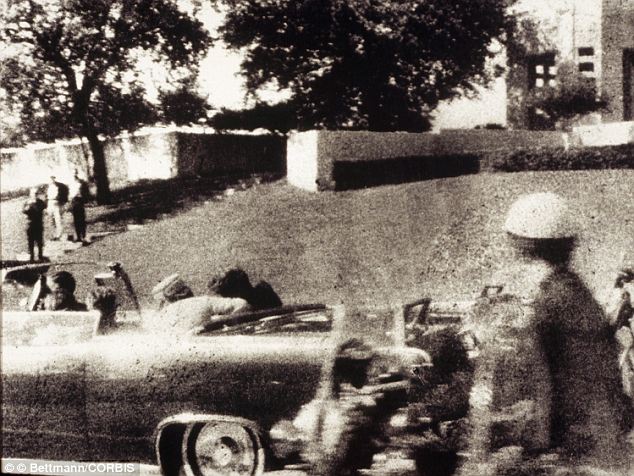
Tragic moment: Mary Ann Moorman took this Polaroid photograph, showing the President and the First Lady reacting after Kennedy had been hit in the throat. Almost the instant after this photo was taken, Kennedy was hit in the head...
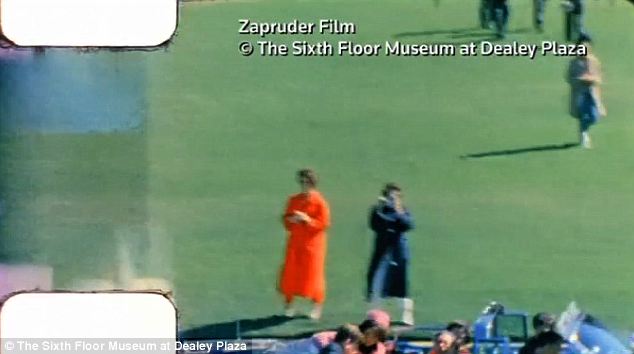
Up close: Mary Ann Moorman is seen in the Zapruder film, as she is in the blue raincoat taking a picture of the President and First Lady in the foreground just as he was shot...
JFK Assassination Zapruder Film Digitally Remastered
At first she did not know what was going on, thinking that the snap she heard was that of a firecracker. 'That was my thought: "I saw his hair jump!" But it wasn't just his hair, it was part of his head,' she told Matt Lauer on The Today Show. 'I heard Jackie yell, "My God, he’s been shot".’
Ms Moorman was a 31-year-old housewife at the time of the assassination. The Zapruder film - named after Abraham Zapruder, the man who captured Kennedy's assassination on a home camera - shows Moorman standing in a blue raincoat next to her friend in a red raincoat on the grass between Elm Street and Main Street as the President's convertible drives by. What Moorman didn't realize when she chose to wait for the motorcade was that her location was in line with the Texas Book Depository, where shooter Lee Harvey Oswald was waiting on the sixth floor.
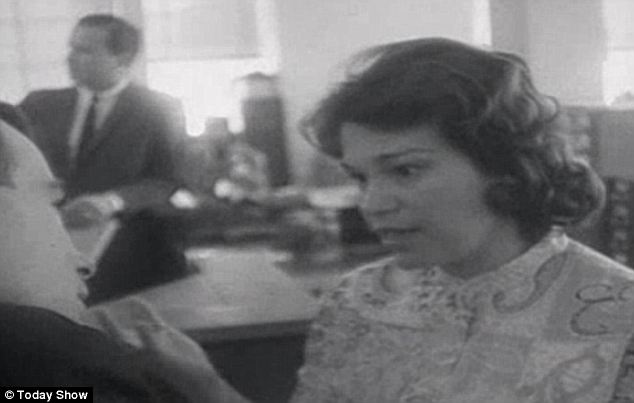
THEN: MARY ANN MOORMAN WAS RUSHED TO A LOCAL NEWSPAPER OFFICE AFTER A REPORTER SAW SHE HAD TAKEN A PICTURE.

NOW: MRS MOORMAN, 81, SAT DOWN FOR AN INTERVIEW WITH THE TODAY SHOW AND SAID THAT SHE BELIEVES THERE IS 'MORE' TO BE DISCOVERED ABOUT THE TRUE NATURE OF THE KENNEDY ASSASSINATION.
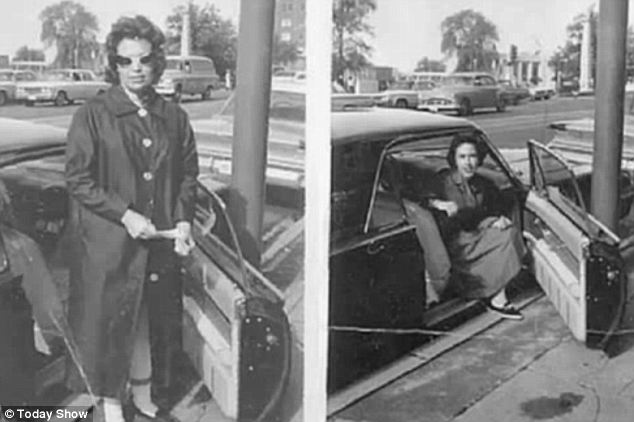
On their way: Mrs Moorman (left) and her friend (right) went to the parade together in matching raincoats.
'I heard the shot, took the camera down, and I heard two more shots,' she told the Today Show. 'Just pow, pow, pow.' In the hectic aftermath immediately following the shots, a local reporter approached Ms Moorman and accompanied her to his newspaper office so that they could take a look at the photo together as it developed. It shows Jacqueline leaning in towards her husband as he appears to be falling back into the seat. 'The though always comes back to me: I saw a man murdered right in front of my eyes. That thought is still present in my mind right now,' she said.
Eyewitnesses recall JFK assassination
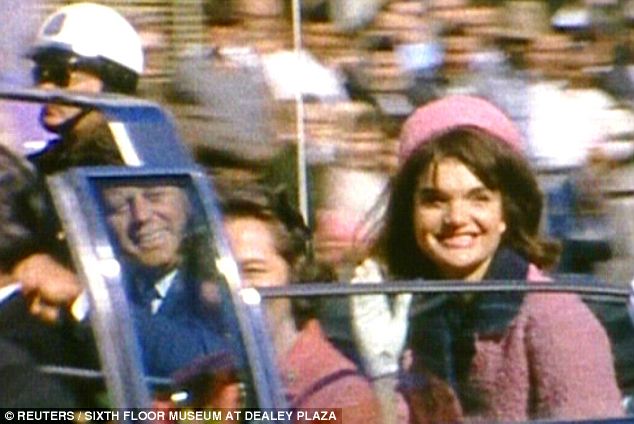
Different angle: From where she was standing, Ms Moorman was closest to First Lady Jacqueline Kennedy, and said that she could here her scream 'My God, he's been shot!'
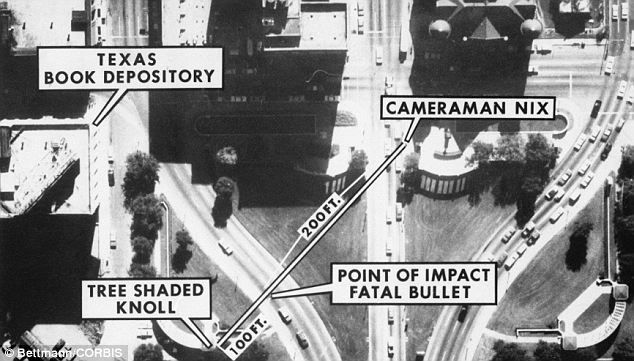
Orientation: Ms Moorman and her friend were standing on the grass between the point of impact and the location of Orville Nix (noted on this aerial photo as 'Cameraman Nix'). Other points marked are the Texas Book Depository, where Lee Harvey Oswald was positioned, and the infamous 'grassy knoll'...
She agreed to sell the original Polaroid through an auction house but it failed to meet its expected price of $50,000 to $75,000.
Ms Mooman, who is now 81-years-old, said she does not subscribe to any of the major conspiracy theories but many others actually used her photograph as part of their justification for their own versions of events - specifically the 'grassy knoll theory' that suggests there was a second shooter.
She said that she never 'delved' into any of the different theories but continued to remain wary of the final conclusion that was drawn by the Warren Commission, which in 1964 ruled that Lee Harvey Oswald had acted alone.
'I don’t think that I heard any more shots than three but so many of the things that I have heard makes me think that there's a lot more to the story,' she said.

Woman in the 'Blue Raincoat' ... Mary Moorman ... who took that famous JFK Polaroid photo....
Zapruder Frame [Z301] - Mary Moorman in purple next to Jean Hill in red...

Mary Moorman in purple next to Jean Hill in red: using the photographs she took as The limousine went by, she could not be standing on the grass. She always maintained she was standing in the street.
JFK Assassination Jean Hill standing in street...
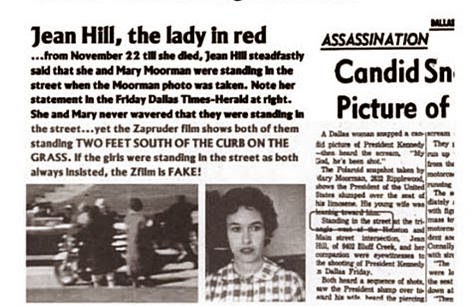
Jean Hill, the lady in red ... from Nov. 22 till she died, Jean Hill steadfastly said that she and Mary Moorman were standing in the street when the Moorman photo was taken. Note her statement in the Friday Dallas Times-Herald... She and Mary never waivered that they were standing in the street... yet the Zapruder film shows both of them standing Two Feet South Of The Curb On The Grass...!! If the girls were standing in the street as both always insisted... the Zapruder Zfilm is Fake...!!!
Credit due: [http://luisabroad.blogspot.com/2013/11/zapruders-fake-film.html]
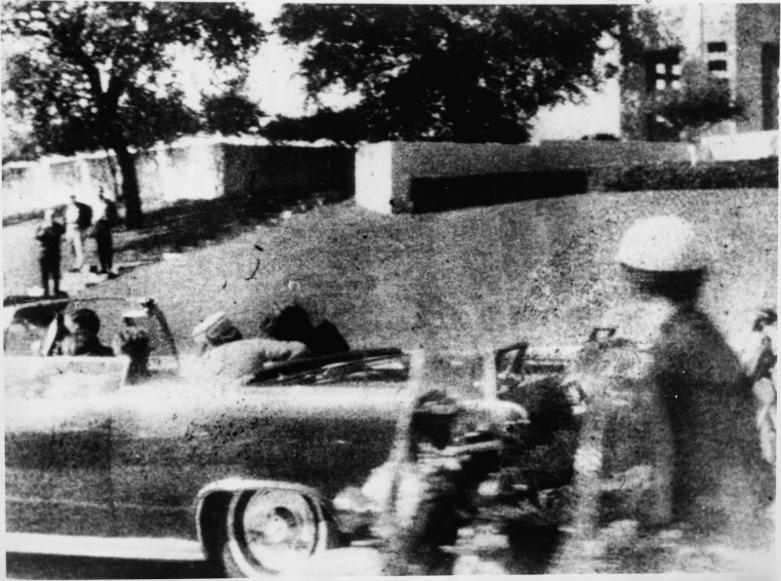
The Mary Moorman photo
Life Magazine November 25, 1966 - Zapruder frame 230 President Kennedy's assassination

Life Magazine November 25 1966 - Cover - Zapruder frame 230 President Kennedy's assassination

LIFE MAGAZINE NOVEMBER 25, 1966 [1] - KENNEDY ASSASSINATION

LIFE Magazine NOVEMBER 25, 1966 (3) - Kennedy Assassination
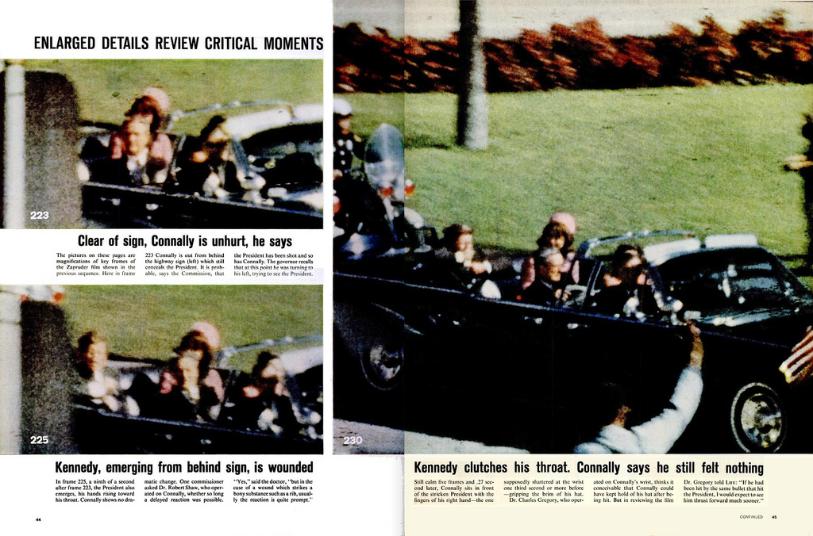
LIFE Magazine NOVEMBER 25, 1966 (5) - Kennedy Assassination

LIFE Magazine NOVEMBER 25, 1966 (6) - Kennedy Assassination
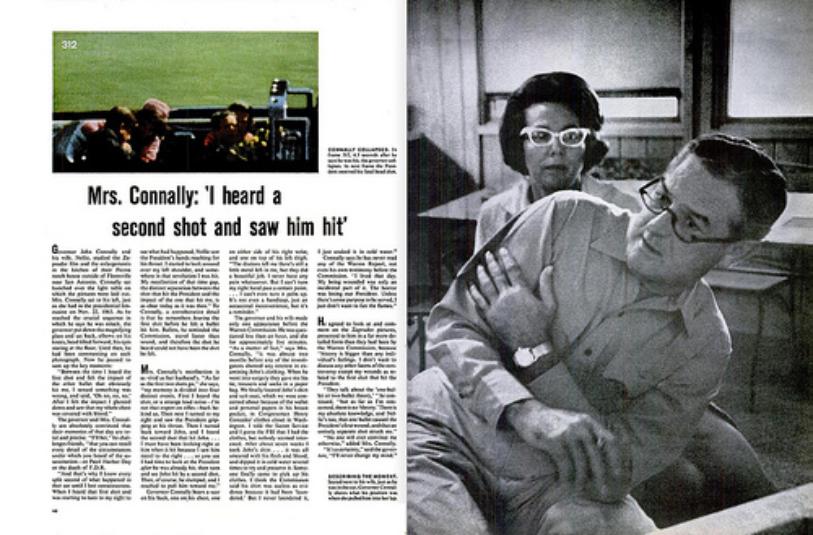
LIFE Magazine NOVEMBER 25, 1966 (7) - Kennedy Assassination

LIFE Magazine NOVEMBER 25, 1966 (8) - Kennedy Assassination
Newsweek (November 22, 1993)Figures 1A-1b][Pg.74]final head shot is shown at 30-40 ft beyond Z-313
 Pg.74][The final head shot is shown at 30-40 feet beyond Z-313.jpg?timestamp=1438386669480)
 Pg.74][The final head shot is shown at 30-40 feet beyond Z-313.jpg?timestamp=1438386787536)
NEWSWEEK (NOVEMBER 22, 1993) FIGURES 1A-1B][PG.74]FINAL HEAD SHOT SHOWN AT 30-40 FEET BEYOND Z-313
[Archived from the site Courtesy of [http://www.ctka.net/2013/eot_review.html]
Enemy of the Truth: Myths, Forensics and the Kennedy Assassination by Sherry P. Fiester
Figures 1A and 1B. Newsweek (November 22, 1993), p. 74. The final head shot is shown at 30-40 feet beyond Z-313, based on early reenactments, data tables and documents; all were ignored by the Warren Commission...
 Remarkable evidence, including (altered) surveyor's data sheets, exists for a headshot distinctly farther down Elm Street, i.e., closer to the stairs that ascend the Grassy Knoll. As another example. Newsweek displayed a map [Warren Commission (WC)] showing just such a shot (Figures 1A & 1B).
Remarkable evidence, including (altered) surveyor's data sheets, exists for a headshot distinctly farther down Elm Street, i.e., closer to the stairs that ascend the Grassy Knoll. As another example. Newsweek displayed a map [Warren Commission (WC)] showing just such a shot (Figures 1A & 1B).
So the question naturally arises: Were two headshots conflated? We shall return to this question. But an even more profound question is this: What really happened at Z-313...???
But here is my chief criticism of this chapter: If back spatter is so obvious in the film (as may be true), why then is forward spatter so hard to see..? According to Figure 5 in EoT (the MFRC video), forward and back spatter are visible in the same frame. [24] So where is the forward spatter in the Z-film? To further highlight this paradox, note that EoT quotes Hargis as easily seeing (during the actual event) such forward spatter... "He described to me how the blood left the back of the President's head in copious amounts. He stated that as the expelled blood hung in the air, he drove into it, thereby getting blood and bits of bone and brain on his motorcycle, clothing, and person. ... he said, 'It was as if a bucket of blood was thrown from the back of his head; it spread out and hung in the air for a minute.' "
EoT even reports that Hargis's wife, too, noticed solid matter on Hargis when he returned home (p. 341). But about the absence of such forward spatter in the Z-film, EoT remains oddly silent.
Costella's analysis of the streaking fragments (in successive frames) suggests that the bullet impact likely occurred "... just after the end of the exposure of Frame 312, which is about half a frame before the start of the exposure of Frame 313." [26] If so, then it is even more likely (since both spatter events occur promptly with the bullet strike, according to EoT) that both events should be visible in Z-313. In fact, EoT states that back spatter dissipates faster than forward spatter (p. 102, item 5). If so, then where is the forward spatter in Z-313? After all, it should appear at about the same time as back spatter and it should last longer.
Another issue that entirely escapes the author's attention is the distance that the back spatter supposedly traveled: according to Frazier (pp. 114, 342-344), both sides of the windshield, the entire exterior, and the hood ornament (at the front of the limousine) were all coated with tissue debris. On the other hand, according to EoT, back spatter only travels four feet (p. 101) or perhaps just three feet (p. 118). [27] But the distance from JFK to the hood ornament is way over four feet – and the wind was blowing (strongly) toward the rear of the limousine (see the coats of Moorman and Jean Hill in the Muchmore film).
So the problem is obvious: How did back spatter reach the hood ornament? [29] (Recall that EoT insists on only one headshot.) But perhaps we should change focus here: Do exploding bullets behave differently from the (apparently) metal-tipped bullet shown in EoT's figures? In particular, do such exploding bullets fail to produce forward and back spatter? Could they produce enough debris to cover the limousine and its occupants? Regrettably, this question is not addressed anywhere in EoT.
The cited witnesses (Frazier at pp. 110, 114, [30] 342-344 and Clint Hill at pp. 109, 114) also recall that the trunk was well covered with tissue debris (and perhaps blood), none of which is seen in the Z-film. Hill, in particular, describes it as "all over the rear portion of the car." So where did it go? Was it selectively erased during (illicit) film editing, so as not to suggest a shot from the front? EoT does not address this issue, although the author does admit that no extant photographs show blood on the exterior of the vehicle – even though blood on the interior was obvious in photographs (p. 343).
EoT argues (p. 114) that tissue debris is not seen on the limousine trunk because dried blood is difficult to spot on a dark surface (although JFK's blood would still have been fresh). But Thompson displays a photograph of obvious debris on the trunk, as seen in the Nix film. [31] So the question is obvious: Why don't we see this debris in the Z-film?
A different question might also be asked: If forgers were at work, why did they not also erase the incriminating mist in Z-313? The answer may well lie in the state of knowledge in 1963 (as EoT notes – pp. 235 and 243): in their innocence, the forgers may have interpreted the mist in Z-313 as forward spatter and therefore as evidence of a shot from the rear. Such a shot, of course, was acceptable to them because Oswald was behind the limousine. It would be interesting today to ask them how they interpreted the mist.
[ARCHIVED FROM THE SITE COURTESY OF [HTTP://WWW.CTKA.NET/2013/EOT_REVIEW.HTML]
ENEMY OF THE TRUTH: MYTHS, FORENSICS AND THE KENNEDY ASSASSINATION BY SHERRY P. FIESTER
Chapter 4. The Limo Stop
In this chapter, Enemy of the Truth (EoT) introduces an hypothesis (subjective time deceleration for witnesses under stress) but then this hypothesis, without further ado, is promptly promoted into a conclusion. [32] The subjective slowing of time and the simultaneous remarkable awareness of detail are certainly real (as they have been for me personally), but how do we know that this happened to nearly every eye witness in Dealey Plaza? The fact is that we don't know this. What is worse, there is no way that we can ever know this. Just because somethingmight have happened is no proof that it did happen.
Consider this: as an historical parallel, during the shooting of Archduke Ferdinand, the motorcade stopped. Does EoT also wish to imply that this stop was an illusion? After all, this event closely parallels the Dealey Plaza event. [33] If so, what else in history might be false, merely based on the notion of subjective time deceleration? Such a revision of history might go on endlessly. To my knowledge (after reviewing many books on historiography) no historian has ever made such a suggestion.
All four of the closest motorcyclists recalled the limousine stop. An actual stop would surely have caused some instability in their bikes – most likely they had to work to keep their bikes balanced while the limousine paused. Does EoT truly suppose that these men were mistaken in recalling how they managed their bikes during such a stop? Why would the psychological slowing of time have contemporaneously produced inaccurate memories in these men – about stabilizing their own bikes?
Here is another question not asked (or answered) by EoT: Why do first-time viewers of the Z-film fail to comment on the limousine stop (or at least report a dramatic slowing)? Why are they not likewise affected by the psychological slowing of time? Is seeing such an event on film different from a live event? [34] EoT offers no comments on these perplexing issues.
The author does admit (p. 132) that most Dealey Plaza observers agreed that the limousine slowed, but is this what first-time viewers of the extant Z-film report? (After showing the Z-film many times to students, that has not been my impression.) Readers might also ask this: Were they themselves personally impressed by a remarkable slowing of the limousine the first time they saw the Z-film? Or better yet: Did they recall an actual stop after first viewing the extant Z-film? After all, that is what so many Plaza witnesses did recall.
Although EoT claims that few witnesses recall a limousine stop, this is clearly misleading. I have previously listed the ten closest witnesses [35] to the limousine (including motorcyclist Hargis). They all recalled a stop (their most common response) or they said that it "hesitated." The reader is strongly encouraged to review their direct words, as EoT's conclusion surely does not agree with these witnesses. Furthermore, Vince Palamara has compiled over 50 witnesses who also reported an event different from the extant Z-film. [36] Many Dealey Plaza witnesses also recall the abrupt acceleration after the stop. That, also, is not typically reported by viewers of the extant film.
To her credit the author does agree that the Muchmore film shows the brake lights on for about nine frames. [37, 38] But then EoT cites the Nix and Muchmore films as evidence against a limousine stop. Unfortunately, that evidence is heavily tainted, as I have previously noted. [39] Gayle Nix told Inside Edition that her grandfather believed that the government had altered his film, though she did not know the truth. [40]
In a conversation (May 1993) with Millicent Cranor, Gayle stated that her grandfather believed that frames had been removed. [41] Insofar as the Muchmore film is concerned, Robert Groden notes that, while UPI had the original, it "was cut or mutilated at the frame that showed the moment of the headshot." [42] The original cannot be located. In a technical report (21 December 1995) Charles Mayn states that the copy in the Archives is not the camera original.
Z-film alteration is not merely suggested by eyewitnesses [43] but, on the contrary, is based on a great deal of objective data. I cite only one example here, as described by John Costella. He cites Z-232 and shows that the image is physically impossible: either the entire limousine or the entire background should be blurred by an obvious amount (which he displays in his Figure 20). [44] On the contrary, such blurring is not seen. Thus, this frame represents an actual image from the original Z-film only if the limousine had come to a stop. Believers in Z-film authenticity have been reluctant to address this paradox.
Multiple witnesses have seen a Zapruder-like film that is different from the extant Z-film. Brugioni is a recent addition to this list. [45] Just two others are Rich Della Rosa [46] and Scott Myers. There are more. [47] Does EoT truly believe that each one of these individuals is lying – or unbelievably mistaken (often in thesame way)?
In order for EoT's explanation of the limousine stop to work, virtually all of these (limousine stop) witnesses must have experienced the same psychological sense of time deceleration, but this cannot be true – after all, many did not even know it was an assassination. For example, some thought that firecrackers were going off, while others described the backfire of a motorcycle. [48] And then we have the remarkable recollection of Abraham Zapruder himself: [49]
... and I was walking back toward my office and screaming ... and the people that I met on the way didn't even know what happened and they kept yelling, "What happened, what happened, what happened?" It seemed that they had heard a shot but they didn't know exactly what had happened as the car sped away, and, I kept on just yelling ...
We can only wonder: Did these witnesses – who did not know that an assassination had occurred – also experience a dramatic subjective slowing of time? If so, why?
EoT also cites Alvarez as not supporting a limousine stop – merely because he calculated that the limousine slowed from 12 to 8 mph in the extant film. But that quite misses the point – what the Dealey Plaza witnesses reported was a stop (or a near stop), not a decrease by 1/3 in speed. To assess for an authentic stop, Alvarez's calculations (and the physicists who agreed with him) are quite irrelevant. After all, Alvarez never addressed (and probably never even imagined addressing) the question we face today: Was the Z-film altered?
Chapter 5. Ballistics Prove One Shooter
Of course, despite the chapter title here, EoT does not support the lone gunman scenario. On the contrary, the author focuses here primarily on the neutron activation analysis data, which no longer support the lone gunman scenario, even though Robert Blakey once described it as the "linch-pin" of the case. I agree with the author's conclusions.
EoT notes that traces of copper were found on JFK's shirt (p. 148). Although the author later (p. 282) reminds us that minute traces of copper were found on JFK's jacket, she omits (in this later discussion) to remind us that it had also been found on the shirt.
Chapter 6. The Grassy Knoll Headshot
"However, there is no credible evidence to support identification of a specific, definitive point of entry or exit wound to the head" (p. 169).
On the contrary, the trail of metallic debris across the top of JFK's skull (on the X-rays) strongly suggests a bullet trajectory. (To add grist to the mill, EoT always assumes a single straight line trajectory. [50]) For the general case, EoT states (p. 206):
"The fragment distribution pattern identifies the projectile's direction of travel. The fragment pattern begins near the point of entry ... "
If this is true in general, why is JFK's trail not a candidate for just such a trajectory? [51] Furthermore, many eyewitnesses recall a frontal entry wound (near the hairline above the right eye) that matches the X-ray trail astonishingly well: Malcolm Kilduff, Charles Crenshaw, Ronald Jones, David Stewart, Robert McClelland, Tom Robinson, Dennis David, Joe O'Donnell (a friend of Robert Knudsen), and others. [52]
Of course, the autopsy photographs show an incision (not an entry wound) at exactly this site. This is most peculiar because the Parkland witnesses saw no such incision. In other words, precisely where we would expect to see an entry wound, the autopsy photographs now show an incision (likely produced by the pathologists). Is this mere chance, or was it deliberate? [53]
We now come to a moment of truth: Is this trail of metallic debris on the X-rays consistent with a frontal shot at Z-313? Note that agreement between these two items is the fundamental – and never-questioned – assumption throughout EoT. But the answer is truly disturbing: No, this X-ray trail cannot derive from a frontal shot (from the overpass) at Z-313! [54] Here is why. First note JFK's head orientation in Z-312 (p. 178 in Fiester – but also displayed here in Figure 3); then compare this image to the trail of metallic debris on the X-rays (Figures 4 and 6). [55]
Figure 3. Z-312 (left) and Warren Commission Exhibit CE-388. An entry site shown here (in CE-388) is probably correct.
Figure 4. JFK lateral skull X-ray. The trail of debris here is far above the entry site in CE-388, which suggests a second headshot, most likely frontal.
An immediate paradox arises: for a shot from the triple overpass (specifically for EoT, the South Knoll) after Z-312, the orientation of the expected trail of debris is radically different from what the X-rays show. To be more precise, since EoT claims (p. 218) that the top of the limousine and the top of the overpass (the handrail) are at nearly the same elevation, then the trajectory for this proposed frontal shot should appear on Z-312 as a nearly horizontal line. In Z-312 such a trajectory would pass through JFK's upper orbit and also through his ear canal (Figure 5).
Placing that horizontal trajectory on CE-388 (Figure 5) shows that this trajectory is almost parallel to the WC's trajectory, but inferior to it. (The directions are opposite, of course. [56]) But here is the point: the author's expected trajectory is a gross mismatch to the metallic trail on the lateral X-rays. [57] So the unavoidable conclusion faces us: Although Z-313 may show a headshot, the particle trail on the X-rays definitely cannot result from this headshot!
If the author cannot resolve this paradox, then at least two headshots (total) are required. Just one headshot is quite inadequate to the task. This conclusion delivers a severe blow to EoT, which concludes that just one headshot explains everything. That simply cannot be true.
Figure 5. The solid red arrow (in both images here) shows the approximate path of a bullet in Z-312 (a nearly horizontal trajectory) for a shot from the South Knoll, as proposed by the author. The yellow arrow represents the trail of metallic debris on the JFK lateral X-rays. This is a gross paradox. The solid red arrow must be wrong. But the yellow trajectory (which is real) could not have resulted from a shot at Z-312; instead it must have occurred when JFK was more nearly erect, well after Z-312.
Figure 6. The yellow arrow represents the trail of metallic debris on this JFK lateral skull X-ray. The cyan arrow identifies the 7 x 2 mm metal fragment – removed by Humes at the autopsy. The dark blue arrow identifies the small fragment at the rear, which is seen as a phantom image through the 6.5 mm object on the AP skull X-ray. The beige arrow locates the orbit, while the green arrow identifies the EOP (external occipital protuberance). The violet arrow locates the ear canal, and the orange arrow approximately locates the orange-sized hole reported by most witnesses. I have explained elsewhere why such a hole would likely not be visible on a lateral skull film. [58]
But we are still not done with this issue. Let us agree that this trail of debris (Figure 6) does represent a bullet trajectory. (No one has seriously challenged the authenticity of these metallic particles – nor can I.) This trail is inconsistent with several other fundamental pieces of data in this JFK case, as follows: [59]
- It is inconsistent with the orange-sized hole in JFK's right rear skull (Figure 6) that was so widely reported, both at Parkland and at Bethesda. The debris trail is far too superior.
- It is truly inconsistent with the location of the 7x2 mm fragment above JFK's right eye (the same fragment that Humes likely removed). This 7x2 mm fragment lies well off the debris trail (Figure 6).
- It disagrees utterly with the beveled skull site near the EOP (Figures 5 and 6) that the pathologists took for the entry of a posterior bullet. The debris trail is simply far too superior. [60]
A third headshot could solve this impasse (see Figure 7):
- (Yellow in Figure 7). That someone shot from the rear is nearly universally accepted – after all, James Tague was struck by something. A shot from the rear (e.g., from a lower story of the Dal-Tex building) may have entered at the pathologists' beveled site just right of the external occipital protuberance (EOP). My reconstruction of the Harper fragment, with the lead deposit precisely at the pathologists' site, may be considered objective proof of their honesty and accuracy on this issue. [61] If additional metal fragments were deposited with this shot, they were removed before the official autopsy began. [62]
The autopsy report describes a fragment trail from the EOP to the right parietal bone. This trail is not present in the extant X-rays, but perhaps such a trail did exist before these fragments were removed, i.e., perhaps Humes told the truth in his autopsy report! It is even possible, if not likely, that the 7x2 mm metal fragment above the right orbit was part of that trail. [63] There is also eye witness evidence for a successful posterior headshot: early viewers of the film described a brief and abrupt leftward "jerk" of JFK's head (no longer seen in the film). Such a rotation could have been induced by a shot striking the right rear of the skull (the torque would have been appropriately counterclockwise). [64]
It is even possible, if not likely, that early viewers of the film took this jerking motion as evidence for a successful shot. [65] On the other hand, a frontal shot from the South Knoll, i.e., the south end of the triple overpass, could not have caused such a rotation unless it struck the left skull, e.g., behind the left ear, but no evidence suggests such a shot.
Another posterior shot (different from the one that hit near the EOP), one that first struck the street, is also strongly implied – by four clues: (a) a metallic fragment in the left scalp (visible on most public images of the skull X-rays), (b) the metallic fragment in the posterior scalp (Figure 6 – dark blue arrow) that appears as a phantom image inside the 6.5 mm object on the AP X-ray, [66] (c) an unknown projectile that caused the superficial back wound, and (d) five witnesses (including three cited in the WC) who recalled a shot that struck the street (an event that may have produced these ricochet fragments that hit JFK) [67]. The final argument for a successful posterior shot is the presence of debris on the inside of the windshield and on the hood ornament. Forward spatter from a posterior shot might explain this debris, but a frontal shot almost certainly cannot. [68]
- (Red in Figure 7). A frontal shot most likely produced the particle trail on the X-rays. This entered high on the right forehead, near the hairline (where the incision is seen in the autopsy photographs). For a shot from (anywhere on) the overpass, the observed particle trail is really only possible when JFK's head is nearly erect, i.e., it cannot occur with the forward head orientation in Z-312 (or in Z-313). [69] If JFK's head had been rotated to the left (as in EoT's scenario), then this particle trail might derive from a South Knoll shot, although not immediately after Z-312. On the other hand, since the moment of this shot is not precisely known, so is JFK's head orientation also unknown at this moment. That leaves open the possibility that the shot might have come from elsewhere, e.g., the north side of the overpass. However – and this is critical – this shot cannot explain the orange-sized hole at JFK's right rear (the one that so many witnesses recalled)-after all, the particle trail is much too superior.
- (Green in Figure 7.) Another frontal bullet may have struck tangentially [70] (e.g., either (1) from thenorth end of the triple overpass – perhaps from the storm drain, or (2) from somewhere behind the fence on the Grassy Knoll) [71], entered anterior to the right ear, and then exited to yield the orange-sized hole at the right rear. It is quite unlikely that such a tangential headshot could have deposited the 7x2 mm fragment, however. Such a tangential shot would have entered too far posterior (as well as too far inferior) to leave that fragment behind. This shot (#3) could well have produced the forward spatter that Hargis encountered. On the other hand, shot #2 is an unlikely candidate for that spatter. If shot #2 (from the South Knoll) had produced forward spatter, that spatter should have gone to theright rear, which does not match the witness reports. Clint Hill's recollection [72] implies that this shot (#3) was the last shot. Finally, most witnesses quite specifically recall that JFK's final movement was to "slump" forward. [73]
Figure 7. Schematic illustration of three possible headshots. Entry sites are only approximate. Each color defines a different shot. [74]
It is far beyond the scope of a book review to address these complex matters in much more detail. [75] Yet I would make several observations: Tom Robinson watched as the pathologists removed about ten small metal fragments from the brain (these are not in the official record) [76] and put them into a test tube or vial; the largest was about one quarter of an inch. [77] And Dennis David typed a memo that described enough bullet fragments to constitute more than one bullet [78] (perhaps the 7x2 mm fragment was accidentally overlooked by these nefarious collectors).
Consistent with shot #3 above, Dr. Kemp Clark (neurosurgeon) described a tangential strike, and several close witnesses (e.g., Bill and Gayle Newman, and also Abraham Zapruder) saw trauma in front of JFK's right ear, perhaps caused by this bullet's entry. Gayle Newman also recalled that JFK grabbed his right ear (p. 339). [79] Also note Clint Hill's comment about the "upper right rear of the right ear" (footnote 72).
Then there is the memo of A. H. Belmont (at FBI headquarters), dated November 22, 1963, with a handwritten annotation of the time as 9:18 PM:
I told SAC Shanklin that Secret Service had one of the bullets that struck President Kennedy and that the other is lodged behind the President's ear [emphasis added] and we are arranging to get both of these. [80]
In retrospect, a Belmont bullet (behind the ear) may have caused the tangential strike (shot #3 above); if so, then that bullet [81] was removed (or its fragments were removed) by the pathologists. In fact, the disappearance of 2-3 skull X-rays (p. 330) may well be further evidence for this conclusion – i.e., these missing X-rays (taken shortly after the body arrived) showed the pathologists precisely what fragments needed to be collected before the official autopsy began; if so, it was then critical (for a successful cover-up) for these early X-rays to disappear. [82] Although others may wish to pursue this issue, it is well beyond my purposes here to propose specific sequences for multiple headshots. [83]
Oddly, EoT does not actually pinpoint the site of origin (on JFK's skull) for either forward spatter from JFK (which is cited on page 102) or for back spatter. [84] The autopsy photographs in particular show no obvious site of origin for either back spatter or for forward spatter, but EoT skips over both of these issues. We might ask the film forgers a similar question: If they believed, as seems likely, that the mist (in Z-313) represented forward spatter, then exactly where on JFK's head did that spatter exit, based on the autopsy photographs?
EoT then goes on to recall that, for the HSCA, Humes raised his posterior skull entry site by 10 centimeters; the author implies that this was his final verdict (p. 175). That of course is false, because Humes later shamelessly reverted to his original site, near the EOP. [85]
EoT also states that the HSCA concluded that no evidence suggested a second shooter (p. 187). On the contrary, the main HSCA conclusion was just the opposite – the acoustic evidence strongly implied (to them) a second (but inaccurate) shooter behind the fence on the Grassy Knoll.
On another issue, EoT brings us current on skull beveling: once considered the "gold standard," it is now considered less reliable (pp. 198, 211-212, and 248-249). [86] For example, a [bone] fragment can break off and leave behind (at that site) apparent beveling, quite unrelated to entry or exit. In further support of this, I have previously cited the experiments conducted for Roger McCarthy, in which he noticed random beveling that was unrelated to entry or exit. [87] The beveled skull site identified as an exit by the HSCA was likely an example of such irrelevance. After all, in their autopsy report, none of the pathologists had identified it as an exit. [88] To further confound us, the HSCA has identified this beveled site as lying within frontal bone [89] (pp. 184-185; 1HSCA253), which is actually absent (on the skull X-rays)! [90]
In support of the South Knoll headshot, EoT then focuses on JFK's head orientation at Z-312 (pp. 213-218). For this, the author adopts the work of Dale Myers: JFK was rotated away from Zapruder at 25.7° past profile (left), tilted left 18.1°, and nodding forward (pitch) 27.1°. EoT states the margin of error as 2°, but notes (p. 213) that the HSCA disagreed with Myers regarding the pitch. In particular, Myers's angle is 16° steeper than Canning's (for the HSCA)! [91] That is not a small amount.
Chapter 7. Two Headshots
EoT claims that the presence of back spatter in Z-313 proves that this frame (at least) is authentic. However, this assertion overlooks the possibility that the mist was merely borrowed from a later frame and superimposed onto an original image. (The mist might also merely have been copied, e.g., by hand, based on a later image.)
The author concludes this chapter with a presumptuous claim (p. 265):
"Current forensic research supports a single gunshot originating in front of the President, and front is not the Grassy Knoll. All other explanations are myths and are to be discounted as such."
I agree that a successful Grassy Knoll shot is not supported by the medical evidence. However, so long as EoT is unwilling to discount the acoustics data (which implied a gunman on the Knoll), how then can the author conclude that no shooter (even one who missed) stood on the Grassy Knoll? For that matter, any gunman who missed (from whatever site) cannot easily be excluded, no matter how often the author uses the word "myth." (I am not close-minded about an inaccurate shooter on the Knoll, even though the acoustics data cannot be used as evidence for one. As usual, we must turn to the witnesses for such evidence.)
EoT claims (p. 225) that some projectiles can remain within the target. Does this describe the particle trail in the X-rays? Is forward spatter absent because nothing exited from the back of JFK's head with this particular shot? (Maybe so.) Based on the fuzzy borders of these particles (I have observed these many times at the National Archives, with quite myopic eyes), I have asked if they derived from an exploding mercury bullet. I also wonder: Would exit debris usually be absent with a mercury bullet? (I don't know.) If two frontal headshots occurred, then perhaps the tangential one did cause forward spatter (as encountered by Hargis) – but then this spatter was subsequently excised from the film by felons who (illegally) altered it; after all, their goal was to erase any evidence of a frontal shot.
EoT places great emphasis on the retrograde (toward the shooter) movement of ballistic gelatin (pp. 250-253), and offers this as an explanation for the initial forward movement of JFK's head in the Z-film. The chief problem with this, of course, is that JFK's head was not gelatin – after all, the brain was surrounded by a bony skeleton, which is quite another matter. [92] To be fair, though, EoT does cite (p. 203) Robin Coupland, who apparently used "model" skulls filled with gelatin. A "bulge" was observed in the skull where the bullet entered. In my opinion, however, this is quite different from the entire skull moving toward the bullet.
Chapter 8. The Single Bullet Theory
EoT claims (p. 294) that vertebral body T1 was fractured. But that was not the conclusion of the Clark Panel radiologist. (I agree with him.) The Panel concluded that only artifacts were seen at that site. [93]
EoT carefully presents (p. 294) the trajectory through JFK. For additional (corroborating) anatomic information, see my essay on this subject. [94]
The Witnesses (this final chapter is unnumbered)
I have already cited several of the witnesses from this chapter. I would in addition, however, refer the reader to the many witness statements that suggest two (or more) headshots. [95]
A Potpourri of Curiosities in EoT (my comments)
- Despite the frequent references to back spatter in the Z-film, only two tiny figures (pp. 178 and 228) show any Z-frames – and these are in black and white, with low resolution.
- EoT contains no index. This was a major handicap during my review.
- "When scientific methods prove a theory true, it becomes a fact. When scientific methods prove a theory false, it becomes a myth" (p. 331). Here again we see the conflation of "truth" with "fact." This is careless use of language. More puzzling though is this: the current attitude in science is quite different from EoT's. Most scientists would agree that even widely accepted theories (e.g., Maxwell's classical electrodynamics of the 1800s) were not considered immutable, but were rather always open to falsification – and never finally proved. Furthermore, older theories are not always considered myths. For example, although Newton's Laws have been superseded by Einstein's relativity, these Laws are still useful for launching satellites into the solar system – and Maxwell's Equations still find wide application today. Surely these accomplishments of Newton and Maxwell should not be called myths.
- "Physics is a complicated subject" (p. 259). On the contrary, physicists would say that sociology, economics, and psychology are complicated subjects. Models in physics can be reduced to bare essentials, thereby simplifying the problems and allowing testable predictions. Such an approach rarely works in these other disciplines, just because of their inherent complexity.
- "Newton's Second Law of Motion [96] states that when a force acts on an object, it causes the object to move" (p. 205). Of course, "move" should read "accelerate" [force = mass x acceleration]. "Move" is better reserved for "velocity." The statement itself reflects the (incorrect) thinking of Aristotle, i.e., in his opinion even a constant velocity was impossible without a continuous force.
- EoT persistently cites Oliver (p. 180) as a participant in shooting experiments at the Edgewood Army Arsenal. In fact, Oliver was a professor of classical philology at the University of Illinois, who had written an article about Oswald, titled "Marxmanship in Dallas." [97] The man who participated in the shooting experiments was Alfred Olivier. [98, 99]
Copy Editing in EoT
- These pages have misspellings: pp. 98, 116, 132, 153, 154, 184, 251, 264, 265, 271, 281, 310, 314, 330, and 335.
- These pages contain mangled syntax (or missing words, or incorrect words, or repeated words): pp. 35, 89, 91, 99, 102, 118, 119, 146, 177, 198, 199, 214, 253, 273, 291, 301, 303, 315, and 331.
- Nearly the same MFRC image is shown on too many pages: 100, 103, 117, 231, 253, and 291.
- Radiating fracture lines are repeatedly discussed, in almost identical phrases: pp. 97-99, 199, and 226-227. [100]
- An almost identical discussion of cavity formation occurs on pp. 98, 227, and 254-255.
- Radiating fracture lines in the skull are repeatedly shown (with nearly the same image): pp. 99, 200, 250, and 255.
- Differences and similarities between back spatter and forward spatter are discussed over and over, in virtually the same language (which gives the reader a curious case of deja vu): pp. 101, 209-210, and 232-233.
- Thicknesses of skull bones are (unnecessarily) cited twice: pp. 197 and 249.
- In the Bibliography, beginning with the second appearance of AFTE (p. 362), eighteen references are repeated (i.e., it is their second coming).
- Figure 31 is discussed (p. 291), but the displayed image is clearly the wrong one. The correct one does not appear anywhere.
- Z-312 supposedly shows spatter (p. 91), but then, paradoxically, Z-312 is said (p. 186) to have been exposed before the headshot! This twisted my mind for a while – after all, how could spatter appearbefore the headshot? – but I suspect that the first appearance here of Z-312 is a typo and that it should read Z-313. If not, some serious conceptual challenges await us. [101]
My Conclusions (just the unpleasant ones)
[Note: I have listed my agreements with EoT in the opening abstract.]
- The title would be better served by using "fallacies" instead of "myths."
- The author should clearly state her own view of the external world: Does she indeed side with the post-modernists?
- The acoustical data are red herrings.
- The extant Z-film misleads us about tissue debris – on the contrary, much other evidence places it in the air (especially to the left rear) and all over the outside of the limousine. In addition, the mist in the extant Z-313 may not agree with the original Z-313. Perhaps the mist was copied (by hand) imprecisely, i.e., from a later Z-frame. If so, that could explain why it looks like back spatter. (The forgers may have regarded it as forward spatter from a shot from the rear.)
- Even if Z-313 shows back spatter, that alone cannot prove that the entire Z-film is authentic. It may not even prove that Z-313 is wholly authentic.
- A shot from (anywhere on) the overpass immediately after Z-312 is grossly inconsistent with the trail of metallic particles on the X-rays. If Z-313 displays a headshot, then that shot cannot cause the particle trail in the X-rays. That trail must have arisen from a different headshot, more likely later when JFK's head was more erect.
- Multiple headshots occurred (Figure 7) – in radical disagreement with EoT. However, at least two of these shots were likely separated by well over one or two Z-frames; unfortunately, EoT only considers a very short time interval. Multiple headshots are also strongly suggested by many witnesses – likewise separated by well over one or two Z-frames.
- The skull X-rays (not considered by EoT), when correlated with all of the evidence, provide very powerful, perhaps even irrefutable, evidence of multiple headshots. The set of three headshots (Figure 7) is the only one to date that correlates all of the X-ray evidence with the Z-film and the eyewitnesses.
- The absence of forward spatter (from a frontal shot) in the Z-film is an enigma – curiously nowhere even discussed by EoT. If the bullet that produced the particle trail on the X-rays did not exit (which may be true) then that could explain the absence of forward spatter (for that shot). Or if government-employed felons deliberately erased evidence of forward spatter (i.e., from shot #3 above – the tangential shot) then that forgery could account for its absence (from that shot). EoT does not discuss any of these issues.
- Most likely the limousine actually did stop, although only briefly. Subjective time deceleration cannot explain away all of these witnesses. (There is also photographic evidence – not discussed in this review [102] – of at least a dramatic slowing of the limousine.)
- Only artifacts are seen near the T1 vertebra on the neck X-rays. They contribute nothing to this case.
- If another printing of this book is planned, then a copy editor with a critical eye should be hired. Finally, an index would be priceless.
Acknowledgments
Because this essay metamorphosed well beyond a standard book review, I must thank the following individuals. Jim DiEugenio initially persuaded me to read (and to review) the book. Greg Burnham offered his historical knowledge of the Zapruder film, was a careful listener to my theses, and made specific suggestions for increased clarity. Tim Nicholson provided precise quantitative analyses that provoked further thoughts; he also commented on the retrograde movement of gelatin targets. Jim Fetzer's editorial skills led to a more readable format; Jim also proposed some of the illustrations. Gary Aguilar inspired some new ideas about the movement of JFK's head at a critical moment (based on Thompson's graph). Douglas Horne once again displayed his profound knowledge of this case via frequent invaluable and critical insights. As a result, this review is more lucid, more nuanced, and richer in detail than it would otherwise have been. Unfortunately, all of the left over mistakes are mine. I only wish I knew where they were.
25 August 2013
Coronado, California
Notes
- Although I have been unable to locate the original source, Doug Fabian attributes this to Dostoyevsky. If Fyodor did not say this, then he should have: http://www.humanevents.com/2013/07/03/the-liquidation-cycle-and-wall-street-fireworks/.
- Jerry Fodor and Massimo Piattelli-Palmarini, What Darwin Got Wrong (2010), p. 55. I was thinking here not just about the lone gunman theory, but also about Zapruder film authenticity.
- Adapted from Wikipedia.
- "When scientific methods prove a theory true, it becomes a fact. When scientific methods prove a theory false, it becomes a myth" (Fiester, p. 331).
- Paradoxically, Jim Marrs (Foreword) states: "There are even legitimate arguments that the famous film of Abraham Zapruder has been altered from the original." EoT definitely does not say that.
- See the breathtaking hoax by physicist Alan Sokal, cited in my review of Vincent Bugliosi's Reclaiming History (2007) (http://www.assassinationscience.com/v5n1mantik.pdf). Sokal has stated: "And I'm a stodgy old scientist who believes, naively, that there exists an external world, that there exist objective truths about that world..." (http://en.wikipedia.org/wiki/Alan_Sokal). Post-modernists take exception to this, in surprising agreement with EoT.
- "How to Think Like John McAdams" (http://www.ctka.net/reviews/McAdams_Mantik.html).
- See my review of Don Thomas's book: http://www.ctka.net/reviews/mantik_thomas_review_pt1.html. Enrico Fermi once called Richard Garwin the only true genius he had ever met (William J. Broad, "Physicist and Rebel is Bruised, Not Beaten," New York Times, November 16, 1999. http://www.nytimes.com/1999/11/16/science/scientist-at-work-richard-l-garwin-physicist-and-rebel-is-bruised-not-beaten.html?pagewanted=all&src=pm). In 1952, Garwin designed the plan for the first hydrogen bomb.
- http://www.docsports.com/super-bowl-coin-toss-history.html.
- Click here.
- "Why Most Published Research Findings are False," PLoS Med 2, No. 8 (2005): e124. Also see The Half-Life of Facts (2008), Samuel Arbesman, chapter 8 and "Sifting the evidence – what's wrong with significance tests?" by Jonathon A. C. Sterne, British Medical Journal 2001; 322 (7280): 226-231.
- "Each experiment quotes a likelihood of very close to '5 sigma,' meaning the likelihood that the events were produced by chance is less than one in 3.5 million. Yet in spite of this, the only claim that has been made so far is that the new particle is real and 'Higgs-like.' The existing data set is still too small to statistically determine with precise accuracy that the data is consistent with the standard model." (Click here for more.)
- If their recollections were actually useful, most of these witnesses could also be cited to suggest a shot from the north side of the overpass – i.e., their statements are usually not specific for the south side. (In this review, this south side is sometimes called the South Knoll.)
- In High Treason II (1992), p. 363, Harry Livingstone describes a "blob," which is "half a foot wide." The object in question here though is the very bright area just anterior to the ear, only several inches across.
- In June 1970, Lifton viewed the frames after Z-334 (the last one published by the Warren Commission) and discovered that the supposed right facial wound of JFK (not seen by anyone at Parkland) was enormous – and that it appeared merely to be artwork. Provoked by this, Lifton then studied "Insert Matte Photography" and suggested that the "blacking out" effect [e.g., in Z-317] might also be artwork ("Pig on a Leash," David S. Lifton, The Great Zapruder Film Hoax (2003), edited by James Fetzer).
- "We now understand that all physical theories are merely effective theories that describe nature on a certain range of scales. There is no such thing as absolute scientific truth..." (Quantum Man: Richard Feynman's Life in Science (2011), Lawrence Krauss, chapter 17).
- Noel Twyman, Bloody Treason (1997), p. 160.
- Also see Brugioni's comments in Mary's Mosaic (2012) by Peter Janney, pp. 287-293, 477.
- Readers can, however, do their own investigations: just draw a two foot circle on an enlarged (or projected) image of Z-313 and then determine whether that matches the size of the visible mist.
- "The JFK Assassination Re-enactment" by Chuck Marler, in Assassination Science (1998), edited by James Fetzer, pp. 249-261. This astounding summary is essential reading.
- Clint Hill also recalls seeing the results of a head shot a discernible time interval after Z-313: http://www.veteranstoday.com/2011/07/25/jfk-whos-telling-the-truth-clint-hill-or-the-zapruder-film/.
- Also see Weisberg 1966, p. 243 for the official surveyor's map.
- The December 6, 1963 survey (CE-585) places three "X" marks on Elm Street (to represent three shots) at Z-208, Z-276, and Z-358. Note that Z-313 is missing! (Fetzer 1998, p. 252 – this is from Marler's paper, cited in footnote 20.) Now look again at the Newsweek image: Z-313 is also missing there.
- This appears to be the video cited by EoT:
https://www.mfrc.ameslab.gov/files/index.php?folder=Qmxvb2RsZXR0aW5nIE1lY2hhbmlzbSBWaWRlb3M=7Ab1 .44 cal bullet impacting bloodied sponge from 182 cm.avi.
Note (a) the near simultaneous appearance of back spatter and forward spatter, (b) the persistence of the mist (in both directions) until the video stops at 0.023 seconds (one Z-film exposure is 0.025 seconds), and (c) the very similar size of the mist in both directions. Then ask yourself this question: Why is forward spatter not seen in the Z-film? Viewing this MFRC video, especially with these questions in mind, is strongly encouraged.
- There may be one enigmatic exception (p. 102): "Blood spatter analysts observed forward and back spatter in the Zapruder film. Forward spatter had a greater velocity than back spatter and moved away from the immediate area of the President much faster than back spatter. One easily identified portion of the forward spatter in the Zapruder film is the whitish object projected from the head, forward [sic] of the President."
I find this most perplexing because EoT has previously defined forward spatter as traveling in the direction of the exiting bullet (i.e., away from the back of JFK's head) – not forward of JFK, as is stated here. For my part, I do not see obvious forward spatter in the Z-film, i.e., any mist traveling toward the rear of the limousine (from the back of JFK's head), even though that should be visible based on (a) the MFRC video, (b) Hargis's statement, (c) surveyors of Dealey Plaza, shortly after the assassination, who saw such debris in multiple frames, (d) witnesses who saw (a great deal of) debris on the limousine trunk, and (e) those who saw debris fly to the left rear (both in Dealey Plaza and on Zapruder-like films).
- "A Scientist's Verdict: the Film is a Fabrication," by John P. Costella, in The Great Zapruder Film Hoax(2003), edited by James Fetzer, p. 186.
- In this same paragraph, the author strangely confuses "momentum" with "distance."
- Josiah Thompson, Six Seconds in Dallas (1967), p. 187.
- Kellerman (in the right front seat of the limousine) also recalled that he had "stuff" all over his coat (p. 113). He sat well over 3-4 feet from JFK. Nellie Connally also saw debris falling on herself and all over the limousine (p. 109).
- Strangely, the end of Frazier's quotation (p. 114) cites Finck, not Frazier!
- Thompson 1967, p. 99.
- Somewhat paradoxically, on this same page, we find this statement: "A belief is trustworthy information we evaluate as accurate because it originates in a reliable cognitive process: primarily that process is vision." If the author truly believes that "vision" is so reliable, then why does she not want to believe the limousine stop witnesses?
- "Paradoxes of the JFK Assassination: The Zapruder Film Controversy" by David W. Mantik, in Murder in Dealey Plaza (2000), edited by James Fetzer, p. 326.
- EoT cites a reference (top of page 360) to "Emotion and time perception: effects of film-induced mood." If merely watching a film can indeed induce a sense of time deceleration (as this paper concludes), then first-time observers of the extant Z-film should be just as likely to report a limousine stop as did the Dealey Plaza witnesses. On the contrary, it is my strong impression that first-time viewers do not report a stop (or even a dramatic slowing) – nor do they report the dramatic acceleration after the stop (that the Dealey Plaza witnesses recall). I have read this paper closely and it does indeed conclude that time slows (modestly) when subjects are first primed by viewing a film designed to induce a fearful mood.
- Fetzer 2000, pp. 341-342.
- "59 Witnesses: Delay on Elm Street," by Vincent Palamara, ibid., p. 119.
- I first described this in Fetzer 1998, p. 301.
- http://www.youtube.com/watch?v=hrX8lsb2WTk.
- Fetzer 1998, pp. 302-304. Although EoT places great confidence in the accuracy of films (p. 132), the author seems unaware of the widespread use of film alteration for propaganda purposes – ever since 1894! See my discussion (with references) of this unholy marriage of film and half-truths in Fetzer 2003, pp. 291-307.
- Richard B. Trask, Pictures of the Pain (1994), p. 197. His source is Inside Edition [Television Program] 12/27/1991.
- Cranor told me this in a personal conversation.
- Robert Groden, The Killing of a President (1993), p. 37.
- Even Zapruder is one of these witnesses. He reported filming the limousine as it turned from Houston onto Elm Street (Fiester, pp. 86-87), a turn that is absent from the extant film. (Some viewers of a Zapruder-like film have seen this turn.) Furthermore, when testifying before the WC, Zapruder seemed confused about the images he was shown – from his own film – which he recalled watching so often that weekend that he had nightmares about it. He even described several events not seen in the extant film (http://www.jfk-info.com/wc-zapr.htm), e.g., "That's correct. I started shooting – when the motorcade started coming in, I believe I started and wanted to get it coming in from Houston Street."
- Fetzer 2003, pp. 180-181.
- In the same video cited above, Brugioni is certain that the mist was visible for longer (in the original film) than in the extant film, both of which he examined frame by frame. About the extant film (while watching it as a movie) he says, "That just doesn't look right" and "It doesn't shock me like it did when I first saw it; I just gasped – so did everyone else" and "Something has been cut out of this" and "I saw more matter in the air than that" and "I thought there were missing frames" and (regarding the black patch over JFK's head in Z-317) "That's an anomaly." He also stated (regarding the mist), "It waswhite, not red," a color difference that EoT does not discuss (although the author may not have been aware of it).
- http://www.youtube.com/watch?v=XrRbkY9gEnQ.
- Fetzer 1998, pp. 299-300 and Fetzer 2003, pp. 463-465. Millicent Cranor has described her 1992 experience in Fetzer 1998, p. 299. Just this week I have spoken to two others; both recalled the final shot being farther down Elm Street than Z-313. My impression is that these multiple viewers do not contradict one another on any point, although they do not all recall exactly the same details.
- Fifty (50) witnesses described firecrackers, while nineteen (19) described backfire in Murder from Within (1974) by Newcomb and Adams, p. 86.
- http://www.jfk-info.com/wc-zapr.htm.
- This assumption may not be universally true, however. DiMaio states: "Thus [for headshots], internal ricochet is fairly common, occurring in anywhere from 10 to 25% of the cases, depending on the caliber of the weapons and the diligency [sic] with which the evidence of internal ricochet is sought. As a general rule, internal ricochet is more commonly associated with lead bullets and bullets of small caliber" (Vincent J. M. DiMaio, Gunshot Wounds (1985), p. 219).
- EoT notes that most of these particles lie in the anterior half of the skull (p. 212) – which implies that they arose from a frontal shot. I agree. I would also note that two of the largest particles lie in the posterior half of the skull. Since heavier particles travel farther, this is yet one more argument that the trail represents a frontal shot. That these particles most likely represent a bullet trail was also supported by Dr. John J. Fitzpatrick, the forensic radiologist for the Assassination Records Review Board (ARRB): http://www.maryferrell.org/mffweb/archive/viewer/showDoc.do?docId=145280&relPageId=225.
- Fetzer 2000, pp. 249-252.
- Douglas Horne, Inside the ARRB, Volume III, pp. 732-733, 764-765.
- Since JFK's head is tilted so far forward in Z-312, this statement covers both ends of the overpass.
- Z-312 here is a surrogate for Z-313. An image of Z-313 appears on page 228 (Fiester).
- The WC's trajectory is also outrageously misaligned with the metallic trail, but no one noticed that because the X-rays were not available.
- I first publicly presented this observation a long while ago (probably decades ago), but its profound significance is still often overlooked today, as here in EoT. One source is "How the Film of the Century was Edited," Fetzer 1998, p. 286.
- http://www.ctka.net/reviews/mantik_speer.html. In particular, the defect left by the Harper fragment would not be expected to be visible on this lateral X-ray.
- None of these paradoxes is confronted in EoT.
- Someone could conceivably argue that the pathologists' beveled site represents the exit of the (single) head shot espoused by EoT, rather than the entrance site proposed by Humes. However, such an exit site (along with a forehead entry) would still require a trajectory that was radically inconsistent with the trail of metallic particles – so the paradox would persist. There is no escape by that scenario.
- Fetzer 2000, p. 227. My updated essay on the Harper fragment is pending.
- Horne, Volume IV, pp. 1000-1013.
- On the overhead view of the skull (7HSCA230), note that this 7x2 mm metal fragment must lie very close to (if not actually on) the (extrapolated) trail from the EOP to Angel's exit site (adjacent to the coronal suture). Angel's images are also here: http://www.history-matters.com/essays/jfkmed/ADemonstrableImpossibility/ADemonstrableImpossibility.htm.
- Fetzer 1998, pp. 298-299.
- See "Interviews with Former NPIC Employees: the Zapruder Film in 1963," by Douglas P. Horne, Fetzer 2000, pp. 311-324.
- http://www.ctka.net/reviews/mantik_speer.html, Figure 3.
- Bonar Menninger, Mortal Error (1992), pp. 67-78.
- Dr. Robert Grossman executed a wound diagram for the ARRB in 1997 (Horne, Volume I, Figure 23) that depicted a "trap door" (that could open and close) due to a right parietal bone flap. Although no one at Parkland except Grossman recalled this, it would explain the (1) vertical head explosion described by Brugioni and (2) the debris on both sides of the windshield and all over the occupants of the limousine. Such an explosion through the top of the skull might well be expected due to cavitation from any headshot.
- Fetzer 1998, p. 286.
- Even EoT seems to consider a tangential strike (p. 198).
- Recall that ear witnesses to an overpass shot did not discriminate well between the north and south ends (if they are to be believed at all).
- Clint Hill: "As I approached the vehicle there was a third shot. It hit the President in the head, upper right rear of the right ear, caused a gaping hole in his head ...."
(http://www.veteranstoday.com/2011/07/25/jfk-whos-telling-the-truth-clint-hill-or-the-zapruder-film/). - Fetzer 1998, pp. 285-295.
- A curious, but now increasingly credible story from Clarence Israel was related by Janie Taylor, a biologist at NIH, across the street from the Bethesda Hospital. Israel's brother (now deceased), one of two orderlies in the morgue that night, reported that one doctor was waiting in the autopsy room for some time before the body (or any other physicians) arrived. "When the body arrived, many people were forced out of the room and the doctor performed some type of mutilation of three bullet punctures to the head area. The doctor was working at a very 'hurried' pace and was done within a few minutes, at which point he left the autopsy room." (Horne, Volume IV, pp. 1063-64).
- Gary Aguilar, MD, has recently advised me, based on Josiah Thompson's position graphs of JFK's head (Thompson 1997, p. 91 – or see Harrison Livingstone, Killing Kennedy and the Hoax of the Century (1995), p. 139), that the head moved most rapidly near Z-328. (Livingston had made this observation long ago; see his p. 138). At these frames, JFK is nearly vertical (i.e., not tilted forward or backward, although he is tilted toward Jackie).
In this review, I have (again) stated that the particle trail in the X-rays could only occur for a frontal shot while JFK was nearly erect (meaning not tilted forward, in particular). And here is another coincidence (or maybe not): Clint Hill reached the limousine at about this same moment (Z-328) – and only then did he hear his "third" (and final) shot – long after Z-313. So we can now ask: Is this when the final shot (#3 above) struck? I discussed this possibility 15 years ago in Fetzer 1998, pp. 285-295.
- http://www.maryferrell.org/mffweb/archive/viewer/showDoc.do?docId=711&relPageId=3.
- http://www.maryferrell.org/mffweb/archive/viewer/showDoc.do?docId=327&relPageId=9.
- In the Eye of History (2005), William Law, pp. 12-13. Curiously, Harrison Livingstone, High Treason(1998), pp. 562-563, even displays a photograph of a bullet fragment said to have been removed from JFK.
- Note that this movement by JFK's hand is not seen in the extant Z-film, but Gayle was not alone: based on 75 viewings of the Z-film, William Manchester reported that JFK lifted his hand to his head inThe Death of a President (1967), p. 158. Even Jackie said, "And then he sort of did this [indicating], put his hand to his forehead and fell in my lap" (5H180).
- http://www.jfklancer.com/hunt/mystery.html, Figure 6.
- Douglas Horne adds this comment (e-mail of August 22, 2013): "On Nov 29th Hoover and LBJ had a long phone call, which (the part I refer to) is reproduced verbatim on page 54 of Michael Beschloss's book Taking Charge. In that conversation Hoover tells LBJ that 'A complete bullet rolled out of the President's head.' That has bothered me for many years, since no one else ever said that, to my knowledge, and here was the nation's top law enforcement officer saying it. For years I have thought that this was proof of his complete senility and incompetence. In this conversation with LBJ, Hoover says that the complete bullet fell out of JFK's head during cardiac massage at the hospital, and was found on his stretcher. So what we know from this conversation is that, IN HOOVER'S MIND, this was the source of the 'stretcher bullet,' even though it is NOT the explanation offered up by his own agents Sibert and O'Neill, who quoted Humes's speculation (in their FD-302) that it fell out of JFK'sBACK during cardiac massage. For years I thought Hoover was a senile idiot who didn't even know the basic facts in this case. BUT WHAT IF HE KNEW ALL ABOUT THE BELMONT BULLET DESCRIBED IN THE MEMO, and for that reason (forgetting that it was not 'in the official record'), got it confused with the stretcher bullet that Humes announced (to S & O) had obviously fallen out of JFK's back? This must be the case, because I am not aware of anyone the day of the assassination speculating that the stretcher bullet came from JFK's head. In other words, Hoover is still an idiot, but the nature of his slip here when speaking to LBJ may very well indicate that he was privy to evidence removed during clandestine surgery at Bethesda, and got confused (because he was getting senile) and simply said the wrong thing about the stretcher bullet when speaking to LBJ...indicating only to us, years later, that he must have been thinking of the bullet Belmont wrote about."
- Note that, although Belmont is FBI, his source is not the two FBI agents (Sibert and O'Neill), who were assigned to the morgue that night. Most likely the FBI was not permitted in the morgue when the pathologists collected these initial fragments – and illegally failed to report them. (Also see Dr. Humes's comments, about the absence of the FBI in the morgue, in the CBS memo of January 10, 1967 (http://www.maryferrell.org/mffweb/archive/viewer/showDoc.do?docId=145280&relPageId=184). If Sibert and O'Neill had actually been there, it would mean that they also illegally failed to report these fragments.
In an e-mail of August 24, 2013 from Douglas Horne, he states his sense of the characters of S & O: Based on observing them during several hours of questioning during their ARRB depositions they were innocents – honest men sent to the autopsy simply to obtain bullet fragments – and they were not concealing any autopsy evidence collected after 8 PM, when they were belatedly admitted to the morgue. In particular, Horne believes that they told the truth – under oath – that they saw only two minuscule metal fragments removed from JFK's cranium.
In support of this scenario, the FBI report makes no mention of these many earlier fragments (i.e., those of Robinson, David and Belmont). Douglas Horne has discussed this scenario (the Belmont memo and the exclusion of S & O) in great detail (Horne, Volume III, pp. 705-708, 713-726). Another possible origin for the bullet behind the ear is the EOP shot (#1 above). Of course, Dennis David's report (of fragments constituting more than one bullet) suggests that Humes collected fragments fromboth the EOP shot (#1) and the tangential shot (#3), which may be true.
- Inquisitive souls might begin with Clint Hill's report of the "third shot" as he reached the limousine – while also noting that he reached the limousine well after Z-313. See the Clint Hill footnote above (#72).
- Tim Nicholson has performed a detailed analysis of the physics of the Z-313 streaks, although the following comments are my own. Extrapolating the two largest streaks backward on Z-313 strongly suggests that they converge – at the same point – on JFK's forehead (Commission Exhibit 390, WC Volume XVI, p. 986). Oddly, however, the forehead was actually intact (according to both the witnesses and the autopsy photographs) so the forehead therefore is not a likely source for these bone fragments (to say nothing of two fragments from the same point – at the same moment).
To further perplex us, the physical anthropologist (Angel) for the HSCA (likely correctly) identified the largest, late arriving bone fragment (found in the limousine, according to Humes and Kellerman – but see Horne, Volume III, pp. 710-711) as frontal bone, where these two streaking fragments alsosupposedly originated! So the question becomes: How could all three of these bone fragments originate from the same site in the skull? But there is yet one more puzzle: Why would one of these bone fragments merely fall into the limousine while the other two zoomed off at high speeds (p. 257)? Possible answers include (1) two different headshots were at play, or (2) the streaks are not authentic, or (3) as Horne suggests, perhaps the large bone fragment was removed by Humes during his illicit surgery.
Witnesses in Dealey Plaza and early viewers of the Z-film offered a different scenario, e.g., " ...and one fragment, larger than the rest, rises over Kennedy's falling shoulders and seems to hang there and then drift toward the rear (William Manchester, The Death of a President (1967), p. 160.) This fragment may actually be visible in Mary Moorman's famous photograph, on top of JFK's right shoulder. Jackie also saw a piece of the skull (5H180) – an unlikely event if it traveled at the high speeds of the streaks in Z-313. Charles Brehm is another who saw a skull fragment flying to the left rear (Thompson 1967, p. 99.) There are more such witnesses.
- Breo DL. JAMA, 267:2794. Reproduced in ARRB Medical Document #22, see p. 2794.
- Ibid. Humes pompously proclaimed that his beveling rule was valid forever: "It happens 100 times out of 100, and I will defend it until I die. This is the essence of our autopsy, and it is supreme ignorance to argue any other scenario. This is a law of physics and it is foolproof – absolutely, unequivocally, and without question." Humes is now dead, and so is his so-called law.
For more on the utility (or futility) of beveling, see footnote 352 in "How Five Investigations into JFK's Medical Autopsy Evidence Got It Wrong" by Gary L. Aguilar, MD, and Kathy Cunningham (May 2003): http://history-matters.com/essays/jfkmed/How5Investigations/How5InvestigationsGotItWrong_6.htm#_edn351.
- Livingstone 1995, p. 313.
- In the Military Review of January 1967 they were, however, persuaded to change their minds; they signed the document that had been prepared for them by the Justice Department. In this document a beveled exit wound was reported at the junction of the frontal and parietal bone, at the periphery of the large skull defect. Before the ARRB, when pressed by Jeremy Gunn (at Horne's suggestion) about this change, Humes put his head in his hands, stared down at the document, and said, "I don't know who wrote this" (Horne e-mail of July 9, 2013).
- See Figure H-4 by John Hunt, which is a copy of HSCA Exhibit F-66. This figure shows the frontal bone intact all the way back to the coronal suture (http://www.history-matters.com/essays/jfkmed/ADemonstrableImpossibility/ADemonstrableImpossibility.htm).
- I have often discussed this misinterpretation by the HSCA. John Hunt has listed those who report absent frontal bone: Boswell, Finck, Canning, and McDonnel (ibid.). See my sketch here: Fetzer 2000, p. 251. Dr. John J. Fitzpatrick, the forensic radiologist for the ARRB, also agreed with me that the frontal bone was present only up to the hairline. Although Angel would have agreed with him, the HSCA would not have welcomed Fitzpatrick's conclusion (http://www.maryferrell.org/mffweb/archive/viewer/showDoc.do?docId=145280&relPageId=225).
- Tim Nicholson notes (e-mails of August 12 and 22, 2013) that he has "JFK's head orientation as 27-33° nodded forward [pitch], turned left 10°, tilted left 15-30° (see Moorman photo). Sherry [Fiester] says the head is turned 25° to the left. She apparently does not specify the other angles. In the attached images [of Z -312] the forward tilt of the skull is 27° and 33°." Nicholson's major disagreement with Fiester appears to be JFK's leftward rotation: 10° (Nicholson) vs. 25° (Fiester). That is significant, particularly as this angle determines whether the particle trail could have originated from the South Knoll. On reviewing Nicholson's images I was struck by how subjective these conclusions are – and how imprecise these angles must be (for any observer).
- Tim Nicholson has offered this assessment (e-mail of August 11, 2013): "The gelatin does deform when the bullet hits it, showing this retrograde effect. This happens because of internal pressure and because there is nothing constraining the gelatin from such deformation. If it were inside a closed inflexible container you would not see this effect."
- Aguilar and Cunningham (May 2003); see Section III (The Clark Panel), paragraph 1: "Metal Fragments Present in JFK's Neck X-rays."
- Fetzer 2000, pp. 252-260.
- Fetzer 1998, pp. 285-295.
- EoT cites this Law as if it were currently used in physics. That assumption, however, contains an unintentional irony, i.e., according to EoT, because this Law has been replaced by relativity, it should be considered a "myth."
- http://www.revilo-oliver.com/rpo/Warren_Commission_Testimony.html.
- http://www.jfk-info.com/fragment.htm. Bizarrely enough, however, this website states: "Dr. Oliver [sic] shot the wrists of cadavers for the Commission. Olivier [sic] was a supervisory research veterinarian ..." One can only wonder who was shooting whom for the WC. With typos flying almost as thick as bullets, perhaps we should ask whether "veterinarian" was supposed to be "vegetarian."
- Aguilar and Cunningham (May 2003). This is a wonderful review of the government's relentless incompetence at investigating JFK's murder. Olivier (but not Oliver) is cited here. (To add further unneeded confusion, Cunningham has married Evans, and now uses that name, even when searching for silver ingots.)
- Although EoT renounces any specific entry site for its sole frontal head shot (p.169), each one of these images places an entry exactly where the metallic trail of debris on the X-rays fits best. This is also the same site where the forehead incision is seen in the autopsy photographs.
Is the author subconsciously aware that this is indeed a very specific (and likely correct) entry site – and may even fit with a shot from her favored site, i.e., the South Knoll? If so, she does not tell us. (Of course, this trail could not have resulted from a shot at Z-312 – or at Z-313 – but might have occurred later, when JFK's head was nearly erect.)
- I eventually discovered one final comment on this matter (p. 206): "Frame 312 [sic] also reveals blood spatter leaving the head because of a gunshot wound to the head" [sic]. I am now hopelessly confused. May I even ask: Just which head shot caused spatter in Z-312?
- Fetzer 1998, pp. 301-302.
JFK II - The Bush Connection [Published on Oct 4, 2013] How Bush fits into the JFK Assassination...
JFK II - The Bush Connection [Published on Oct 4, 2013] How Bush fits into the JFK Assassination...
[https://www.youtube.com/watch?v=gZdd7aIDW9M]
Step by step, this movie proves that JFK's assassination was perpetrated by forces within our own government.
The author of this documentary takes it even a step further and shows how George Bush Senior is connected to the murder of JFK.
A thoroughly documented criminal indictment of George Herbert Walker Bush, establishing beyond a reasonable doubt, his guilt as a supervisor in the conspiracy to murder John Kennedy.
Relies exclusively on government documents and the publicly acknowledged statements and histories of the guilty parties.
The most shocking thing about the assassination is not the brutality of it.
It was brutal, certainly. But the most amazing thing is the way the established media today managed to pretend that there is any question about whether his murder was a conspiracy. JFK II reveals the truth about the JFK assassination on November 22, 1963. Still today, over forty years later, the official government story featuring the "magic bullet theory" is considered part of history. ====================================================================================== ======================================================================== ======================================================= ===========================================
evidence that George HW Bush was a CIA agent involved in the murder of JFK...???

There is evidence that George HW Bush was a CIA agent involved in the murder of JFK
Archived from the original source:
[http://www.conspiracyclub.co/2015/04/01/george-hw-bush-was-a-cia-agent-involved-in-the-murder-of-jfk]
This is not the first time and surely will not be the last that George H.W. Bush, former Director of the CIA and the 41st President of the United States, has been implicated in the death of John Fitzgerald Kennedy, our 35th president. In an earlier study, for example, "Was George H.W. Bush involved in the assassination of JFK?”, John Hankey and I both address this question, where he provides a great deal of evidence supporting a role for GHWB in the Dealey Plaza turkey shoot. In this new study, Richard Hooke substantiates that claim and advances additional proof of his own. I believe that they are right.
That GHWB knew Malcolm “Mac” Wallace from Yale is especially stunning. “Mac” Wallace was LBJ’s personal hit man and murdered as many as a dozen persons for Lyndon, including one of his own sisters, who was talking too much about his business to allow her to continue to speak. There is substantial proof that LBJ was involved in the assassination, where his life had been dedicated to becoming “the president of all the people”. As Phil Nelson, LBJ: Mastermind of JFK’s Assassination (2nd revised edition, 2011) documents, he was relentless in its pursuit. Madeleine Duncan Brown, Texas in the Morning (1997), Barr McClellan, Blood, Money & Power (2003), and Billy Sol Estes, A Texas Legend (2004), have also identified LBJ as the pivotal player, which has been confirmed by E. Howard Hunt, “Last Confessions” (2007), who identified LBJ, Cord Meyer, David Atlee Phillips, William Harvey and David Sanchez Morales as in “the chain of command”.
Even Jack Ruby, who was in the position to know, asserted that,if someone else had been Vice President, the assassination would never have occurred. McClellan concluded that Texas oil men, such as Clint Murchison and H. L. Hunt, had provided financing for the assassination in order to preserve the oil depletion allowance at 27.5%, which remained unchanged under LBJ. I had over 100 conversations with Madeleine Duncan Brown, who began an affair with Lyndon in 1948 and bore him a son, Steven, in 1950 (who was not his only child out of wedlock but was his only male offspring), who told me about their renderzvous at the Driskill Hotel in Austin, TX, on New Year’s Eve, only six weeks after the assassination, when she confronted him with rumors that he had been involved, since no one stood to gain more personally, whereupon Lyndon blew up and told her that the CIA and the oil boys had decided that JFK had to be taken out. And that Mac Wallace was involved is not in serious doubt.
Wallace went to work for Harry Lewis and L & G Oil. In 1970 he returned to Dallas and began pressing Edward Clark for more money for his part in the assassination of John F. Kennedy. According to Barr McClellan it was then decided to kill Wallace. “He had to be eliminated. After driving to see his daughter in Troup, Texas, he went by L & G’s offices in Longview, Texas. There his exhaust was rigged for part of it to flow into his car.”On 7th January, 1971, Malcolm Wallace was killed while driving into Pittsburg, Texas. He appeared to have fallen asleep and after leaving the road crashed his car. Wallace died of massive head injuries.
Soon afterwards Clifton C. Carter died aged 53. 1971 was also the year Billie Sol Estes was due to leave prison. According to Clint Peoples, a Texas Ranger based in Austin, Billie Sol Estes had promised to tell the full story of the death of Henry Marshall when he obtained his freedom.
On 9th August, 1984, Estes’ lawyer, Douglas Caddy, wrote to Stephen S. Trott at the U.S. Department of Justice. In the letter Caddy claimed that Wallace, Billie Sol Estes, Lyndon B. Johnson and Cliff Carter had been involved in the murders of Henry Marshall, George Krutilek, Harold Orr, Ike Rogers, Coleman Wade, Josefa Johnson, John Kinser and John F. Kennedy. Caddy added: “Mr. Estes is willing to testify that LBJ ordered these killings, and that he transmitted his orders through Cliff Carter to Mac Wallace, who executed the murders.”
This is consistent with Billy Sol’s interview with French investigative reporter, William Reymond, during which he explained that Lyndon had sent his chief administrative assistant, Cliff Carter, down to Dallas to make sure that all the arrangements for the assassination were in place, which he reaffirms in A Texas Legend (2004). Billy Sol knew both Cliff Carter and “Mac” Wallace personally, inferring their involvement from personal conversations. A copy of email correspondence between John Simkin of The Education Forum and Douglas Caddymay be found on amazon.com, which substantiates Lyndon’s use of Cliff Carter to convey instructions to “Mac” Wallace to commit those crimes. I am therefore stunned to discover that GHWB and “Mac” Wallace were both members of Skull & Bones at Yale.
Was Malcolm Wallace in Skull & Bones Photograph with George Bush..???
WHY THE DAL-TEX MATTERS
According to The Warren Repor (1964), three shots were fired during the assassination. The FBI and the Secret Service concluded that day that the first had hit JFK in the back, the second had hit John Connally in the back, and the third had hit JFK in the back of the head, killing him. It would later surface that one shot that had been fired had missed and injured a distant bystander, James Tague. For those who believed more than three shots had been fired, this was not especially problematic, where it turns out that eight, nine or ten shots appear to have been fired from six different locations. (See, for example, “Dealey Plaza Revisited: What happened to JFK?”) But for those who are committed to only three, it posed a delicate predicament, which led to the fabrication of the “magic bullet” theory that the back shot had actually hit the back of his neck, exited his throat, and entered the back of Connally.

All of the evidence is against it; indeed, it is not only provably false but not even anatomically possible, insofar as cervical vertebrae intervene, as I explain in “Reasoning about Assassinations”. It nevertheless became the fulcrum of the “official account”, since otherwise the throat wound and the wounds to Connally have to be explained on the basis of other shots and other shooters. Extensive, meticulous and detailed examination of the medical, ballistic and eyewitness testimony supports the conclusion that JFK was hit four times–once in the back (from behind); once in the throat (from in front); and twice in the head (once in the back of the head from behind and once in the right temple from the right/front). None of those shots appear to have been fired from the 6th floor “assassin’s lair” but three from the Dal-Tex, where the acoustics were such that they sounded as though they could have been fired from the Texas School Book Depository. Richard’s study suggests that GHWB was at that window of the Dal-Tex:

Let me emphasize that this is my analysis of the shot sequence, which I have elaborated in several places, including “What happened to JFK–and why it matters today” (UW-Madison, 22 November 2011), where Richard does not necessarily agree with me, even though we both believe three shots were fired from the Dal-Tex, which is the subject that he addresses in his study below. One appears to have missed and injured James Tague. Another appears to have hit the chrome strip above the windshield. And the third appears to have hit JFK in the back of his head. In particular, Richard believes that another shot was fired from behind the picket fence, which Ed Hoffman, among others, supports. And I agree that there may have been yet another shooter.
Jim Fetzer - What Happened To JFK And Why It Matters Today...?
GEORGE H.W. BUSH COORDINATED THE DAL-TEX HIT TEAM
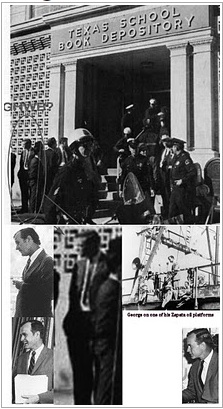
George H.W. Bush was working for the CIA at least as early as 1961; more than likely he was recruited in his college days, at Yale, when he was in the Skull and Bones Society. He and his wife Barbara moved to Houston where he ran an offshore oil drilling business, Zapata Offshore Co., which was a CIA front company with rigs located all over the world, making it very convenient for him to vanish for weeks at a time on CIA business where one would suspect what he was doing. Bush was a major organizer and recruiter for the Bay of Pigs invasion, which was codenamed Operation ZAPATA. Col. Fletcher Prouty, former Pentagon high ranking official, who was the basis for the “Col. X” character in Oliver Stone’s “JFK”, obtained two Navy ships for the operation that were repainted to non-Navy colors and then renamed HOUSTON and BARBARA.
George H.W. “Poppy” Bush is one of the few who could never recall where he was or what he was doing when JFK was assassinated; as a matter of fact, for over 20 years, he could not recall any details at all. He was 39 years old at the time andchairman of the Harris County (Houston) Republican Party and an outspoken critic of JFK. But on 21 November 1963, GHWB was staying at the Sheraton Hotel in downtown Dallas and spoke that very evening to the American Association of Oil Drilling Contractors. Some time later, he was reportedly at “the ratification meeting” at the home of Clint Murchison, Sr., receiving last minute instructions and toasting JFK’s murder the night before it happened. [NOTE: Madeleine Duncan Brown has written about this event in her book, Texas in the Morning (1997). It was corroborated by Nigel Turner in Part 9, “The Guilty Men”, of “The Men who Killed Kennedy”...
The Men Who Killed Kennedy[Part 9]The Guilty Men (2003) [Uploaded by otingocni06 on Mar 6, 2011]
The Men Who Killed Kennedy is a video documentary series by Nigel Turner that originally aired in 1988 in England with two one-hour segments about the John F. Kennedy assassination. The United States corporation, Arts & Entertainment Company, purchased the rights to the original two segments. Three one-hour segments were added in 1991. A sixth segment was added in 1995. Finally, three additional hourly segments were added by the History Channel in November 2003. The ninth segment, titled "The Guilty Men", directly implicated Lyndon B. Johnson. Within days, Johnson's widow, Lady Bird Johnson, more of his surviving associates, ex-President Jimmy Carter, and the lone, living Warren Commission commissioner and ex-President Gerald R. Ford immediately complained to the History Channel. They subsequently threatened legal action against Arts & Entertainment Company, owner of the History Channel. "The Guilty Men" segment was completely withdrawn by the History Channel. Also during the series, French prisoner Christian David named Lucien Sarti as one of three French criminals hired to carry out the assassination of Kennedy, when he was interviewed by author Anthony Summers. This claim is one of the most strongly investigated theories presented on the show.
---------------------
Deputy Sheriff Roger Craig reported to Jim Garrison he knew of twelve arrests made in Dealey Plaza that day. One, in particular, was made by R.E. Vaughn of the Dallas Police Department, was of a man coming out of the Dal-Tex Building, who said he was “an independent oil operator from Houston, Texas.” The prisoner was taken from Vaughn by Dallas Police detectives, and that was the last he saw of him: no mug shot, no interview, no fingerprints, or name is in existence of this mystery man. “Independent oil operator from Houston” was always George Bush’s (CIA) cover. Exactly why was he arrested? Garrison reported the man came running out of the Dal-Tex building and authorities could hardly avoid arresting him because of the clamor of onlookers. He was taken to the Sheriff’s Office for questioning, although there is no record of it. Afterward, two officers escorted him out of the building to the jeers of the waiting crowd. They put him in a police car and he was driven away; presumably right back to Dealey Plaza, because that is where he would be photographed with USAF Gen. Edward Lansdale.

Ed Landsdale was identified walking past “the three tramps” (center) by no less authorities than L. Fletcher Prouty, the liaison between the Pentagon and the CIA for covert activities–who was the basis for the figure, “Col. X”, in Oliver Stone’s “JFK”, and Victor Krulak, former Commandant of the Marine Corps, both of whom knew him well.
.jpg?timestamp=1438464496906)
As for the identity of GHWB, we have these observations from Ralph Cinque, a professional chiropractor, who is an expert in dealing with person’s bodies and clothing, “The case for George HW being there is cinched. What’s the serious alternative? That a simply amazing coincidence occurred in which a man who looked strikingly like him just happened to be there? How many times does V (for Vendetta in the film, “V for Vendetta”) have to tell us that he, like God, does not play dice and does not believe in coincidences? Neither do I or any other serious student of murder, especially not when it involves the JFK assassination.” We have a photo of him standing in front of the Texas School Book Depository; we have photos of Ed Lansdale in Dealey Plaza at the time; and we have yet another in which Lansdale, who was famous for arranging assassinations around the world, is waiting to speak to him. In this case, it may justifiably be said that “these pictures really are worth more than a thousand words”.
The Phony Alibi
The next that we hear of George H.W. Bush on 22 November 1963 comes from an FBI Memorandum according to which GHWG, having been cut loose from his anonymous interrogation at the Dallas Sheriff’s Office, called into SAC Graham W. Kitchel of the FBI Office in Houston alleging was establishing a phony alibi in saying he recalled hearing, in recent weeks, a man named James Parrott talking of killing the President when he came to Houston. Shortly after Bush made this call, FBI agents were dispatched to the Parrot house. In another FBI memo Parrot’s mother said James, who was not home when the FBI arrived, had been home all day helping her care for her son Gary.
Mrs. Parrot advised that shortly after 1 PM a Mr. Reynolds came by and talked to her son about painting some signs at Republican Headquarters on Waugh Drive. The net effect was Kerney Reynold’s, George Bush’s assistant, gave Parrot an alibi and Parrot was Bush’s alibi; everyone’s ass was covered. A bogus phone call reporting a would-be assassin who was one of Bush’s Republican Party sign-painters; who himself is also freed by an alibi from one of Bush’s buddies, really doesn’t cut it; this is CIA Alibi 101. This type of stuff cannot be allowed to stand in history; if Bush was so concerned about his sign painter, why didn’t he call in to alert the FBI before President Kennedy came to Dallas?
Bush has handed us his head on a silver platter with this memo; that’s why he always said he didn’t remember what his was doing on 11/22/63; he was hoping this incredibly stupid memo never surfaced. Bush was worried he had been seen and subsequently panicked and stupidly called the FBI, thinking he was being clever by providing evidence that it wasn’t him that was arrested in front of the Dal-Tex building that day. It seemed like a good idea, at the time, but he was actually creating a permanent record of his involvement. The memo identifies Bush as an oil man from Houston placing a long distance call from Tyler, Texas. Bush was trying to establish he was not in Dallas during, or shortly after, the assassination. He must had been worried that someone would identify him as the oil man detained running out of the Dal-Tex building and being ushered in and out of the Dallas Sheriff’s office.
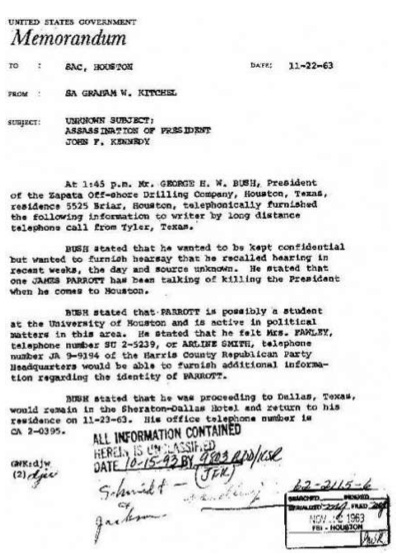
This FBI memo (above), dated 22 November 1963, states that Bush called from Tyler, Texas but there is no proof he was actually there. For over 20 years after the assassination, Bush said he did not remember where he was when the assassination took place at 12:30 PM in Dallas. The only other person of whom I hae heard such a story was Richard Nixon, who flew out of Love Field just two hours before JFK flew in.
Conspicuously, this FBI memo fails to provide an answer to where George Bush actually was. The memo, however, does tell us that the first moment Bush was free to create a phony alibi was at 1:45 PM. Bush was staying in downtown Dallas at the Sheraton Hotel, just few blocks from Dealey Plaza, yet he’s trying to tell us he was in Tyler, Texas at 1:45 PM.
George Bush’s CIA assignment was obviously in Dallas, that’s why he was staying there, so what would he have been doing in Tyler? JFK had just been shot at 12:30 PM. Would Bush not have been in Dallas at 12:30 PM as well, like everyone else, which was presumably the reason for him having been in town at the Dallas Sheraton Hotel? Would Bush not have driven down the road to Parkland Hospital, to check on the President’s condition; like everyone else? Except Bush was being interrogated at the Sheriff’s Office.
THE FBI MEMORANDUM
Bush appears to be a candidate for prosecution for treason: his alibis for 22 November 1963 are fabricated and we have evidence that shows he was there. An FBI memo of a call from Tyler Texas does not prove his location, except that he had concocted a textbook CIA alibi, that he was lying and probably was an accessory to JFK’s murder. Bush maintained for over twenty years after the assassination that he simply did not remember what he was doing at the time of the assassination. As a matter of fact, he had no explanation even in his autobiography; and then, all of a sudden, he concocted a story that he was speaking in Tyler, Texas to The Rotary Club. Aubrey Irby said Bush was speaking when the bellhop came over and informed Aubrey that JFK was dead. Mr. Aubrey passed the info on to Mr. Wendell Cherry Irby, who passed it onto Bush, who stopped his speech. According to Irby, Bush explained he thought a political speech was inappropriate under the circumstances, concluded speaking and simply sat down.
It is inconceivable that George Bush could not have recollected this event for more than 20 years. Walter Cronkite’s announcement to the world that JFK was dead came on TV at 1:38 PM. Does anyone think that Bush was making a speech at that time, in Tyler, Texas, to the Rotary Club, after the President and Governor Connally were known to have been shot at 12:30 PM? President Kennedy had been scheduled to give a speech for lunch at the Dallas Trade Mart, after he passed through Dealey Plaza. Everyone who was anyone around Dallas was going to attend that speech; and after JFK was shot, most rushed to Parkland Hospital to find out the latest news concerning the gravely wounded President and Governor. A speech being given in Tyler, Texas, inside a building owned by right wingers, to a group of Republican JFK haters, hardly qualities as evidence Bush was not in Dallas, where the available evidence suggests that he was on assignment for the CIA and was supervising the Dal-Tex hit team, from which three shots appear to have been fired with a Mannlicher-Carcano, which appears to have been the the only non-silenced weapon that was used:

Bullet hole/Doorway Man/Dal-Tex window/Danny Acre and Johnny Rosselli(?)
Next... George Bush can be seen in photos of Dealey Plaza, next to the TSBD doorway and Ed Lansdale, shortly following the assassination (see below). These photos, unmistakably George Bush, tell us where he went after he left the Dallas Sheriff’s Office: back to the crime scene to get an update on all that he had missed. He must have made his call to the FBI reporting James Parrot from the Dallas Sheriff’s Office, at 1:45 PM, becauseBush is seen in Dealey Plaza with Lansdale, who would leave the plaza at about 2 PM and walk past “the three tramps” toward the parking lot. Bush obviously had to go straight back to Dealey Plaza for him to be photographed with Lansdale, who remained around Dealey Plaza until Oswald was arrested at the Texas Theater at 1:50 PM. If Lee had not been arrested, then Lansdale, as “Plan B”, might have framed the three tramps–Charles Rogers, Charles Harrelson and Chauncey Marvin Holt (often misidentified as E. Howard Hunt)–who had been directed to go to a boxcar and the assassination have been blamed on them. Holt (CIA), the tramp with the hat, reported that they were found in the box car and taken through the plaza right after Oswald was arrested, which he knew because he was listening in, on a CIA provided radio concealed inside the paper bag that he is carrying in the familiar photos.
AN INCRIMINATING MEMORANDUM
 An FBI Memo from director J. Edgar Hoover (to the right), discovered by John McBride in 1988 but written just seven days after the assassination, provides verification George H.W. Bush was an officer of the CIA in 1963 and was provided updates on the anti-Castro Cubans. George Bush has said this memo was referring to another “George Bush” because he wasn’t in the CIA at the time. But while there was another man by that name, he was a file clerk and would not have been receiving a memorandum about the Bay of Pigs operation. And other information has surfaced showing the George Bush in the document was indeed George H.W. Bush and had the same address. In 1976, President Ford appointed George Bush as the Director of the CIA, replacing William Colby. Bush served in this role for 357 days, from 30 January 1976 to 20 January 1977. Bush falsely testified before Congress that he had never worked for the CIA, and it was widely reported that this was the first time that a civilian would be appointed to run the agency. But that was more poppycock from Poppy. George Bush appears to have been a CIA lifer, probably recruited right out of Yale.
An FBI Memo from director J. Edgar Hoover (to the right), discovered by John McBride in 1988 but written just seven days after the assassination, provides verification George H.W. Bush was an officer of the CIA in 1963 and was provided updates on the anti-Castro Cubans. George Bush has said this memo was referring to another “George Bush” because he wasn’t in the CIA at the time. But while there was another man by that name, he was a file clerk and would not have been receiving a memorandum about the Bay of Pigs operation. And other information has surfaced showing the George Bush in the document was indeed George H.W. Bush and had the same address. In 1976, President Ford appointed George Bush as the Director of the CIA, replacing William Colby. Bush served in this role for 357 days, from 30 January 1976 to 20 January 1977. Bush falsely testified before Congress that he had never worked for the CIA, and it was widely reported that this was the first time that a civilian would be appointed to run the agency. But that was more poppycock from Poppy. George Bush appears to have been a CIA lifer, probably recruited right out of Yale.
George H.W. Bush (CIA) was also a close friend with George De Mohrenschildt (CIA), including they were both members of the Dallas Petroleum Club. After De Mohrenschildt was found shot to death the day before he was to be questioned by Gaeton Fonzi for the HSCA reinvestigation of the deaths of JFK and MLK in the late 1970s, Bush’s name and address were found in De Mohrenschildt’s address book: “Bush, George H.W. (Poppy) 1412 W. Ohio also Zapata Petroleum Midland.” CIA documents reveal that during the planning of the Bay of Pigs Operation (Operation Zapata), De Mohrenschildt made frequent trips to Mexico and Panama and gave reports to the CIA. His son-in-law also told the Warren Commission that he believed De Mohrenschildt was spying for the planned Cuban invasion. George De Mohrenschildt, notably, was Lee Harvey Oswald’s best friend and appears to have been his handler after Oswald was brought to Dallas in the fall of 1963 and would find work at the TSBD.
Was Bush in the Window?
In The Killing of a President (1994), Robert Groden observes that a dark-complected man was seen in the window whom James Richards has identified to Jim Fetzer as having been Nestor “Tony” Izquierdo, for whom there is a statue in Freedom Park of “Little Havana”, Miami, Florida. He was an anti-Castro Cuban, whom GHWB may have known from the Bay of Pigs. I have built upon the prior research of Duncan MacRae, “Dal-Tex Shooter 2nd floor”, which provides the most suggestive interpretation of the location from which three rifle shots appear to have been fired:
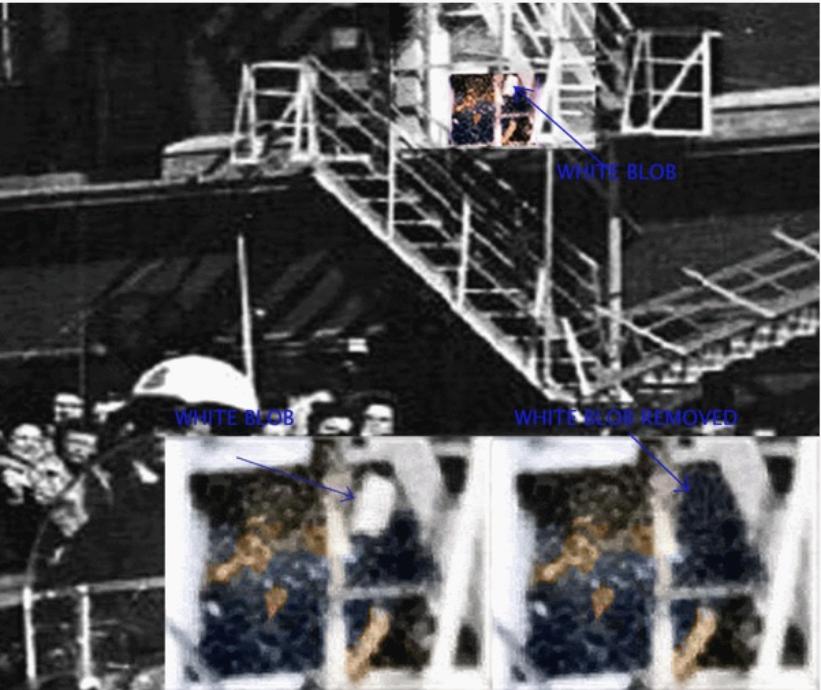
DAL-TEX SHOOTER 2ND FLOOR
Given that Bush was in the building at the time, I infer that he was there in the background, inside the window of a broom closet of a uranium mining company on the second floor of the Dal-Tex building (which was a CIA asset). My interpretation is that someone with GHWB’s preppy haircut, large left ear, tall height, body language (head tilt), hairline part and forehead profile, was supervising the Dal-Tex hit team (see collage below). He was in Dallas for a reason, which was not to watch the presidential motorcade, and appears to have been a supervisor rather than a shooter, were it is very likely he was communicating using a radio device with a spotter. That spotter may have been Danny Arce (CIA), who can be seen speaking into a walkie-talkie, out on Houston Street (in the Altgens6 photo above), standing next to Johnny Roselli (CIA/Mafia). Arce was talking with someone as multiple shots were fired. Ruth Ann (CIA) was reported (by complicit witness Loy Factor) to have been counting down a cadence and to have been receiving information by walkie-talkie from the 6th floor of the TSBD.

The DAL-TEX Hit Team
Umbrella Man’s companion, possibly Orlando Bosch (CIA) [NOTE: or Filipe Vidal Santiago], was not talking on his radio as limousine passed the Stemmons Freeway sign and the Umbrella man pumped his umbrella up and down, which appears to have been a signal to “keep firing” because the target was still alive. [NOTE: It was at a location that was visible from all of the shooting locations that I have identified above.] Chauncey Holt (CIA), the oldest of the tramps, said he had a CIA supplied radio, concealed in his brown paper bag that kept him updated on events even from inside the Rock Island Railroad boxcar. Holt had delivered 15 sets of fake Secret Service ID and left them in a red pick-up truck parked in the lot behind the grassy knoll, which was used by the Dallas Police Department, earlier that morning, facilitating the escape of the grassy knoll shooters. And Lee Bowers, the railway tower switchman, also testified to the Warren Commission that he observed strange people driving behind the picket fence and noticed one using a walkie-talkie.

Proof Sketch GWHB was there
(1) The FBI report (memo) Bush called in at 11/22/63 1:45 PM identified him as an oil business man from Houston, Texas and the FBI office he called was the Houston office.
(2) The man arrested running out of the Dal-Tex building at approximately 12:35 PM on 11/22 was said (per Deputy Sheriff Roger Craig) to have identified himself as “an oil man from Houston”. Bush was arrested by R.E. Vaughn of the Dallas Police Department.
(3) Bush called his FBI warning about James Parrot by long distance to his friend, FBI Special Agent Graham W. Kitchel, at the FBI office in Houston.
(4) James Parrot had no history as a subversive but was a sign painter for George Bush’s Republican Senate campaign.
(5) James Parrot was quickly provided an alibi by another friend, who was also an assistant of Bush, Kerney Reynolds.
(6) George Bush was staying in Dallas at the downtown Sheraton Hotel and had spent the previous night (of the 21st) there.
(7) There are at least two photos of George Bush (CIA) in Dealey Plaza speaking with police shortly after JFK was shot at 12:30 PM.
(8) One of those photos has Bush (CIA) standing next to Ed Lansdale (CIA).
(9) One of the photos shows Bush near the TSBD doorway in a zone police had cordoned off, which would have taken special ID (CIA).
(10) The photo next to Lansdale most likely was taken between 1:45 PM, when Bush called in his bogus FBI memo, and 2 PM, when Lansdale is pictured exiting the plaza passing the three tramps. The tramps were taken from the boxcar at approximately 1:50 PM, when Oswald was arrested at the Texas Theater.
(11) For over 20 years, George H.W. Bush said he did not remember what he was doing during the assassination, then he suddenly remembered he was giving a speech to the Rotary Club in Tyler at 1:38 PM, while his FBI call reporting James Parrot was placed at 1:45 PM.
(12) His attendance with Malcolm “Mac” Wallace at Yale, when “Mac” was LBJ’s personal hit man, and his attendance at the ratification meeting at the home of Clint Murchison, Sr., are powerful circumstantial evidence of his complicity in the assassination of JFK.
POSTSCRIPT
Remarkably, there is a figure (in the DCA film) walking off the corner of Houston & Elm and toward the Dal- Tex building, where “the oil man from Houston” (George H.W. Bush) had been arrested minutes earlier, who looks a great deal like his son, 17 year old George W. Bush. This figures ear, nose (where a crude effort to change the nose has been made in the second of these three images), bridge indent and jawline are a very close match to George W. Bush, where the preppy loafers and white sox he’s wearing are cheerleader appropriate. It looks like W. was there, too.

Richard M. Hooke, a student of anthropology at UC Santa Barbara and former computer systems analyst for Bank of America, is also a writer and researcher regarding the death of President John F. Kennedy.
Jim Fetzer, a former Marine Corps officer, is McKnight Professor Emeritus at the University of Minnesota Duluth and a columnist and editor for Veterans Today.
===========================================
=============================
==============
JFK Assassination Revelations ... a Compilation of Conspiracy ... [Published on Nov 24, 2013]
JFK Assassination Revelations - Compilation of Conspiracy [Published on Nov 24, 2013]
[https://www.youtube.com/watch?v=OvSYMOsTNR0]
Upload Credit to Joe Friendly [https://www.youtube.com/channel/UCl76uF5GIuimTYxe-JjdsLA]
Compiled from youtube videos listed below here is collected a coherent explanation of the responsibility of elements of the US government in league with the Mafia for assassinating President John F. Kennedy. The 58 minute length was for presentation on cableTV Public Access show Truth For A Change in Manhattan on November 22, 2013 produced by Joe Friendly.
sources:
JFK assassination: Secret Service Standdown http://www.youtube.com/watch?v=XY02Qkuc_f8
The JFK Assassination: What really happened http://www.youtube.com/watch?v=A75PmAvBV38
JFK Assassination Anniversary And Conspiracies http://www.youtube.com/watch?v=GqV7Pdwiel4
Conspiracy Theory with Jesse Ventura http://www.youtube.com/watch?v=EJHWvqR03xs
[https://www.youtube.com/watch?v=OvSYMOsTNR0]
=============================================
==========================================
========================================================
========================================================================
The API Zippo… ‘n’HiRes…
Posted on February 12, 2016 by JFK Revelations
http://jfkassassinationimages.net/index.php/2015/08/27/josiah-thompson-re-the-moorman-copies/
Josiah Thompson re: the Moorman copies
AUGUST 27, 2015 BY ROBIN·0 COMMENTS
To view photo’s full size ( right click mouse then click on view image )
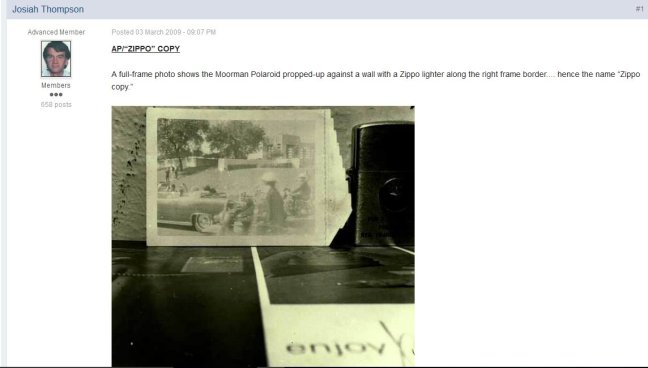
![Cropped_version_of_Zippo_snapshot[jfkassassinationimages.net][799x685]](https://jfkrevelations.files.wordpress.com/2016/02/cropped_version_of_zippo_snapshotjfkassassinationimages-net799x685.jpg?w=648)
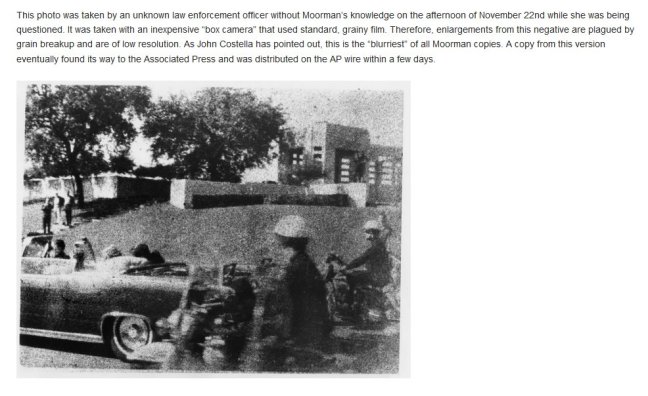
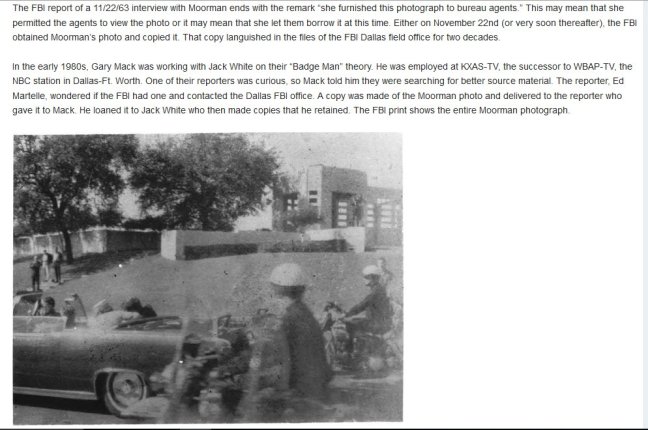
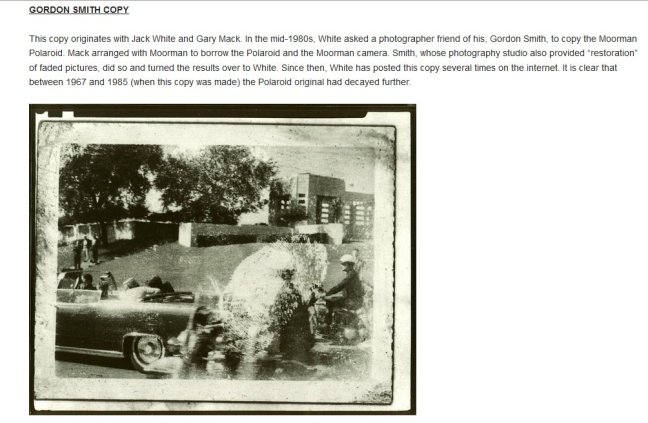
Josiah Thompson (The history behind the Drumscan)
‘ll try to explain. In the spring of 1967, I was done with my LIFE assignment and was putting together all the details that went into Six Seconds. Mary Moorman’s photograph was extremely important since it showed the knoll at Z 315. I had done some research with AP and Wide World in New York concerning the negatives and prints of the photo that they had. But the original Polaroid was sitting in Dallas. I paid Mary Moorman for the use of her photo in Six Second. Part of the deal was that she would let a professional photographer come to her house and copy the Polaroid. I hired a professional photographer to do this. He went to her home and copied the Polaroid using a medium format camera where the negative itself is about the size of Moorman’s Polaroid. It was that negative from forty-five years ago that I had scanned in San Francisco. The drum scan resulting may turn out to be the highest resolution copy of the Moorman photo extant since the Polaroid itself has deteriorated further with each passing decade.
Coverups November 1984 “Mary Moorman” Gary Mack
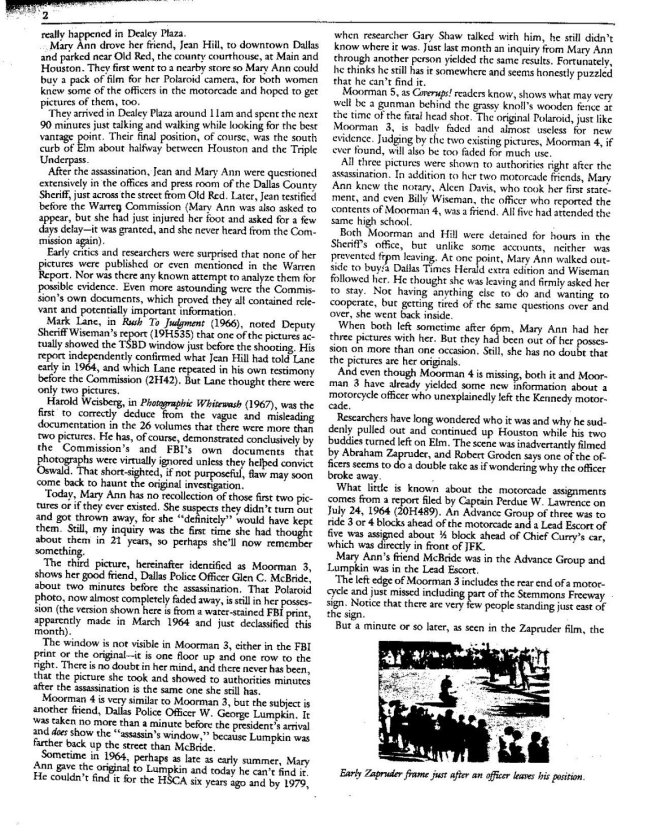
Mary Moorman turning to the left to follow the limo
AUGUST 27, 2015 BY ROBIN·0 COMMENTS
To view photo’s full size ( right click mouse then click on view image )
We know Mary turned her body to follow the limo
while Mary Moorman is facing forward her blue coat remains closed.
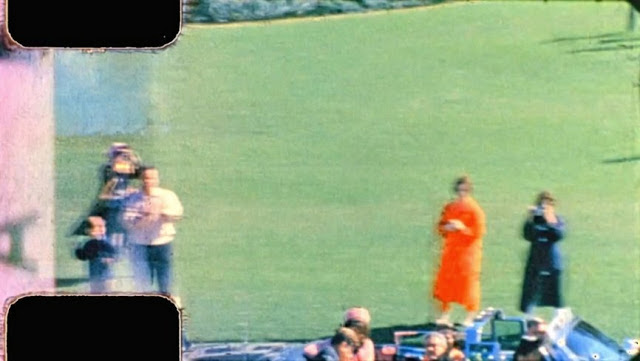
As Mary turns her body to the left to follow the limo with her camera, the wind catches her blue coat and starts blowing it open.
Also it is obvious that the position of her arms change as she turns left…
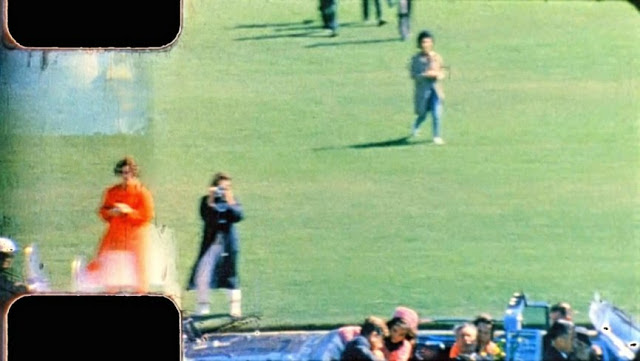
Zapruder GIF i made using the two frames shown above (stabilized on Mary)
http://jfkassassinationimages.net/index.php/2015/08/27/mary-takes-on-the-federal-government/
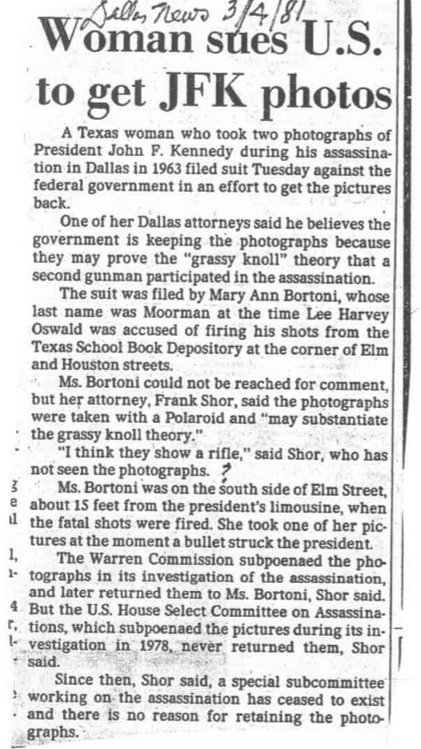
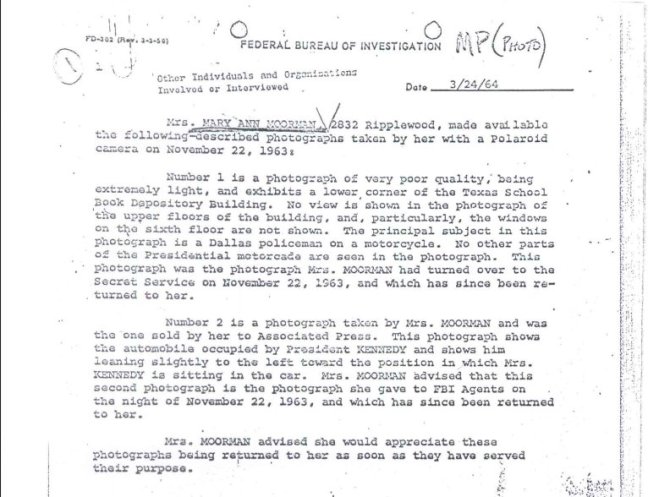
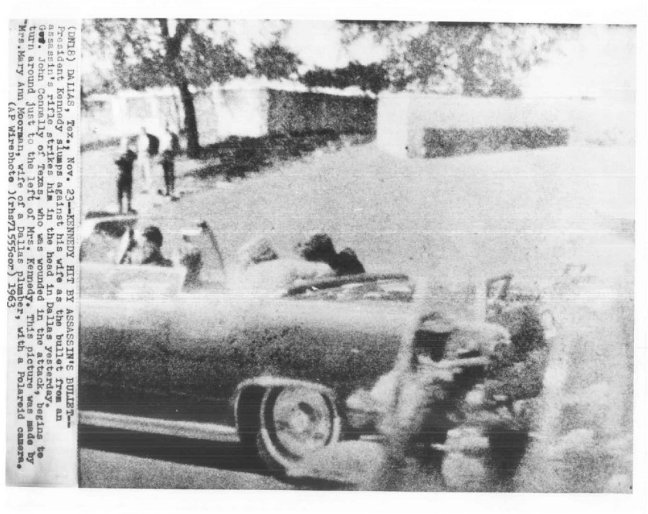
http://quaneeri2.blogspot.com/2015_08_01_archive.html
========================================================
Sunday, 16 August 2015
Cinque plays the alteration card (UPDATE 2)
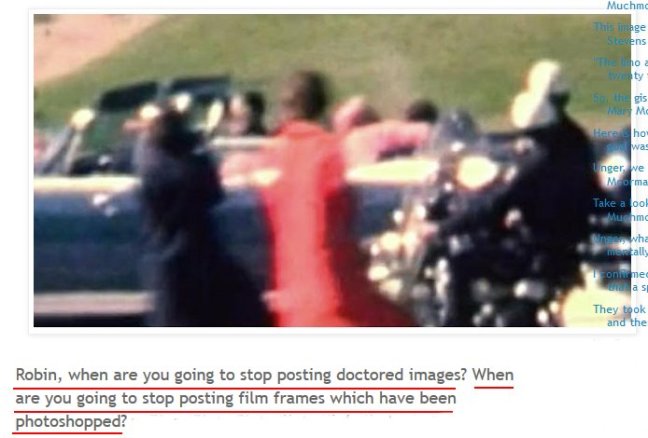
The frames came from the PBS Nova “Cold Case JFK” Documentary HD 720P
http://www.dailymotion.com/video/x17pwl3_pbs-nova-2013-cold-case-jfk_school
Make sure you change the HD setting to 720P
Then you can apologize for saying that i posted Doctored and Photoshopped frames.
And so you don’t have to do your whole “pause” freeze frame YouTube crap, where you couldn’t save a decent frame to save your life.
And because i am so sick of looking at your piss poor, dark, fuzzy, YouTube Muchmore frames, i will tell you how to download it.
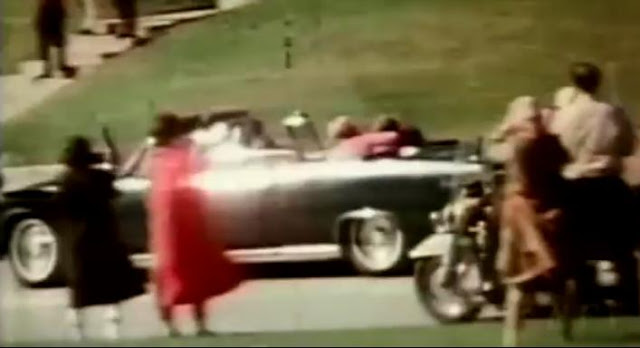
Download Firefox Browser, and then search for the “Flash video downloader plug in” in Add-Ons
that “plug in” will then allow Firefox browser to save the video to file
Then download “Media Player Classic” and “ffdshow codec pack”
that combination then allows you to Pause the film, and advance the film one frame at a time, and save each frame to file
http://download.cnet.com/Media-Player-Classic-Home-Cinema/3000-13632_4-199375.html
http://ffdshow.en.softonic.com/
If you can’t do that, then you have no right doing photo analysis on the assassination films.
and it will show that you are just another two bit amateur playing at being a JFK photo researcher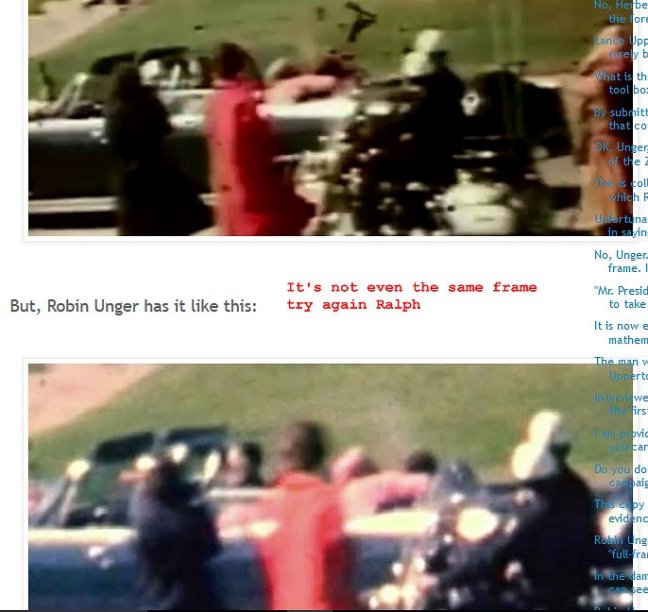
Are you blind Ralph try this frame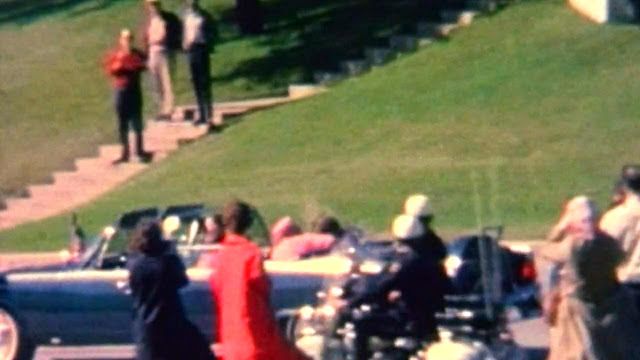
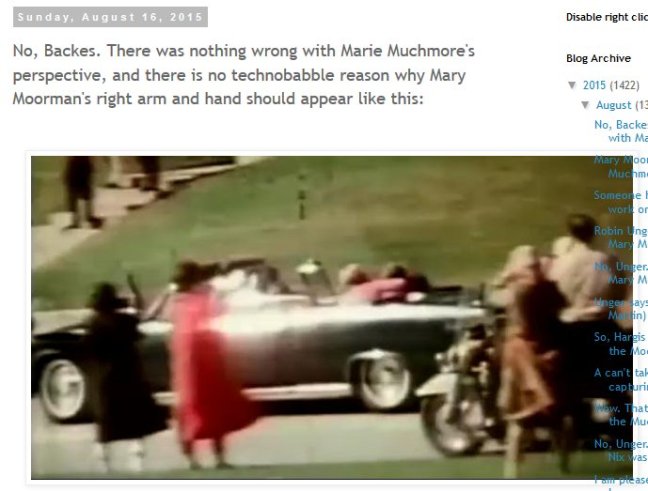
More crap YouTube Muchmore frames from Cinque
Try this Version
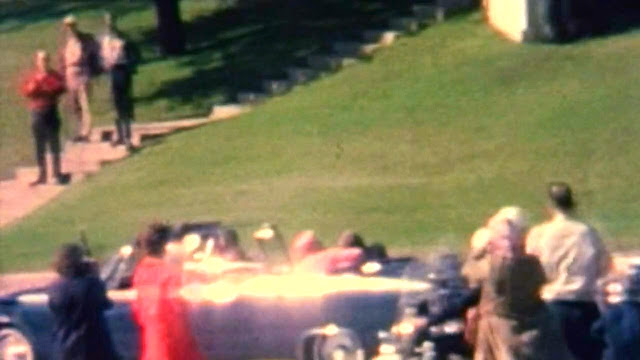
Saturday, 15 August 2015
Motorcycle height (UPDATE)
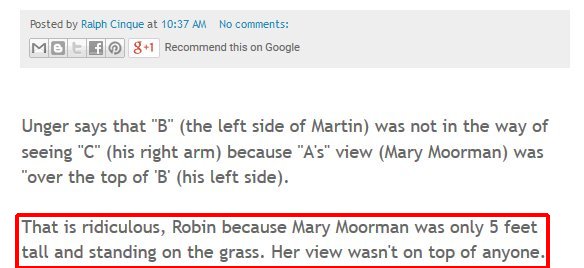
Bill Miller’s research proved that the overall height from the ground to the top of the motorcycle windshield was 58- inches
The curb was approx 8-inches high and Mary Moorman was 60-inches high ( Total=68 inches )
Mary Moorman’s camera hight was estimated to be approx 62-inches
quote:
At about the same time, Bill Miller came up with a proof of dazzling simplicity.
Dr. John Costella’s work showed clearly that Moorman camera’s lens was looking down on the tops of the motorcycle windshields and the strut over the top of the limousine. “In other words,” Dr. Costella explained, “her camera was pointed very, very slightly ‘downwards.'” From this it follows that the Moorman camera was positioned higher than the top of the limousine and the tops of the motorcycle windshields. How high was the top of the limousine? Numerous sources give the height as 57 inches. How high were the tops of the motorcycle windshields? Here Miller became quite ingenious. He got in touch with a motorcycle museum in Sturgis, North Dakota which had one of the Dallas motorcade motorcycles on display. The museum properly inflated the tires and put a man weighing 225 pounds on the cycle. They then measured the distance to the top of the windshield. It was 58 inches. Given the eight-inch curb, Moorman’s camera as shown in the Zapruder film was most likely at a height above the pavement of at least 61 or 62 inches. Had she taken her
photo from the street, her camera would of necessity have been located above her head!!
http://home.earthlink.net/~joejd/jfk/mgap/history.html
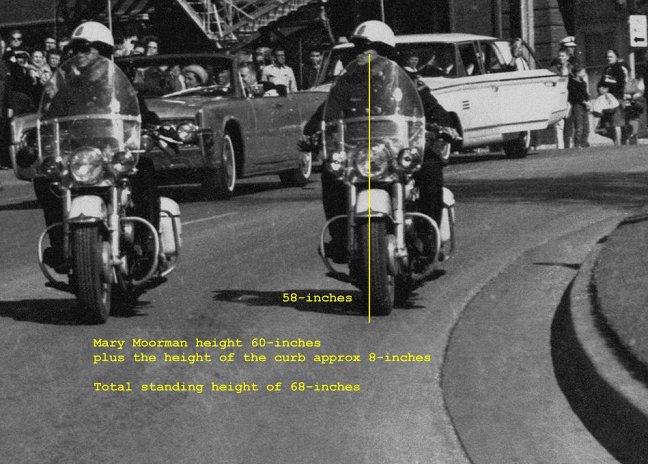
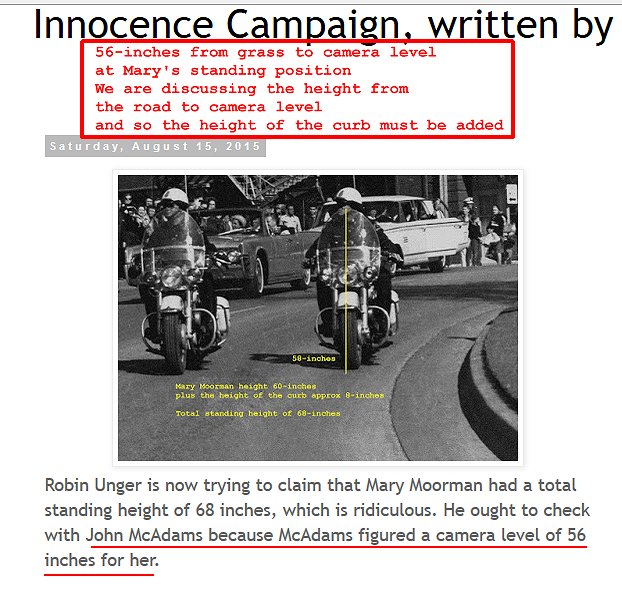
Ken McDonald composite

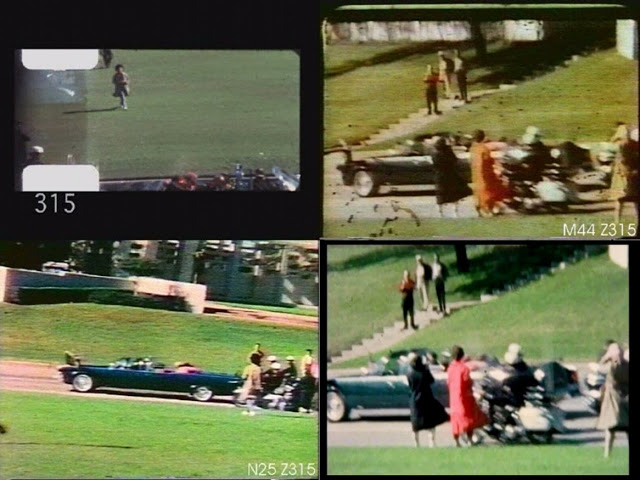
M43 Frame Showing the camera up to Mary Ann’s eye
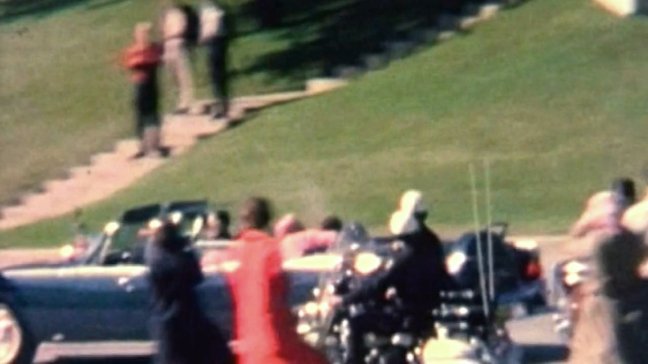
M44 Frame Showing Mary Ann lower the camera and look up.


Friday, 14 August 2015
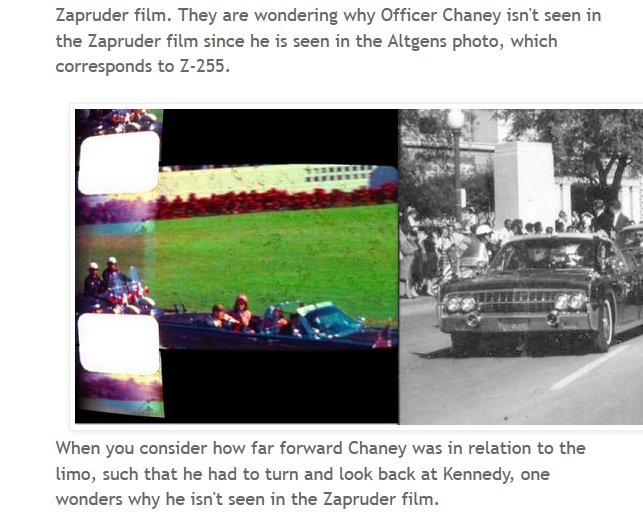


Ralph doesn’t know the difference between the Nix film, and the Muchmore film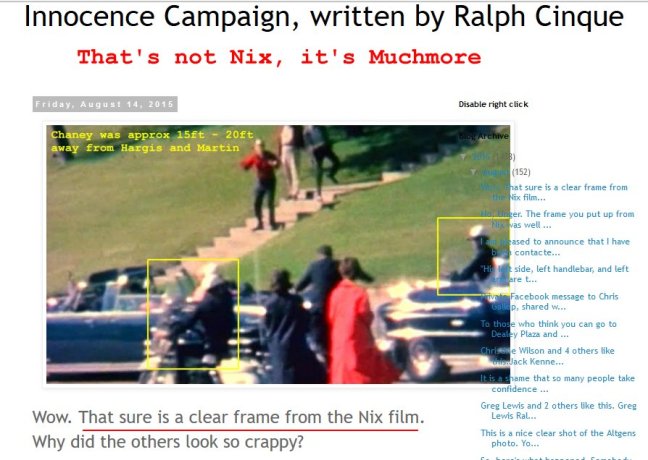
Once again, it wasn’t a Nix Frame, it was Muchmore
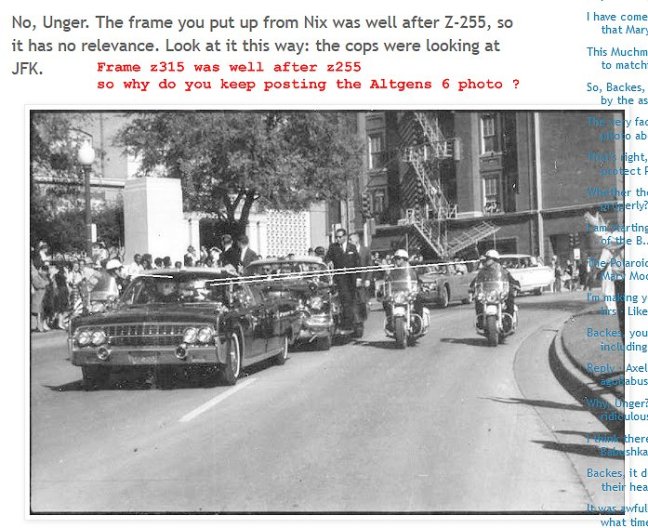

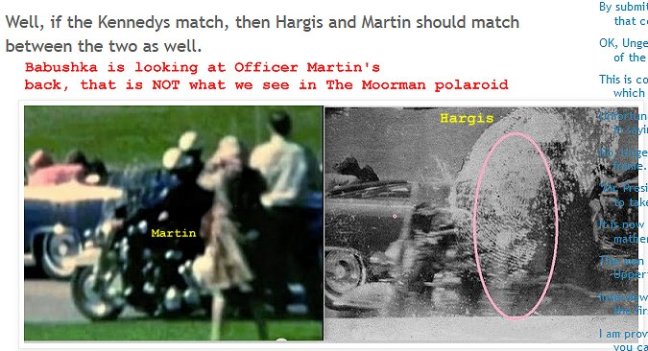
Cinque said that he is going to Dealey Plaza (UPDATE)
He is going to do an EXACT recreation of Mary Ann’s Polaroid while standing at the Babushka lady location
He said he will capture the exact viewpoint as seen in the polaroid
from the three men on the steps location across to the Bill Newman location
it will also have to show the tree location all the way across to the top of the pergola, and include the section to the right of Zapruder,
Cinque quote:
it would only count if you also duplicate what we see in the Moorman photo. You still have to capture that whole great expanse of area that is seen in the picture, from where Bill Newman was standing down to past the steps. It’s all got to be there, just like in the Moorman photo.
that’s probably why the only one who is ever going to try to do it is me. And the outcome is going to be exactly
Since the Moorman Polaroid was taken from Mary Ann’s location
and NOT the Babushka lady location, this exercise in futility is doomed to failure before it even begins.
This is the way Cinque’s photo needs to be framed
EXACTLY as shown here;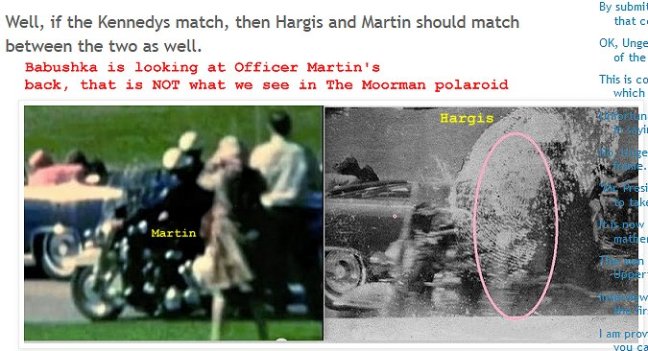
The Mack / Thompson Moorman recreation photo came close to capturing the full view, but it didn’t include all of the fencline behind the three men on the steps
That photo was taken from Mary Ann’s standing location.
Requirements:
(1) – They have to film from Moorman’s exact standing location
(2) – They have to have the photo framed exactly as we see it in the Moorman polaroid
(3) – They have to have the motorcycle in the right location, same position on elm st
same distance out from the curb.
Wednesday, 12 August 2015
Dracula coat turns into curtain ?
The so called Dracula coat combines two elements, on the left we see Martin emerging from behind Mary Ann, and on the right is Mary Ann’s coat.
Its just a composite of Martins uniform and Mary Ann’s coat.
Cinque uses the crappiest frame he could find, so that he can just make shit up /
Ammatuer hour at the Cinque “fortress of solitude” (UPDATED)
where Cinque feels safe and protected from the outside world, and can post all the crap that he just pulls out of thin air.
He knows it wont be challenged on his blog, because he doesn’t allow any comments to be posted.
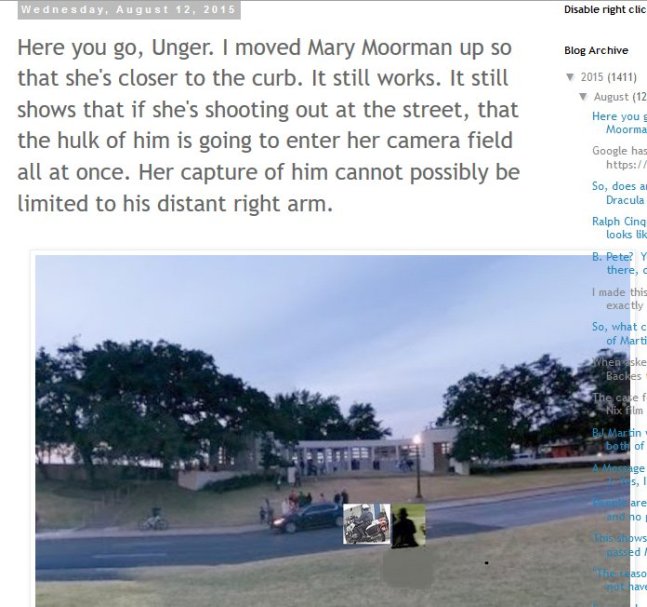
Cinque said that he moved Mary Ann’s position closer to the curb
he did no such thing, she is still in the same location, he just rubbed out the bottom half of her picture.
Another thing
look at the size of the tiny people on the other side of the road
Mary Ann looks like she is from the land of the giants
Saturday, 8 August 2015
Due to Joe Backes and Bpete having their blogs taken down
i have re-opened my blog.
Email ThisBlogThis!Share to TwitterShare to FacebookShare to Pinterest
Ralph’s own photo proves him wrong
He insisted that Mary Moorman was NOT looking down on Martins motorcycle.
his own Muchmore frame proves that she was.
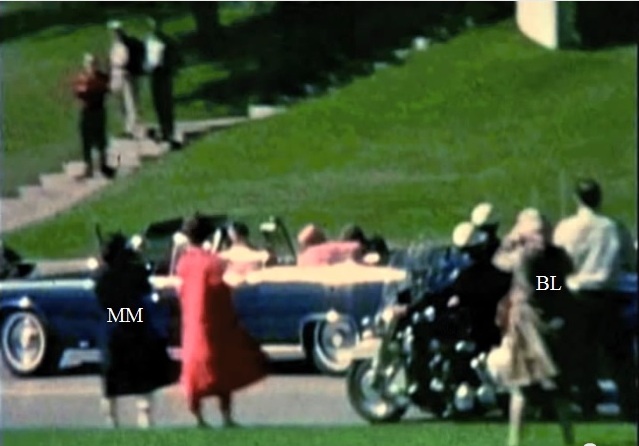
Cinque quote:
I don’t think anybody has done that in the history of humanity: be ready to take someone’s picture who was approaching from the right and not take it until he was this far past her. NEVER.
Oh Really
Have you ever heard of Altgens Ralph
quote: It stunned me so at what i saw, that i failed to do my duty and make the picture
Altgens then waited until the limo had gone past him and snapped Altgens 7
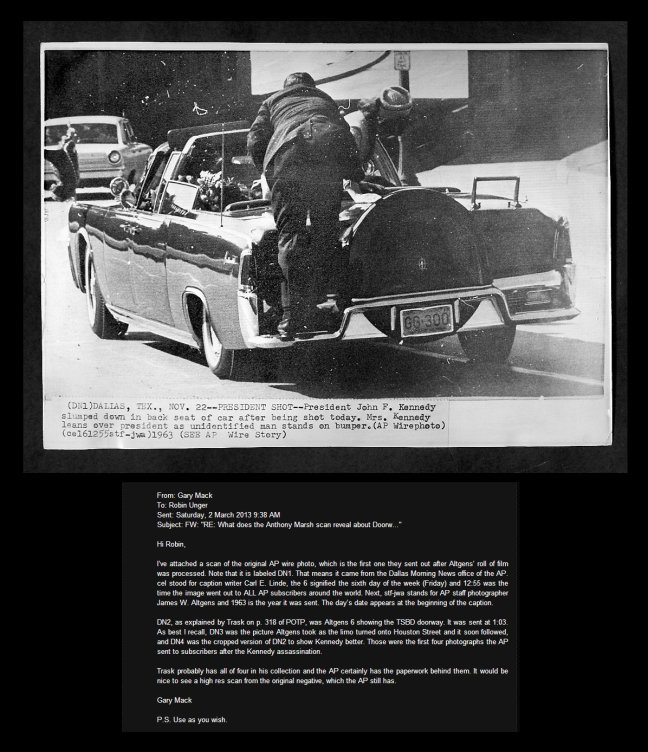

I stuffed up my frame numbering in Nix
The Ken McDonald composite below is correct
Ken’s composite frames appear in my gallery
http://www.jfkassassinationgallery.com/thumbnails.php?album=135&page=3
This Full frame is equivalent to Ken’s N25 cropped frame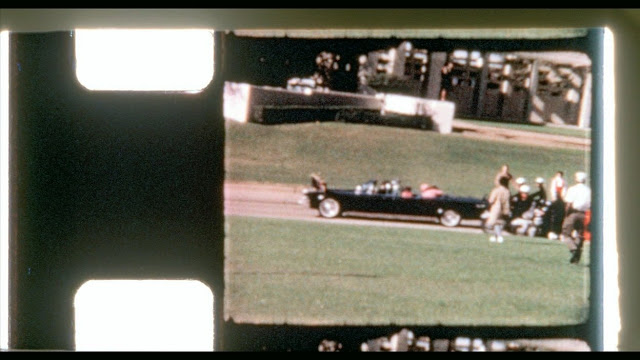
3-frame Nix GIF (N24,N25,N26)
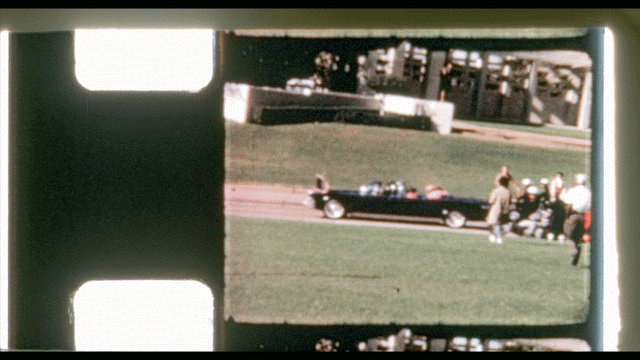
Thursday, 6 August 2015
Motorcycle composite ( UPDATE )
Showing the black tool box just behind the riders seat
This “black tool box” is what i see on Hargis’s motorcycle in Mary’s Polaroid
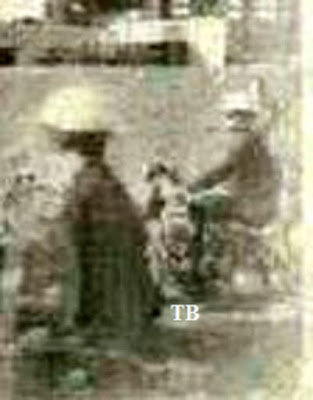
Cinque has butchered the Zippo photo
What is this garbage ?
This is how it really looks…
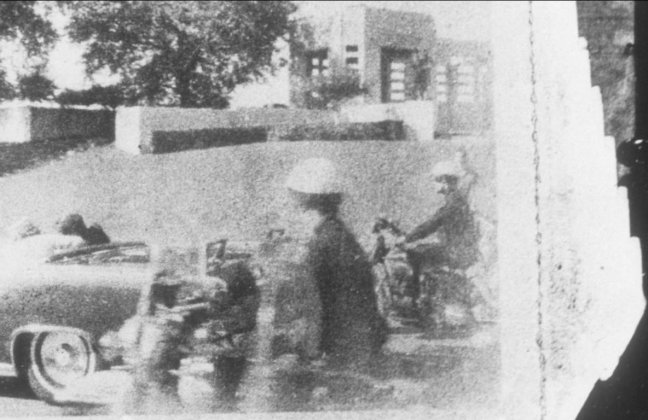
Cinque quote:
Unfortunately, Jack White was wrong in saying that the Zippo lighter image of the Moorman photo was genuine.
Ralph is wrong as usual, Clint Hill is NOT visible in this frame
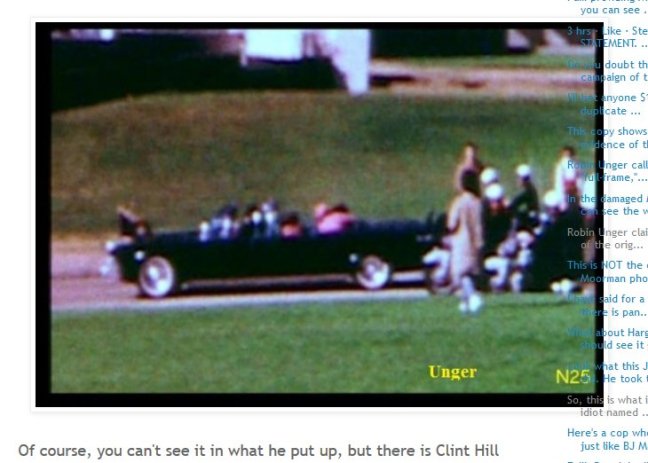
Two Nix frames showing Clint Hill as he appears from behind Mary Moorman
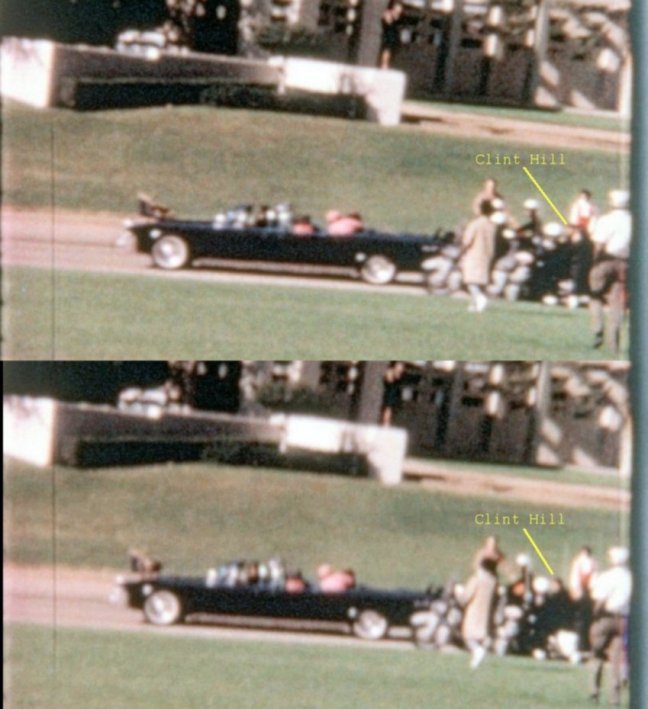
Wednesday, 5 August 2015
QUESTION
Who took the Zippo photo showing the Moorman Polaroid next to a Zippo lighter
ANSWER
After searching for hours, i thing i may have found the answer.
http://www.baylor.edu/lib/poage/white/doc.php/196925.pdf
Jack White quote:
So we are certain that the Moorman photo is genuine and never tampered with.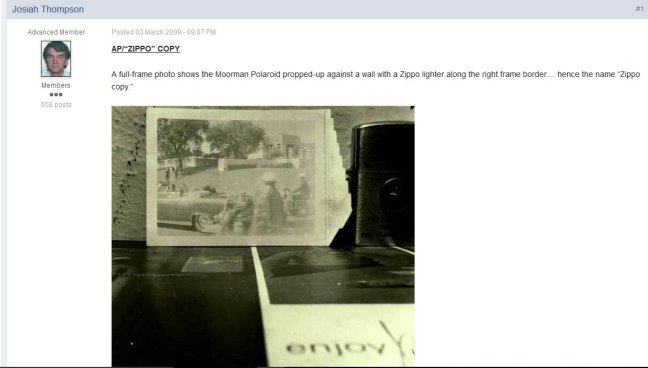
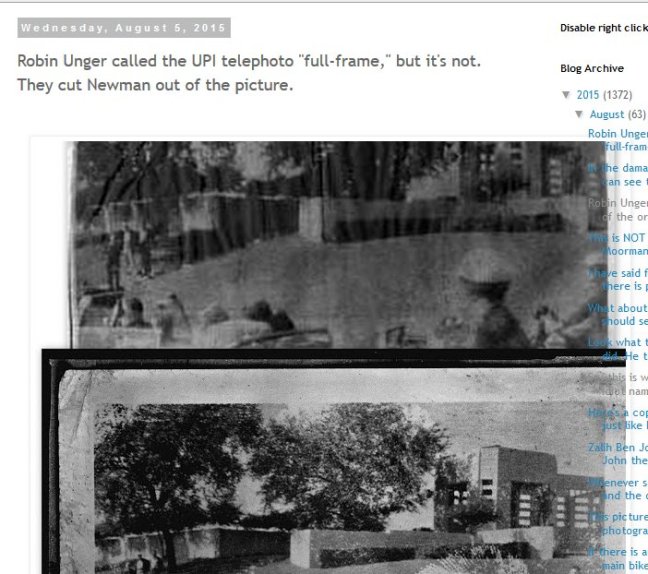
Obviously it is NOT full frame, as well as Newman being missing, so is most of the pergola area
I made no personal comments regarding a full frame.
As i pointed out in the post, the original essay came from Lancer, they were not my comments.
I posted the link, why didn’t you look at Lancer for yourself instead of jumping to conclusions.
that’s why we post links, so that you can confirm the information for yourself.
Here it is again.
http://www.jfklancer.com/moorman_essay/moorman_essay_2.html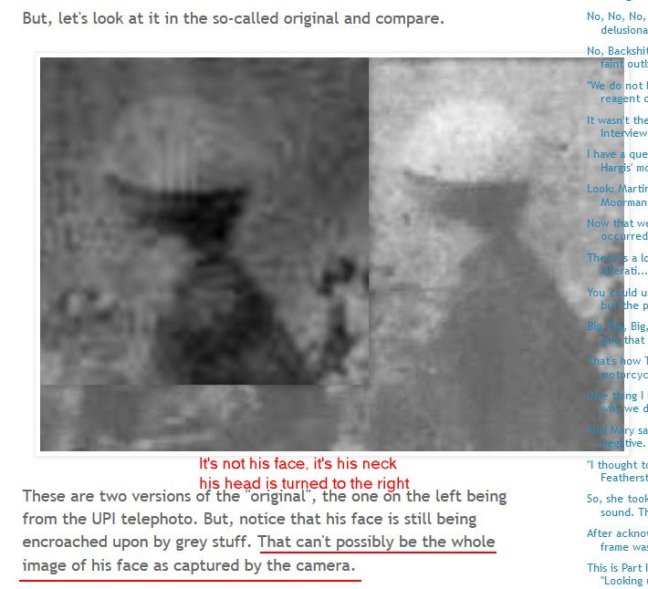

Cinque is ignorant when it comes to the JFK photographic Research history (UPDATE 3)
Who said that this Moorman copy you posted was the “ORIGINAL” Cinque. ?
are you kidding ?
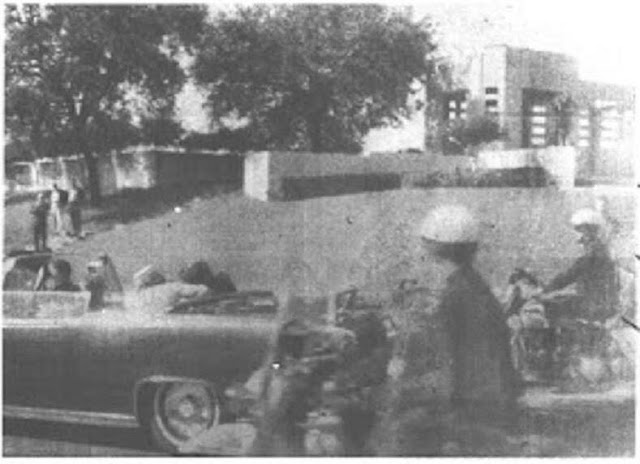
Original text Edited until i can clarify the provenance of the Zippo photo.
Josiah Thompson re: the Moorman copies
http://educationforum.ipbhost.com/index.php?showtopic=14093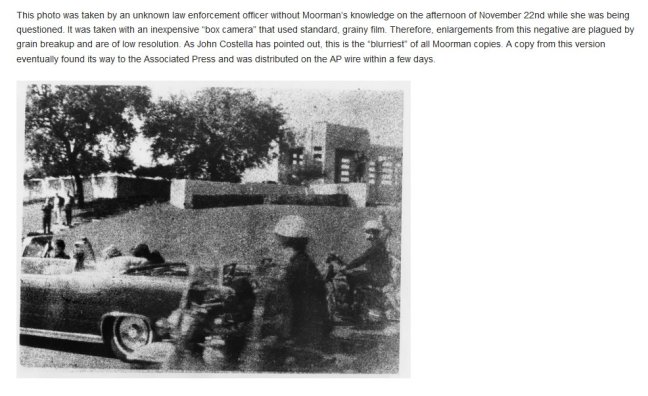
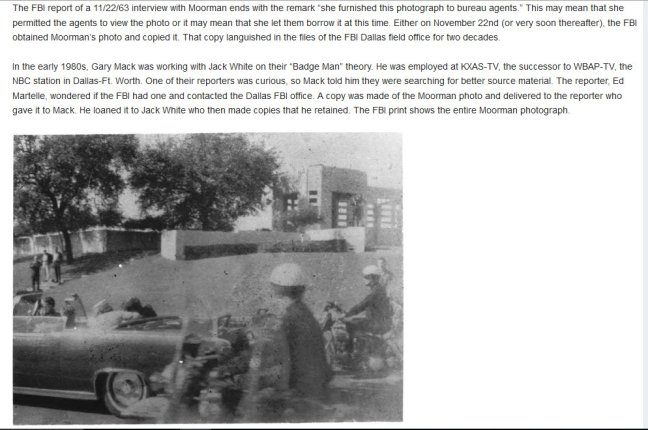
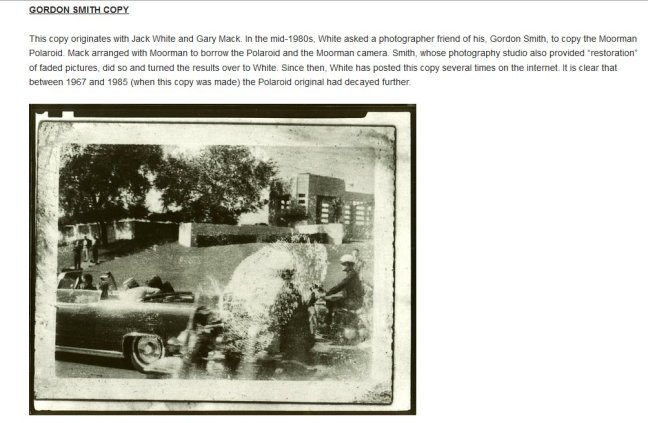
Zippo photo![Cropped_version_of_Zippo_snapshot[josiah-thompson-re-the-moorman-copies].jpg](https://jfkrevelations.files.wordpress.com/2016/02/cropped_version_of_zippo_snapshotjosiah-thompson-re-the-moorman-copies.jpg?w=648)
Mary Moorman interview
https://www.youtube.com/watch?v=usHuJpWCIgY
Zippo crop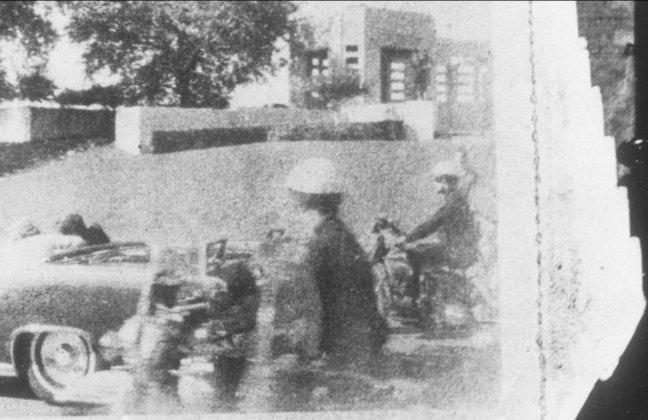
JFK Lancer
http://www.jfklancer.com/moorman_essay/moorman_essay_2.html
UPI COPY
After taking her famous photo, Mary Moorman moved back from the curb and dropped to the grass along with her friend, Jean Hill. Several photos and a WFAA news film show them sitting there. Later that afternoon, Moorman executed a Sheriff’s Department affidavit where she says, “When I heard these shots ring out, I fell to the ground to keep from being hit myself.” (19H487)
Seconds later, photos show Jean Hill’s red coat flaring as she runs up the steps of the grassy knoll. Moorman stayed on the grass. Moments later, Hill returned to find Moorman, standing at her original position and talking with James Featherston, court reporter for the “Dallas Times-Herald.” In 1993, Featherston told a reporters’ gathering what had been in his mind, “I wanted that picture, period. At the time, I thought that was the only picture in existence. Mary agreed to give me the film. I asked both of them to come back to the press room with me – which they did.” [NOTE: See ”Remarks by James Featherston at ‘Reporters Remember Conference’, Dallas, 11/20/93,” cited in “Pictures of the Pain” by Richard B. Trask (Danvers, Mass.: Yeoman Press, 1994), page 237.] Featherston spoke with the two women as they walked to Moorman’s car where she coated the Polaroids. Then he shepherded them to the “press room” in the Criminal Courts Building at the northeast corner of Main and Houston Streets. As he did all this, Featherston got their story. He also got from Moorman permission to copy her photo. Once in the press room, Featherston called his editor, Tom LePere, and gave him a run-down on what the two women had told him. The editor sent a runner over to pick up Moorman’s photo for copying and asked another reporter, Connie Watson, to take down Moorman’s and Hill’s stories over the phone.
Barb Junkkarinen is acquainted with Watson (now Kritzberg) and talked to her last week. Kritzberg recalled that Moorman clearly was upset that afternoon. “Stunned silence” were the words Kritzberg used in describing Moorman at the beginning of their talk. Kritzberg could not recall if Moorman said anything about where she was when she took her photo. Moorman didn’t remember how she got onto the ground and commented that she hadn’t seen anything since her eye was pressed to the viewfinder. In her book, Kritzberg commented that Moorman told her she “sank to the ground, or perhaps was pulled down.” (NOTE: Connie Kritzberg, “Secrets from the Sixth Floor Window”, (Undercover Press, 1994), page 15.)
The “Dallas Times-Herald” shared a photo lab with UPI who immediately distributed the picture to newsrooms the afternoon of the 22nd. A copy negative of the Moorman photo was made by an unknown employee and quickly returned to Moorman via Featherston. The “Times-Herald” then published the picture on Sunday, November 24. UPI purchased distribution rights to the photo from Moorman several days later. Through this distribution, the Moorman photo became an iconic representation of the assassination. The UPI copy, however, was usually cropped for distribution. Missing was the right side of the Polaroid print that shows Zapruder and Sitzman on the pedestal. In 1967, I searched in the files of UPI for the original copy negative and any full-frame prints. I found none. To my knowledge, neither the negative nor any prints of the uncropped Polaroid are extant in the UPI (now Corbis) files. The following photo came from the files of UPI and was used in producing the book, “Four Days in November.”
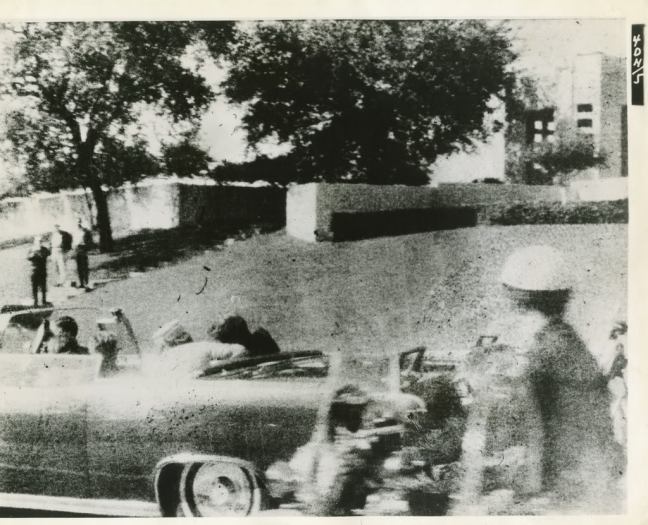
The following photo shows that a full-frame Moorman photo was distributed on the UPI wire on November 23, 1963.
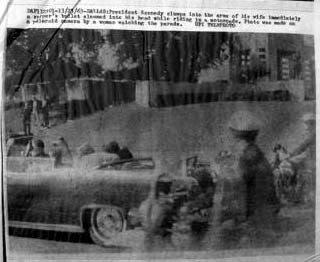
NBC –TV Copy
The Moorman Polaroid was only absent from the Press Room for a short time while being copied at the “Dallas Times-Herald”/UPI photo lab. It was returned promptly to Moorman and was in her possession for an interview with NBC that occurred around 1:00 PM. A shot of her Polaroid was part of that interview and became one of the first photos of the assassination to be seen nationally when it was broadcast at 3:19 PM (CST) on the NBC network.

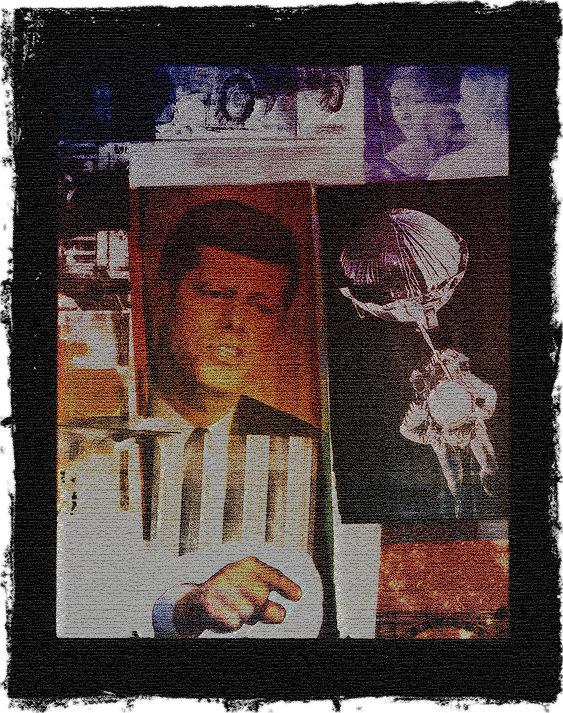
![CargoCollective.com]} FreeLanceGraphicsDesign](resources/%5B%21%5DJack%20Kennedy%20%5BAP%C2%BBPBS%7D%C2%BB%20A%20Century%20of%20Images%5D%5B811x813%5D%7DCraquelure%7DWrap%27d%27%7D%C2%BBPixlr%7DWorn%7DScrap%7D%C2%BB.jpg.opt811x813o0%2C0s811x813.jpg)
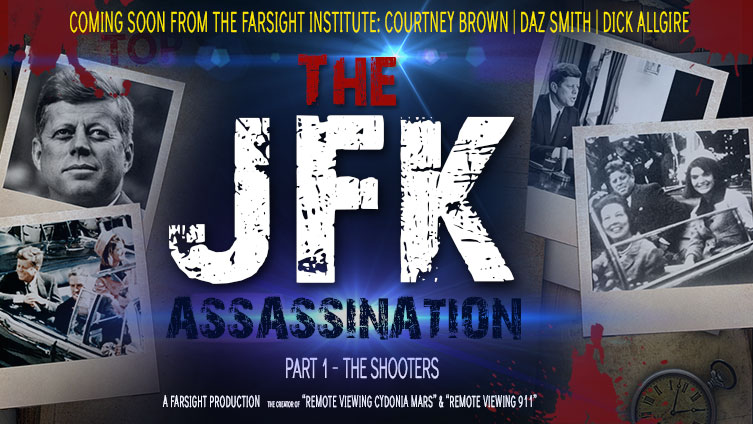
![Transistence Comics ... JFK [Farsight]](resources/JFKTransistence%20%5BFarsight%5D.jpg.opt924x637o0%2C0s924x637.jpg)
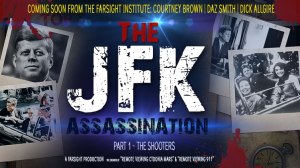
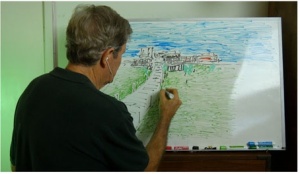
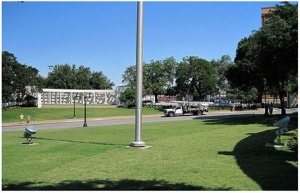
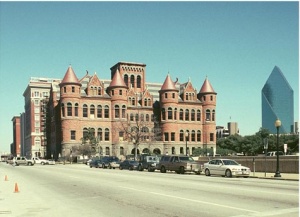
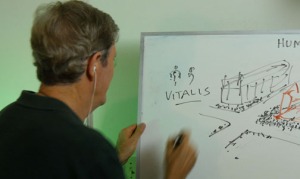
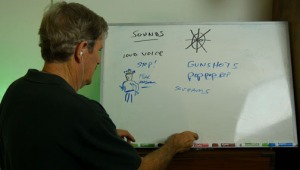
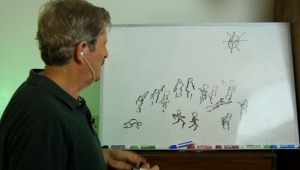
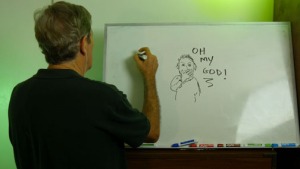
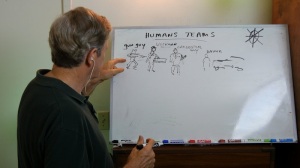
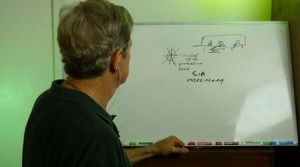
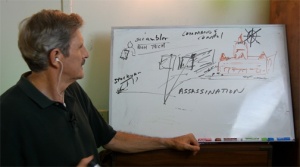
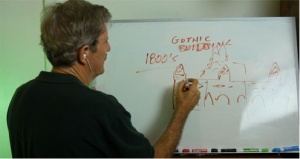
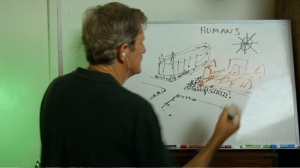




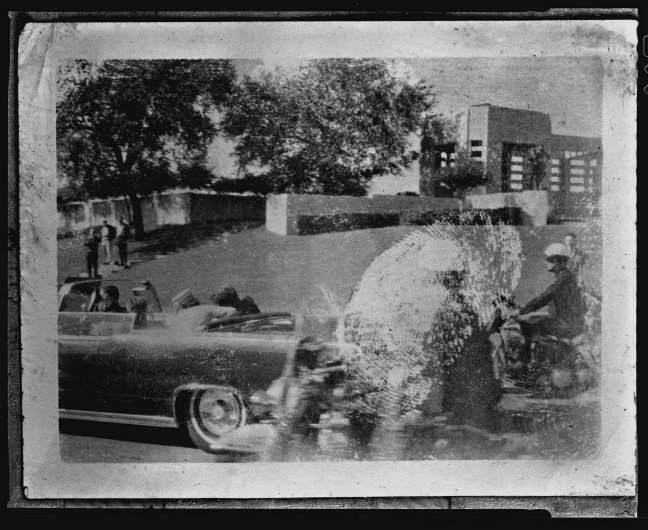
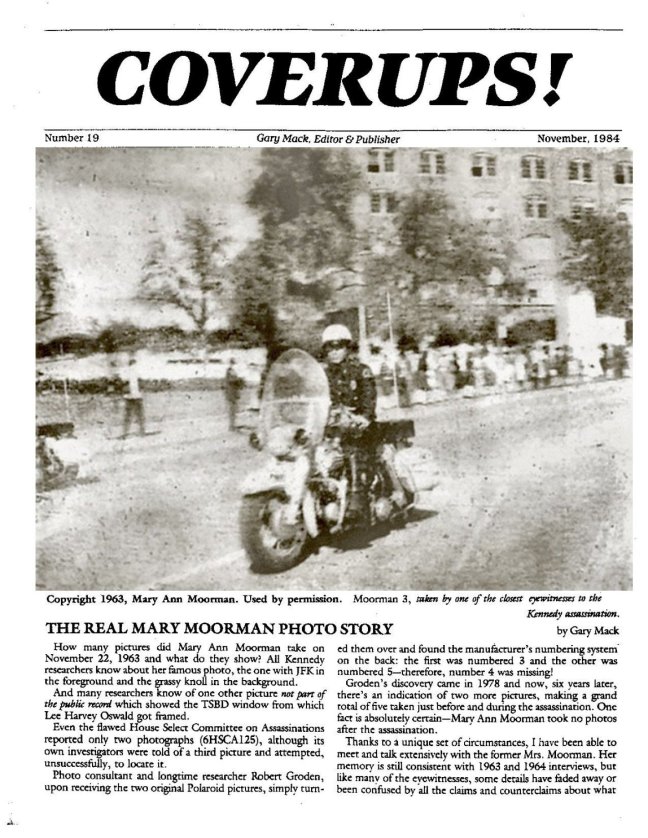

![Then][Mary Ann Moorman was rushed to a local newspaper office after a reporter saw she had taken a picture [634x403]](https://jfkrevelations.files.wordpress.com/2016/02/thenmary-ann-moorman-was-rushed-to-a-local-newspaper-office-after-a-reporter-saw-she-had-taken-a-picture-634x403.jpg?w=303&h=193&crop=1)
![Woman in the 'Blue Raincoat' ...Mary Moorman... who took that famous JFK Polaroid photo [NBCNewsLogo'd]](https://jfkrevelations.files.wordpress.com/2016/02/woman-in-the-blue-raincoat-mary-moorman-who-took-that-famous-jfk-polaroid-photo-nbcnewslogod.jpg?w=337&h=193&crop=1)
